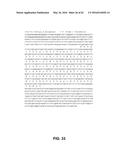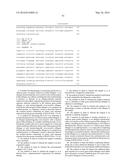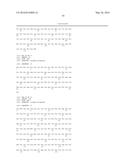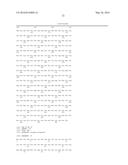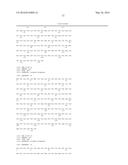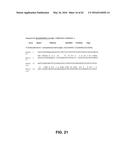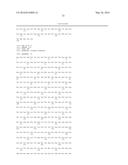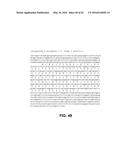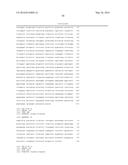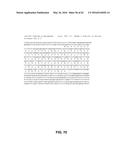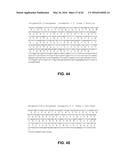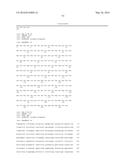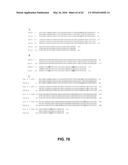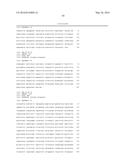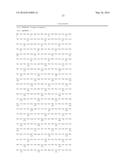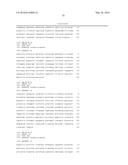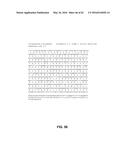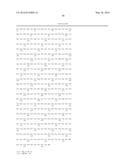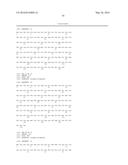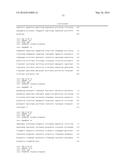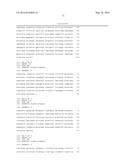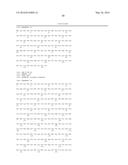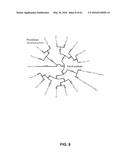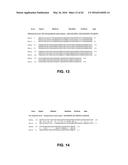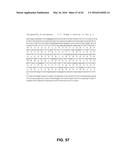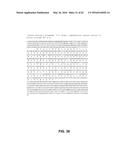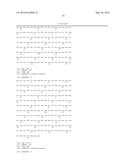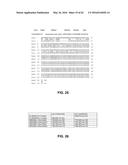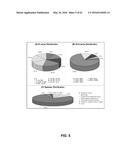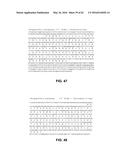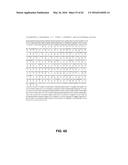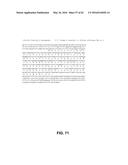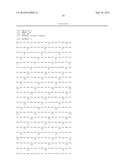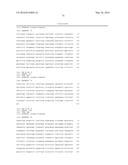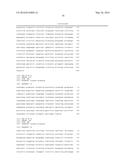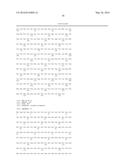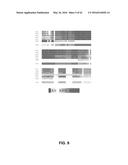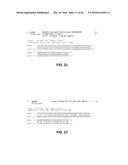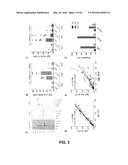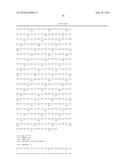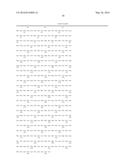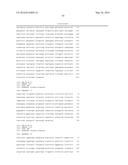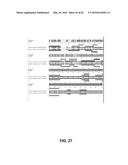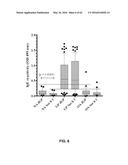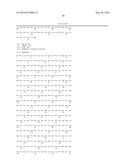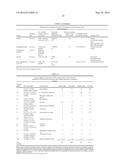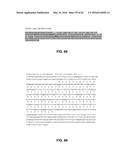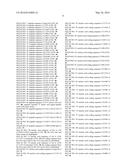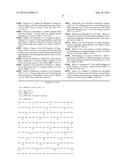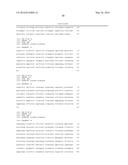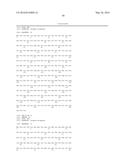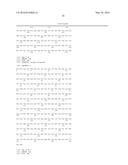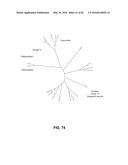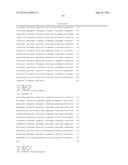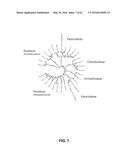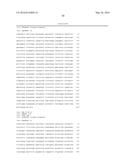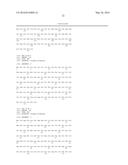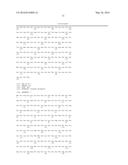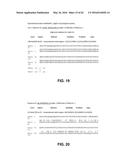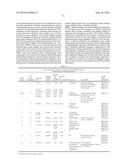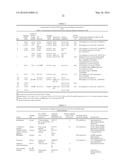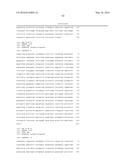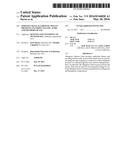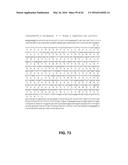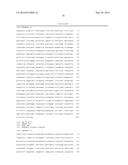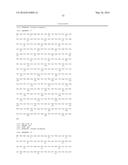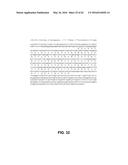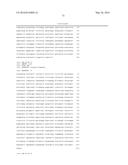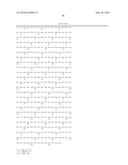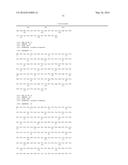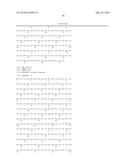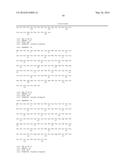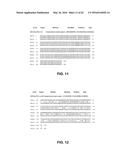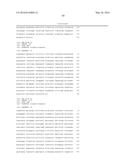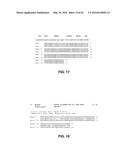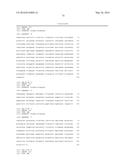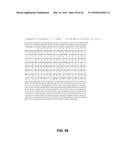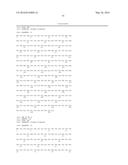Patent application title: JOHNSON GRASS ALLERGENIC POLLEN PROTEINS, ENCODING NUCLEIC ACIDS AND METHODS OF USE
Inventors:
Janet Davies (Kenmore, AU)
Bradley Campbell (St Lucia, AU)
Assignees:
QUEENSLAND UNIVERSITY OF TECHNOLOGY
IPC8 Class: AA61K3936FI
USPC Class:
4241851
Class name: Drug, bio-affecting and body treating compositions antigen, epitope, or other immunospecific immunoeffector (e.g., immunospecific vaccine, immunospecific stimulator of cell-mediated immunity, immunospecific tolerogen, immunospecific immunosuppressor, etc.) amino acid sequence disclosed in whole or in part; or conjugate, complex, or fusion protein or fusion polypeptide including the same
Publication date: 2016-05-26
Patent application number: 20160144020
Abstract:
Allergenic Johnson Grass proteins, antibodies thereto and encoding
nucleic acids are provided, which may be used for the diagnosis and/or
therapy of sensitivity to these allergenic proteins or to immunologically
cross-reactive allergenic proteins. In particular, the allergenic Johnson
grass proteins and nucleic acids may be used for environmental testing
for airborne allergens and/or for batch standardization of diagnostic and
therapeutic compositions.Claims:
1. A method for determining or monitoring sensitivity to a Johnson grass
(Sorghum halepense) pollen allergen, or an allergen immunologically
cross-reactive with a Johnson grass pollen allergen, in a subject,
including the step of determining a presence or absence of an
allergen-specific immune response in said subject, wherein the presence
of said immune response indicates sensitivity to the Johnson grass pollen
allergen or said immunologically cross-reactive allergen, wherein the
Johnson grass pollen allergen is or comprises an isolated protein, or a
fragment, variant or derivative thereof, the isolated protein comprising
an amino acid sequence selected from the group consisting of SEQ ID NOs:
1 to 49.
2. A method for measuring the level of or detecting or monitoring the presence of a Johnson grass pollen allergen, or an allergen immunologically cross-reactive with a Johnson grass pollen allergen, in a sample, including the step of contacting the sample with one or more reagents for a time and under conditions sufficient to detect said Johnson grass pollen allergen or said immunologically cross-reactive allergen, wherein the Johnson grass pollen allergen is or comprises an isolated protein, or a fragment, variant or derivative thereof, the isolated protein comprising an amino acid sequence selected from the group consisting of SEQ ID NOs: 1 to 49.
3. The method of claim 2, wherein the sample is obtained from a mammal.
4. The method of claim 2, wherein the sample is an environmental sample.
5. The method of claim 4, wherein the environmental sample is air or water.
6. The method of claim 2, wherein the sample is, or is derived from, a pharmaceutical composition for immunotherapy.
7. The method of claim 2, wherein the sample is, or is derived from, a diagnostic composition.
8. The method of claim 7, wherein the method is performed to batch standardize the diagnostic composition.
9. The method of claim 2, wherein the sample comprises one or a plurality of other grass pollen-derived allergens in addition to said allergen.
10. The method of claim 2, wherein the method is for determining a relative or absolute amount of the allergen in the sample.
11. The method of claim 2, wherein the reagent is an antibody or antibody fragment.
12. A method of preventing or treating sensitivity to a Johnson grass pollen allergen, or an allergen immunologically cross-reactive with a Johnson grass pollen allergen, in a subject, including the step of administering to said subject a therapeutically effective amount of a Johnson grass pollen allergen or an antibody thereto, or a composition comprising said therapeutically effective amount of a Johnson grass pollen allergen or an antibody thereto, wherein the Johnson grass pollen allergen is or comprises an isolated protein, or a fragment, variant or derivative thereof, the isolated protein comprising an amino acid sequence selected from the group consisting of SEQ ID NOs: 1 to 49.
13. The method of claim 12 further comprising administering one or more additional allergens or one or more antibodies that bind and/or are raised against additional allergens.
14. The method of claim 13 wherein the additional allergens include one or more grass pollen allergens from Bahia grass (Paspalum notatum), Bermuda grass (Cynodon dactylon) and/or Ryegrass (Lolium perenne).
15. The method of claim 12, wherein the therapeutically effective amount of the Johnson grass pollen allergen is administered subcutaneously.
16. The method of claim 12, wherein the therapeutically effective amount of the Johnson grass pollen allergen is administered sublingually.
17. The method of claim 12, wherein the antibody, or a fragment thereof, binds and/or is raised against an isolated protein, or a fragment, variant or derivative thereof, comprising an amino acid sequence selected from the group consisting of SEQ ID NOs: 1 to 49.
18-19. (canceled)
20. A composition comprising one or more of an isolated protein, or a fragment, variant or derivative thereof, comprising an amino acid sequence selected from the group consisting of SEQ ID NOs: 1 to 49 or one or more antibodies or antibody fragments that bind and/or are raised against said isolated protein, fragment, variant or derivative, and one or more pharmaceutically acceptable carriers, diluents or excipients.
21. The composition of claim 20, further comprising one or more additional allergens or one or more antibodies that bind and/or are raised against one or more additional allergens.
22. The composition of claim 21, wherein the additional allergens comprise one or more grass pollen allergens from Bahia grass (Paspalum notatum), Bermuda grass (Cynodon dactylon) and/or Ryegrass (Lolium perenne).
23-25. (canceled)
26. A genetic construct comprising: (i) an isolated nucleic acid molecule comprising a coding nucleotide sequence selected from the group consisting of SEQ ID NOs: 50 to 89, or a fragment, variant or derivative thereof; or (ii) a nucleotide sequence complementary thereto; operably linked or connected to one or more regulatory sequences in an expression vector.
27. A host cell transformed with an isolated nucleic acid molecule comprising a coding nucleotide sequence selected from the group consisting of SEQ ID NOs: 50 to 89, or a fragment, variant or derivative thereof, or the genetic construct of claim 26.
28. A method of producing an isolated protein comprising an amino acid sequence selected from the group consisting of SEQ ID NOs: 1 to 43, or a fragment, variant or derivative thereof, comprising; (i) culturing the previously transformed host cell of claim 27; and (ii) isolating said protein from said host cell cultured in step (i).
29. A diagnostic kit comprising: (i) one or more isolated proteins comprising an amino acid sequence selected from the group consisting of SEQ ID NOs: 1 to 49, or a fragment, variant or derivative thereof; and/or (ii) one or more antibodies, or a fragment thereof, that bind and/or are raised against an isolated protein, or a fragment, variant or derivative thereof, comprising an amino acid sequence selected from the group consisting of SEQ ID NOs: 1 to 49; and (iii) instructions for use.
30. The kit of claim 29, further comprising one or more additional environmental allergens and/or one or more additional antibodies that bind and/or were raised against an environmental allergen.
31. A method of determining the amino acid sequence of one or more grass pollen allergens, including the steps of: (i) preparing cDNA from RNA extracted from a grass pollen; (ii) determining the nucleotide sequence of said cDNA library; (iii) isolating allergenic proteins or fragments thereof from the corresponding grass pollen in (i); and (iv) determining the amino acid sequence of the isolated allergen proteins or fragments thereof from (iii).
32. The method of claim 31, further including the step of confirming the amino acid sequence of (iii) by aligning and comparing the predicted peptide sequence encoding the nucleotide sequence of (ii) with the amino acid sequence of (iii).
33. The method of claim 6, wherein the method is performed to batch standardize the pharmaceutical composition.
34. The method of claim 11, wherein the antibody or antibody fragment binds and/or is raised against an isolated protein, or a fragment, variant or derivative thereof, comprising an amino acid sequence selected from the group consisting of SEQ ID NOs: 1 to 49.
Description:
TECHNICAL FIELD
[0001] THIS INVENTION relates to grass pollen allergens. More particularly, this invention relates to isolated allergenic proteins and nucleic acids from the pollen of Johnson grass (Sorghum halepense) that may be useful in diagnosing, preventing and/or treating allergic rhinitis and environmental allergen detection.
BACKGROUND
[0002] Allergic Rhinitis (AR) has increased globally over several decades in both developed and developing nations placing a substantial economic burden on healthcare budgets (World Allergy Organization, White Book on Allergy, www.worldallergy.org). AR causes a negative effect on quality of life, work productivity, depression and anxiety levels of 500 million sufferers worldwide (Brozek et al., J Allergy Clin Immunol 2010; Bousquet et al., Int Arch Allergy Immunol, 2009; Katelaris et al., Clin Exp Allergy, 2012). In Australia, a nation of 23 million people, the direct and indirect cost of allergic disease was a staggering $7.8 billion in 2007 (Cook et al., Australia: Report by Access Economics, 2007). Likewise, in the United States, the direct costs of AR exceed $11 billion per annum (Meltzer and Bukstein, Ann Allergy Asthma Immunol, 2011). Airborne grass pollen levels also affect hospital admissions for asthma (Bauchau and Durham, Eur Respir J, 2004; Erbas et al., Clin Exp Allergy, 2007; Linneberg et al., Clin Exp Allergy, 2007).
[0003] The sources of grass pollen allergens vary according to climatic region and it is clear that subtropical grass pollens are clinically important in the subtropics (Phillips et al., Ann Allergy, 1989; White and Bernstein, Ann Allergy Asthma Immunol, 2003; Davies et al., Clin Transl Allergy, 2012). Until this time, most research has concentrated on the temperate grass species of Timothy grass and Ryegrass. Nonetheless, the contribution of subtropical grasses to allergic respiratory diseases of AR and asthma is predicted to increase with a rise in global temperatures due to anthropogenic climate change that may potentially augment the growth range for subtropical grass species (Morgan et al., Nature, 2011; Beggs and Bennett, Asia Pac J Public Health, 2011; Ziska and Caulfield, Aust J Plant Physiol, 2000). Current demographic data indicates that the population of subtropical climates is increasing in size (Gupta, Geology, 2002) and the tropical zones are widening polewards (Seidel et al., Nat Gosci, 2008). For instance, a conservative estimate of the population in subtropical states within the USA stands at ˜52.3 million, having increased by ˜18.3% since 2000 (US Census Bureau for FL, LA, MS, and TX). Changes in the distribution of the human population are concomitant with the exposure of the population to environmental factors restricted to such regions.
[0004] Tablets for sublingual immunotherapy (SLIT) for grass pollen allergy are derived from whole pollen extract exclusively from temperate grass species (Pooideae subfamily) (Bufe et al., J Allergy Clin Immunol, 2009; Didier et al., J Allergy Clin Immunol, 2007). Debate persists as to whether single or multiple allergenic extracts of temperate grass pollens endemic to regions of the northern hemisphere are sufficient to effectively tolerize allergic responses to all grass pollen allergens. Furthermore, emerging evidence indicates that sub-tropical pollen allergens show distinct immunological reactivity from temperate grass pollens (Weber, Ann Allergy Asthma Immunol, 2007; Weber, Curr Opin Allergy Clin Immunol, 2005). Allergenic molecules derived from subtropical grass species differ significantly in primary amino acid sequence and immunological reactivity (Davies et al., Allergy, 2005; Davies et al., Mol Immunol, 2008; Davies et al., Mol Immunol, 2011). The immunological relationship between temperate grass pollen allergens and subtropical grass pollens have been explored for Cynodon dactylon (Bermuda grass; Chloridoideae) (Weber, Ann Allergy Asthma Immunol, 2007; Weber, Curr Opin Allergy Clin Immunol, 2005) and Paspalum notatum (Bahia grass; Panicoideae) (Davies et al., Mol Immunol, 2011).
[0005] Johnson grass (Sorghum halepense) is a perennial weed distributed throughout the subtropics and tropics, in particular parts of Australia, Africa, Asia and the Americas (Davies et al., Clin Transl Allergy, 2012; Holm et al., The World's Worst Weeds, 1977; McWhorter, Rev Weed Science, 1989). We have previously shown that 77% of patients with allergic rhinitis from a subtropical region of Queensland demonstrate a positive skin prick test (SPT) response to JGP (Davies et al., Clin Exp Allergy, 2011). Thus far, the sequence of the group 1 allergen of JGP, Sor h 1 has been described and shown to react with group 1-specific monoclonal antibodies (Avjioglu et al., Molecular Biology and Immunology of Allergens, 1993).
[0006] The allergenic proteins and their encoding nucleic acid from the pollen of Johnson grass (Sorghum halepense), a wind pollinated perennial grass found worldwide and considered a major weed and significant source of allergenicity in the subtropics including parts of Australia, Africa, Asia and the Americas, remain largely undefined.
SUMMARY
[0007] The invention is broadly directed to allergenic proteins and encoding isolated nucleic acids from the pollen of Sorghum halepense (Johnson grass) and/or their use in diagnosing, preventing and/or treating allergic rhinitis.
[0008] In a first aspect, the invention provides a method for determining or monitoring sensitivity to a Johnson grass (Sorghum halepense) pollen allergen, or an allergen immunologically cross-reactive with a Johnson grass pollen allergen, in a subject, including the step of determining a presence or absence of an allergen-specific immune response in said subject, wherein the presence of said immune response indicates sensitivity to the Johnson grass pollen allergen or the allergen which is immunologically cross-reactive to the Johnson grass pollen antigen.
[0009] Suitably, sensitivity to the Johnson grass pollen allergen and/or the immunologically cross-reactive antigen is associated with an allergic condition.
[0010] Preferably, the allergic condition is allergic rhinitis, allergic dermatitis or allergic asthma.
[0011] In one embodiment, the subject is a human.
[0012] In a second aspect, the invention provides a method for measuring the level of, or detecting or monitoring the presence of a Johnson grass pollen allergen, or an allergen immunologically cross-reactive with a Johnson grass pollen allergen, in a sample, including the step of contacting the sample with one or more reagents for a time and under conditions sufficient to detect said Johnson grass allergen or said immunologically cross-reactive antigen.
[0013] In particular embodiments, the one or more reagents comprise an antibody or fragment thereof.
[0014] In one embodiment, the sample is obtained from a mammal, such as a human.
[0015] In one embodiment, the sample is an environmental sample. Preferably, the environmental sample is air or water.
[0016] In certain embodiments, the sample is, or is derived from, either a composition for immunotherapy or a diagnostic composition. In an embodiment, the method of this aspect is performed to batch standardize the pharmaceutical composition or the diagnostic composition.
[0017] In one embodiment, the sample comprises one or a plurality of other grass pollen-derived allergens in addition to said allergen.
[0018] In one embodiment, the method of this aspect is for determining a relative or absolute amount of the allergen in the sample
[0019] In a third aspect, the invention provides a method of preventing or treating sensitivity to a Johnson grass pollen allergen, or an allergen immunologically cross-reactive with a Johnson grass pollen allergen, in a subject, including the step of administering to said subject a composition comprising a therapeutically effective amount of a Johnson grass pollen allergen or an antibody thereto.
[0020] In one embodiment, the subject is a human.
[0021] In another embodiment, the therapeutically effective amount of the Johnson grass pollen allergen is administered subcutaneously.
[0022] In a further embodiment, the therapeutically effective amount of the Johnson grass pollen allergen is administered sublingually.
[0023] Suitably, according to the first, second and third aspects, the Johnson grass pollen allergen is or comprises an isolated allergenic protein.
[0024] In particular embodiments, the isolated allergenic protein comprises, consists of or consists essentially of an amino acid sequence set forth in SEQ ID NO: 1, SEQ ID NO: 2, SEQ ID NO: 3, SEQ ID NO: 4, SEQ ID NO: 5, SEQ ID NO: 6, SEQ ID NO: 7, SEQ ID NO: 8, SEQ ID NO: 9, SEQ ID NO: 10, SEQ ID NO: 11, SEQ ID NO: 12, SEQ ID NO: 13, SEQ ID NO: 14, SEQ ID NO: 15, SEQ ID NO: 16, SEQ ID NO: 17, SEQ ID NO: 18, SEQ ID NO: 19, SEQ ID NO: 20, SEQ ID NO: 21, SEQ ID NO: 22, SEQ ID NO: 23, SEQ ID NO: 24, SEQ ID NO: 25, SEQ ID NO: 26, SEQ ID NO: 27, SEQ ID NO: 28, SEQ ID NO: 29, SEQ ID NO: 30, SEQ ID NO: 31, SEQ ID NO: 32, SEQ ID NO: 33, SEQ ID NO: 34, SEQ ID NO: 35, SEQ ID NO: 36, SEQ ID NO: 37, SEQ ID NO: 38, SEQ ID NO: 39, SEQ ID NO: 40, SEQ ID NO: 41, SEQ ID NO: 42, SEQ ID NO: 43, SEQ ID NO: 44, SEQ ID NO: 45, SEQ ID NO: 46, SEQ ID NO: 47, SEQ ID NO: 48 or SEQ ID NO: 49.
[0025] These aspects also include fragments, variants and derivatives of said isolated protein.
[0026] In a fourth aspect, the invention provides an isolated protein which comprises, consists of, or consists essentially of an amino acid sequence set forth in SEQ ID NO: 1, SEQ ID NO: 2, SEQ ID NO: 3, SEQ ID NO: 4, SEQ ID NO: 5, SEQ ID NO: 6, SEQ ID NO: 7, SEQ ID NO: 8, SEQ ID NO: 9, SEQ ID NO: 10, SEQ ID NO: 11, SEQ ID NO: 12, SEQ ID NO: 13, SEQ ID NO: 14, SEQ ID NO: 15, SEQ ID NO: 16, SEQ ID NO: 17, SEQ ID NO: 18, SEQ ID NO: 19, SEQ ID NO: 20, SEQ ID NO: 21, SEQ ID NO: 22, SEQ ID NO: 23, SEQ ID NO: 24, SEQ ID NO: 25, SEQ ID NO: 26, SEQ ID NO: 27, SEQ ID NO: 28, SEQ ID NO: 29, SEQ ID NO: 30, SEQ ID NO: 31, SEQ ID NO: 32, SEQ ID NO: 33, SEQ ID NO: 34, SEQ ID NO: 35, SEQ ID NO: 36, SEQ ID NO: 37, SEQ ID NO: 38, SEQ ID NO: 39, SEQ ID NO: 40, SEQ ID NO: 41, SEQ ID NO: 42 or SEQ ID NO: 43.
[0027] This aspect also includes fragments, variants and derivatives of said isolated protein.
[0028] In a fifth aspect, the invention provides an antibody or antibody fragment which binds and/or is raised against the isolated protein of the fourth aspect.
[0029] The antibody may be a monoclonal antibody or a polyclonal antibody.
[0030] In another embodiment, the antibody is a recombinant antibody or antibody fragment.
[0031] In a sixth aspect, the invention provides a composition comprising an isolated protein, fragment, variant or derivative, wherein the isolated protein comprises an amino acid sequence according to any one of SEQ ID NOs:1-49 or an antibody that binds or is raised against said isolated protein, fragment, variant or derivative.
[0032] Preferably, the antibody or antibody fragment is according to the fifth aspect.
[0033] In one embodiment, the composition further comprises one or more additional environmental allergens.
[0034] In particular embodiments, the composition further comprises one or more grass pollen allergens from Bahia grass (Paspalum notatum), Bermuda grass (Cynodon dactyln) and/or Ryegrass (Lolium perenne), or one or more antibodies thereto.
[0035] In one embodiment, the composition further comprises one or more pharmaceutically acceptable carriers, diluents or excipients.
[0036] In another embodiment, the composition is a diagnostic composition.
[0037] In a seventh aspect, the invention provides an isolated nucleic acid comprising a nucleotide sequence which encodes, or is complementary to a nucleotide sequence which encodes, the isolated protein of the fourth aspect.
[0038] In particular embodiments, the isolated nucleic acid comprises, consists of or consists essentially of a nucleotide sequence set forth in SEQ ID NO: 50, SEQ ID NO: 51, SEQ ID NO: 52, SEQ ID NO: 53, SEQ ID NO: 54, SEQ ID NO: 55, SEQ ID NO: 56, SEQ ID NO: 57, SEQ ID NO: 58, SEQ ID NO: 59, SEQ ID NO: 60, SEQ ID NO: 61, SEQ ID NO: 62, SEQ ID NO: 63, SEQ ID NO: 64, SEQ ID NO: 65, SEQ ID NO: 66, SEQ ID NO: 67, SEQ ID NO: 68, SEQ ID NO: 69, SEQ ID NO: 70, SEQ ID NO: 71, SEQ ID NO: 72, SEQ ID NO: 73, SEQ ID NO: 74, SEQ ID NO: 75, SEQ ID NO: 76, SEQ ID NO: 77, SEQ ID NO: 78, SEQ ID NO: 79, SEQ ID NO: 80, SEQ ID NO: 81, SEQ ID NO: 82, SEQ ID NO: 83, SEQ ID NO: 84, SEQ ID NO: 85, SEQ ID NO: 86, SEQ ID NO: 87, SEQ ID NO: 88 or SEQ ID NO: 89.
[0039] This aspect also includes fragments, variants and derivatives of said isolated nucleic acid.
[0040] In an eighth aspect, the invention provides a genetic construct comprising: (i) the isolated nucleic acid of the seventh aspect; or (ii) an isolated nucleic acid comprising a nucleotide sequence complementary thereto; operably linked or connected to one or more regulatory sequences in an expression vector.
[0041] In a ninth aspect, the invention provides a host cell transformed with a nucleic acid molecule of the seventh aspect or the genetic construct of eighth aspect.
[0042] In a tenth aspect, the invention provides a method of producing the recombinant protein of the fourth aspect, comprising; (i) culturing the previously transformed host cell of the ninth aspect; and (ii) isolating said protein from said host cell cultured in step (i).
[0043] In an eleventh aspect, the invention provides a diagnostic and/or screening kit comprising: (i) one or more of the isolated proteins of the aforementioned aspects and/or one or more antibodies that bind or are raised against the proteins; and (ii) instructions for use.
[0044] In one embodiment, the kit further comprises one or more additional environmental allergens or antibodies raised against one or more additional environmental allergens.
[0045] In a twelfth aspect, the invention provides a method of determining the amino acid sequence of a grass pollen allergen, including the steps of: (i) preparing cDNA from RNA extracted from a grass pollen; (ii) determining the nucleotide sequence of said cDNA library; (iii) isolating allergenic proteins or fragments thereof from the corresponding grass pollen in (i); (iv) determining the amino acid sequence of the isolated allergen proteins or fragments thereof from (iii).
[0046] Preferably, the method further comprises extracting RNA from a grass pollen and preparing an RNA fragment library from said RNA.
[0047] Preferably, the method further includes the step of confirming the amino acid sequence of (iii) by aligning and comparing the predicted peptide sequence encoding the nucleotide sequence of (ii) with the amino acid sequence of (iii).
[0048] Throughout this specification, unless the context requires otherwise, the words "comprise", "comprises" and "comprising" will be understood to imply the inclusion of a stated integer or group of integers but not the exclusion of any other integer or group of integers.
BRIEF DESCRIPTION OF THE FIGURES
[0049] FIG. 1. Allergic sensitivity to JGP allergens. (A) Skin prick test of non-atopic subjects (n=19), patients with grass pollen allergy (n=48), and allergies other than grass pollen (n=24). (individual data with median and IQR, cut-off line at 3 mm). (B) Serum IgE immunoblots of JGP. (Molecular weights in kDa, arrows designate major allergen components).
[0050] FIG. 2. Identification of JGP allergenic components. (A) 2D gel electrophoresis of JGP stained with Coomassie Blue. 2D IgE immunoblots of JGP probed with (B) a JGP-allergic patient serum pool (patients from FIG. 1B, arrows mark IgE-reactive components; replica immunoblot with pool of non-atopic sera from FIG. 1B showed no IgE reactivity, not shown), and (C, D) specific mAb (Sor h 1 and Sor h 13 isoforms marked).
[0051] FIG. 3. Serum IgE reactivity with Sor h 1 and Sor h 13. IgE reactivity with each allergen normalized to nonatopic donors. (Box; median and IQR, and whiskers; 10th-90th percentiles). The cut off of three SD above the mean of 23 non-atopic subjects in (A) for JGP (OD=0.410) and Sor h 1 (OD=0.229) and (B) for JGP (OD=0.371) and Sor h 13 (OD=0.384). P values by Mann Whitney U test. Correlation between IgE reactivity with JGP and Sor h 1 (C) and Sor h 13 (D). (Spearman's correlation and CI given). (E) Frequency of IgE reactivity with JGP, Sor h 1 and Sor h 13. (F) Purified JGP allergens stained with Coomassie blue and immunoblotted with mAb specific to group 1 and group 13 allergens (marked).
[0052] FIG. 4. Johnson grass pollen transcriptome assembly analysis. (A) Output results for raw and clean reads of Johnson grass pollen transcriptome sequencing. (B) Output for assembly quality of the transcriptome. (C) Unigenes were annotated with the databases of NR, NT, SwissProt, KEGG, COG and GO.
[0053] FIG. 5. Non-Redundant database classification of the Johnson grass pollen transcriptome. (A) BLAST E-value distribution; (B) Identity distribution; and (C) Species distribution of homologous sequence matches. NR database (http://www.ncbi.nlm.nih.gov/).
[0054] FIG. 6. IgE reactivity with Sor h 1 as non-normalized data. Serum IgE responses shown as Optical Density Units. Cut off for positive test response of three standard deviations above the mean of 19 non-atopic donors for each allergen preparation is marked. P value by Wilcoxon signed rank test for paired data.
[0055] FIG. 7. Alignment of group 1 allergen sequences including Sor h 1.01A (CL153) and Sor h 1.02B (UG493-492) to other known grass pollen group 1 allergens. Allergens cluster according to subfamily. Sequences of subtropical grass families Panicoideae (maize pollen; Zea m 1, Bahia grass pollen; Pas n 1, and Johnson grass Sor h 1), Ehrhartoideae (rice Ory s 1) and Chloridoideae (Bermuda grass; Cyn d 1) align in separate clades distant to the Pooideae temperate grass pollens (Ryegrass; Lol p 1, Timothy grass pollen; Phl p 1, Brachypodium sp; Bra di 1, Bra sy 1, Canary grass; Pha a 1, Orchard grass; Dac g 1, Rye; Sec c 1, Kentucky Blue grass; Poa p 1, Velvet grass; Hol l 1, meadow ryegrass; Fes p and Barley pollen; Hor v 13)
[0056] FIG. 8. Alignment of group 13 allergen sequences showing Panicoideae sequences (maize pollen; Zea m 13, Bahia grass pollen; Pas n 13 and Johnson grass pollen; Sor h 13) in separate clade to Pooideae group 13 allergens (Timothy grass pollen; Phl p 13, Brachypodium distachyon; Bra di 13 and Barley pollen; Hor v 13).
[0057] FIG. 9. TCoffee alignment of Sor h 23 (CL2015.1) predicted peptide with group 5 allergens reveals a shared domain not previously identified in any subtropical grass pollen. Phl; Phleum pratensis timothy grass pollen Phl p 5, Poa; Poa pratense Poa p 5, Dac; orchard grass Dactylis glomerata Dac g 5, Lol; Lolium perenne ryegrass Lol p 5, Cyn; Cynodon dactylon Cyn d 23. Bad avg good colour scale represents degree of similarity.
[0058] FIG. 10. Coverage of observed peptide spectra of IgE--reactive protein spots excised from 2D gels for spots for CL 153.1 Spot 1 (pI 6.8/30 kDa, blue), 2 (pI 7.1/30 kDa, yellow) and 3 (pI 10.5/30 kDa, green). Spot 1 shows 78% coverage of amino acids across the mature peptide sequence.
[0059] FIG. 11. Alignment of Sor h 1.02B to closest match in BLAST search: XP_002467539 (Sorghum bicolor). Alignment of Sor h 1.02B with the S. bicolor XP_002467539 verifies the validity of the sequences as a complete coding transcript arising from a single gene locus.
[0060] FIG. 12. Alignment of Sor h 1.0A (CL153.1) and Sor h 1.02B (UG493-492) peptides. The relatively lower than expected amino acid percentage identity (57%) and similarity (73%) between CL153 and UG493-492 suggests these transcripts are encoded by separate gene loci. The genetic loci encode beta expansin allergens Sor h 1.01A and Sor h 1.02B with different biochemical characteristics. These are likely to confer different immunological properties and may elicit distinct B and T cell responses from patients with grass pollen allergy. These separate allergen isoforms are likely to contain some shared as well as distinct B and T cell epitopes.
[0061] FIG. 13. Alignment of CL2015.1 (Sor h 23) to closest match in BLAST search; hypothetical protein XP 002446575.1 (Sorghum bicolor).
[0062] FIG. 14. Alignment of CL2015.1 (Sor h 23) to pollen allergen Cyn d 23 (Cynodon dactylon).
[0063] FIG. 15. Coverage of observed peptide spectra of IgE-reactive protein spots excised from 2D gels for spot four with CL2015.1 (Sor h 23). The spectra observed cover 66% of the CL2015.1 sequence verifying the presence of this sequence as that encoding the IgE reactive spot.
[0064] FIG. 16. Coverage of observed peptide spectra of IgE-reactive protein spots excised from 2D gels for spot five with CL2015.1 (Sor h 23). The spectra observed cover 73% of the CL2015.1 sequence verifying the presence of this sequence as that encoding the IgE reactive spot.
[0065] FIG. 17. Alignment of UG388 encoding spot 6 with closest match identified by database search. This sequence has no history of association with allergy.
[0066] FIG. 18. Alignment of CL1122.1 (Sor h 2.01) with sequence of maize with homology to group 2 allergen of timothy grass pollen.
[0067] FIG. 19. Alignment of CL1122.2 (Sor h 2.03) with closest database match verifying its sequence from S. bicolor.
[0068] FIG. 20. Alignment of CL1122.2 (Sor h 2.03) with group 3 pollen allergen (Zea mays).
[0069] FIG. 21. Alignment of CL1122.2 (Sor h 2.03) with putative group 3 pollen allergen (Oryza sativa Japonica Group).
[0070] FIG. 22. Alignment of CL 1695 (Sor h 2.02) peptide with closest database match of S. bicolor verifying its existence.
[0071] FIG. 23. Alignment of CL 1695 (Sor h 2.02) peptide with group 2 homolog in maize.
[0072] FIG. 24. Coverage of observed peptide spectra of spots 7 and 8 with predicted peptides of closest matches to CL1122.1 (Sor h 2.01) and CL 1695 (Sor h 2.02). Data confirms presence of these IgE reactive allergens within the proteome and transcriptome of JGP.
[0073] FIG. 25. Sequence alignment of CL1737.1 (Sor h 13.01A) and CL1737.2 (Sor h 13.01B).
[0074] FIG. 26. Sequence identity percentages for the closest protein and Pas n 13 allergen matches of CL737.1 (Sor h 13.01A) and CL1737.2 (Sor h 13.01B).
[0075] FIG. 27. Coverage of peptide spectra for mass spec of purified Sor h 13 A and Sor h 13 B aligned to CL1737.1 and CL1737.2. These are two previously undescribed unique transcripts that encode isoforms of Sor h 13. Both are represented within peptides in the proteome of JGP.
[0076] FIG. 28. Nucleotide sequence for Sor h 1.028 transcript. Both coding and untranslated sequence is provided. Nucleotide sequences and predicted peptide sequence for concatenation of Unigene 493 reverse complement to Unigene 492 minus the eight nucleotide overlap are provided. ATG start and Stop codons shown in yellow and red respectively. Signal peptide has been underlined.
[0077] FIG. 29. Nucleotide sequence for Sor h 13.01A (CL1737.1) transcript. Both coding and untranslated sequence is provided. Translated region and predicted amino acid sequence are given. Signal peptide junction shown by arrow.
[0078] FIG. 30. Nucleotide sequence for Sor h 13.01B (CL1737.2) transcript. Both coding and untranslated sequence is provided. Translated region and predicted amino acid sequence are given. Signal peptide junction shown by arrow.
[0079] FIG. 31. Nucleotide sequence for CL110 transcript. Both coding and untranslated sequence is provided. Translated region and predicted amino acid sequence are given.
[0080] FIG. 32. Nucleotide sequence for CL1152 transcript. Both coding and untranslated sequence is provided. Translated region and predicted amino acid sequence are given.
[0081] FIG. 33. Nucleotide sequence for CL1715 transcript. Both coding and untranslated sequence is provided. Translated region and predicted amino acid sequence are given.
[0082] FIG. 34. Nucleotide sequence for CL1444 transcript. Both coding and untranslated sequence is provided. Translated region and predicted amino acid sequence are given.
[0083] FIG. 35. Nucleotide sequence for CL1754 transcript. Both coding and untranslated sequence is provided. Translated region and predicted amino acid sequence ar given.
[0084] FIG. 36. Nucleotide sequence for CL200 transcript. Both coding and untranslated sequence is provided. Translated region and predicted amino acid sequence are given.
[0085] FIG. 37. Nucleotide sequence for CL2015.2 transcript. Both coding and untranslated sequence is provided. Translated region and predicted amino acid sequence are given.
[0086] FIG. 38. Nucleotide sequence for CL2052 transcript. Both coding and untranslated sequence is provided. Translated region and predicted amino acid sequence are given.
[0087] FIG. 39. Nucleotide sequence for CL248 transcript. Both coding and untranslated sequence is provided. Translated region and predicted amino acid sequence are given.
[0088] FIG. 40. Nucleotide sequence for CL70 transcript. Both coding and untranslated sequence is provided. Translated region and predicted amino acid sequence are given.
[0089] FIG. 41. Nucleotide sequence for CL830 transcript. Both coding and untranslated sequence is provided. Translated region and predicted amino acid sequence are given.
[0090] FIG. 42. Nucleotide sequence for CL962 transcript. Both coding and untranslated sequence is provided. Translated region and predicted amino acid sequence are given.
[0091] FIG. 43. Nucleotide sequence for CL986 transcript. Both coding and untranslated sequence is provided. Translated region and predicted amino acid sequence are given.
[0092] FIG. 44. Nucleotide sequence for UG1043 transcript. Both coding and untranslated sequence is provided. Translated region and predicted amino acid sequence are given.
[0093] FIG. 45. Nucleotide sequence for UG11756 transcript. Both coding and untranslated sequence is provided. Translated region and predicted amino acid sequence are given.
[0094] FIG. 46. Nucleotide sequence for UG1334 transcript. Both coding and untranslated sequence is provided. Translated region and predicted amino acid sequence are given.
[0095] FIG. 47. Nucleotide sequence for UG1403 transcript. Both coding and untranslated sequence is provided. Translated region and predicted amino acid sequence are given.
[0096] FIG. 48. Nucleotide sequence for UG2745 transcript. Both coding and untranslated sequence is provided. Translated region and predicted amino acid sequence are given.
[0097] FIG. 49. Nucleotide sequence for UG308 transcript. Both coding and untranslated sequence is provided. Translated region and predicted amino acid sequence are given.
[0098] FIG. 50. Nucleotide sequence for UG332 transcript. Both coding and untranslated sequence is provided. Translated region and predicted amino acid sequence are given.
[0099] FIG. 51. Nucleotide sequence for UG335 transcript. Both coding and untranslated sequence is provided. Translated region and predicted amino acid sequence are given.
[0100] FIG. 52. Nucleotide sequence for UG342 transcript. Both coding and untranslated sequence is provided. Translated region and predicted amino acid sequence are given.
[0101] FIG. 53. Nucleotide sequence for UG397 transcript. Both coding and untranslated sequence is provided. Translated region and predicted amino acid sequence are given.
[0102] FIG. 54. Nucleotide sequence for UG41 transcript. Both coding and untranslated sequence is provided. Translated region and predicted amino acid sequence are given.
[0103] FIG. 55. Nucleotide sequence for UG540 transcript. Both coding and untranslated sequence is provided. Translated region and predicted amino acid sequence are given.
[0104] FIG. 56. Nucleotide sequence for UG5446 transcript. Both coding and untranslated sequence is provided. Translated region and predicted amino acid sequence are given.
[0105] FIG. 57. Nucleotide sequence for UG551 transcript. Both coding and untranslated sequence is provided. Translated region and predicted amino acid sequence are given.
[0106] FIG. 58. Nucleotide sequence for UG552 transcript. Both coding and untranslated sequence is provided. Translated region and predicted amino acid sequence are given.
[0107] FIG. 59. Nucleotide sequence for UG578 transcript. Both coding and untranslated sequence is provided. Translated region and predicted amino acid sequence are given.
[0108] FIG. 60. Nucleotide sequence for UG6038 transcript. Both coding and untranslated sequence is provided. Translated region and predicted amino acid sequence are given.
[0109] FIG. 61. Nucleotide sequence for UG681 transcript. Both coding and untranslated sequence is provided. Translated region and predicted amino acid sequence are given.
[0110] FIG. 62. Nucleotide sequence for UG6635 transcript. Both coding and untranslated sequence is provided. Translated region and predicted amino acid sequence are given.
[0111] FIG. 63. Nucleotide sequence for UG7876 transcript. Both coding and untranslated sequence is provided. Translated region and predicted amino acid sequence are given.
[0112] FIG. 64. Nucleotide sequence for UG808 transcript. Both coding and untranslated sequence is provided. Translated region and predicted amino acid sequence are given.
[0113] FIG. 65. Nucleotide sequence for UG832 transcript. Both coding and untranslated sequence is provided. Translated region and predicted amino acid sequence are given.
[0114] FIG. 66. Nucleotide sequence for UG8760 transcript. Both coding and untranslated sequence is provided. Translated region and predicted amino acid sequence are given.
[0115] FIG. 67. Nucleotide sequence for UG9701 transcript. Both coding and untranslated sequence is provided. Translated region and predicted amino acid sequence are given.
[0116] FIG. 68. Amino acid sequence for CL153 (Sor h 1.01A) transcript. Sequence for both the signal peptide (27 amino acids) and the mature peptide (239 amino acids) is provided.
[0117] FIG. 69. Nucleotide sequence for Contig1122.1 (Sor h 2.01) transcript. Both coding and untranslated sequence is provided. Translated region and predicted amino acid sequence are given.
[0118] FIG. 70. Nucleotide sequence for Contig1695 (Sor h 2.02) transcript. Both coding and untranslated sequence is provided. Translated region and predicted amino acid sequence are given.
[0119] FIG. 71. Nucleotide sequence for Contig1122.2 (Sor h 2.03) transcript. Both coding and untranslated sequence is provided. Translated region and predicted amino acid sequence are given.
[0120] FIG. 72. Nucleotide sequence for Contig2015.1 (Sor h 23) transcript. Both coding and untranslated sequence is provided. Translated region and predicted amino acid sequence are given.
[0121] FIG. 73. Nucleotide sequence for UG388 (spot 6) transcript. Both coding and untranslated sequence is provided. Translated region and predicted amino acid sequence are given.
[0122] FIG. 74. Alignment of group 2 allergen sequences including Sor h 2.03. This shows that all of the group 2 allergens of Johnson grass pollen (Sor h 2.01, Sor h 2.02 and Sor h 2.03) align with the group 2 allergens rather than group 3 allergens.
[0123] FIG. 75. Alignment of group 23 allergen sequences of subtropical grasses with group 5 allergen sequences of the temperate grasses.
[0124] FIG. 76. Concatenation of the sequence of UG492 and UG493. A. Match identified between UG493 to an unidentified sequence XP_002467539.1 (sbjct). B. Match identified between UG492-1 to the same hypothetical protein XP_002467539.1 (sbjct). C. Alignment of Sor h 1.02B, deduced by concatenation of amino acids 1 to 158 of UG493 to amino acids 3 to 109 of UG 492.1, with the S. bicolor sequence XP 002467539.
BRIEF DESCRIPTION OF THE SEQUENCES
[0125] SEQ ID NO: 1=peptide sequence Sor h 1.02B of FIG. 28; sequence includes 24 amino acid signal peptide (total=266 amino acids) SEQ ID NO: 2=peptide sequence Sor h 1.02B (mature peptide) of FIG. 28; sequence excludes 24 amino acid signal peptide (total=242 amino acids) SEQ ID NO: 3=peptide sequence CL1737.1 (Sor h 13.01) of FIG. 29; sequence includes 23 amino acid signal peptide (total=422 amino acids) SEQ ID NO: 4=peptide sequence CL1737.1 (Sor h 13.01, mature peptide) of FIG. 29; sequence excludes 23 amino acid signal peptide (total=399 amino acids) SEQ ID NO: 5=peptide sequence CL1737.2 (Sor h 13.02) of FIG. 30; sequence includes 22 amino acid signal peptide (total=410 amino acids) SEQ ID NO: 6=peptide sequence CL1737.2 (Sor h 13.02, mature peptide) of FIG. 30; sequence excludes 22 amino acid signal peptide (total=388 amino acids) SEQ ID NO: 7=peptide sequence Contig110 of FIG. 31 SEQ ID NO: 8=peptide sequence CL1152 of FIG. 32 SEQ ID NO: 9=peptide sequence CL1715 of FIG. 33 SEQ ID NO: 10=peptide sequence CL1444 of FIG. 34 SEQ ID NO: 11=peptide sequence CL1754 of FIG. 35 SEQ ID NO: 12=peptide sequence CL200 of FIG. 36 SEQ ID NO: 13=peptide sequence CL2015.2 of FIG. 37 SEQ ID NO: 14=peptide sequence CL2052 of FIG. 38 SEQ ID NO: 15=peptide sequence CL248 of FIG. 39 SEQ ID NO: 16=peptide sequence CL70 of FIG. 40 SEQ ID NO: 17 w peptide sequence CL830 of FIG. 41 SEQ ID NO: 18=peptide sequence CL962 of FIG. 42 SEQ ID NO: 19=peptide sequence CL986 of FIG. 43 SEQ ID NO: 20=peptide sequence UG1043 of FIG. 44 SEQ ID NO: 21=peptide sequence UG11756 of FIG. 45 SEQ ID NO: 22=peptide sequence UG1334 of FIG. 46 SEQ ID NO: 23=peptide sequence UG01403 of FIG. 47 SEQ ID NO: 24=peptide sequence UG2745 of FIG. 48 SEQ ID NO: 25=peptide sequence UG308 of FIG. 49 SEQ ID NO: 26=peptide sequence UG332 of FIG. 50 SEQ ID NO: 27=peptide sequence UG335 of FIG. 51 SEQ ID NO: 28=peptide sequence UG342 of FIG. 52 SEQ ID NO: 29=peptide sequence UG397 of FIG. 53 SEQ ID NO: 30=peptide sequence UG451 of FIG. 54 SEQ ID NO: 31=peptide sequence UG540 of FIG. 55 SEQ ID NO: 32=peptide sequence UG5446 of FIG. 56 SEQ ID NO: 33=peptide sequence UG551 of FIG. 57 SEQ ID NO: 34=peptide sequence UG552 of FIG. 58 SEQ ID NO: 35=peptide sequence UG578 of FIG. 59 SEQ ID NO: 36=peptide sequence UG6038 of FIG. 60 SEQ ID NO: 37=peptide sequence UG681 of FIG. 61 SEQ ID NO: 38=peptide sequence UG6635 of FIG. 62 SEQ ID NO: 39=peptide sequence UG7876 of FIG. 63 SEQ ID NO: 40=peptide sequence UG808 of FIG. 64 SEQ ID NO: 41=peptide sequence UG832 of FIG. 65 SEQ ID NO: 42=peptide sequence UG8760 of FIG. 66 SEQ ID NO: 43=peptide sequence UG9701 of FIG. 67 SEQ ID NO: 44=peptide sequence CL153.1 (Sor h 1.01A) of FIG. 68; sequence includes 27 amino acid signal peptide (total=266 amino acids) SEQ ID NO: 45=peptide sequence CL1122.1 (Sor h 2.01) of FIG. 69 SEQ ID NO: 46=peptide sequence CL1695 (Sor h 2.02) of FIG. 70 SEQ ID NO: 47=peptide sequence CL1122.2 (Sor h 2.03) of FIG. 71 SEQ ID NO; 48=peptide sequence CL2015.1 (Sor h 23) of FIG. 72 SEQ ID NO: 49=peptide sequence CL1388/UG388 (Spot 6) of FIG. 73 SEQ ID NO: 50=nucleic acid sequence of Sor h 1.02 (UG492-UG493) transcript of FIG. 28; the ATG start and Stop codons are highlighted. SEQ ID NO: 51=nucleic acid sequence of Sor b 13.01 (CL1737.1) transcript of FIG. 29; the coding sequence from the ATG start codon to the TGA stop codon is underlined. SEQ ID NO: 52=nucleic acid sequence of Sor h 13.02 (CL1737.2) transcript of FIG. 30; the coding sequence from the ATG start codon to the TGA stop codon is underlined. SEQ ID NO: 53=nucleic acid coding sequence Contig110 of FIG. 31 SEQ ID NO: 54=nucleic acid coding sequence CL1152 of FIG. 32 SEQ ID NO: 55=nucleic acid coding sequence CL1715 of FIG. 33 SEQ ID NO: 56=nucleic acid coding sequence CL1444 of FIG. 34 SEQ ID NO: 57=nucleic acid coding sequence CL1754 of FIG. 35 SEQ ID NO: 58=nucleic acid coding sequence CL200 of FIG. 36 SEQ ID NO: 59=nucleic acid coding sequence CL2015.2 of FIG. 37 SEQ ID NO: 60=nucleic acid coding sequence CL2052 of FIG. 38 SEQ ID NO: 61=nucleic acid coding sequence CL248 of FIG. 39 SEQ ID NO: 62=nucleic acid coding sequence CL70 of FIG. 40 SEQ ID NO: 63=nucleic acid coding sequence CL830 of FIG. 41 SEQ ID NO: 64=nucleic acid coding sequence CL962 of FIG. 42 SEQ ID NO: 65=nucleic acid coding sequence CL986 of FIG. 43 SEQ ID NO: 66=nucleic acid coding sequence UG1043 of FIG. 44 SEQ ID NO: 67=nucleic acid coding sequence UG11756 of FIG. 45 SEQ ID NO: 68=nucleic acid coding sequence UG1334 of FIG. 46 SEQ ID NO: 69=nucleic acid coding sequence UG1403 of FIG. 47 SEQ ID NO: 70=nucleic acid coding sequence UG2745 of FIG. 48 SEQ ID NO: 71=nucleic acid coding sequence UG308 of FIG. 49 SEQ ID NO: 72=nucleic acid coding sequence UG332 of FIG. 50 SEQ ID NO: 73=nucleic acid coding sequence UG335 of FIG. 51 SEQ ID NO: 74=nucleic acid coding sequence UG342 of FIG. 52 SEQ ID NO: 75=nucleic acid coding sequence UG397 of FIG. 53 SEQ ID NO: 76=nucleic acid coding sequence UG451 of FIG. 54 SEQ ID NO: 77=nucleic acid coding sequence UG540 of FIG. 55 SEQ ID NO: 78=nucleic acid coding sequence UG5446 of FIG. 56 SEQ ID NO: 79=nucleic acid coding sequence UG551 of FIG. 57 SEQ ID NO: 80=nucleic acid coding sequence UG552 of FIG. 58 SEQ ID NO: 81=nucleic acid coding sequence UG578 of FIG. 59 SEQ ID NO: 82=nucleic acid coding sequence UG6038 of FIG. 60 SEQ ID NO: 83=nucleic acid coding sequence UG681 of FIG. 61 SEQ ID NO: 84=nucleic acid coding sequence UG6635 of FIG. 62 SEQ ID NO: 85=nucleic acid coding sequence UG7876 of FIG. 63 SEQ ID NO: 86=nucleic acid coding sequence UG808 of FIG. 64 SEQ ID NO: 87=nucleic acid coding sequence UG832 of FIG. 65 SEQ ID NO: 88=nucleic acid coding sequence UG8760 of FIG. 66 SEQ ID NO: 89=nucleic acid coding sequence UG9701 of FIG. 67 SEQ ID NO: 90=nucleic acid coding sequence CL1122.1 (Sor h 2.01) of FIG. 69 SEQ ID NO: 91=nucleic acid coding sequence CL1695 (Sor h 2.02) of FIG. 70 SEQ ID NO: 92=nucleic acid coding sequence CL1122.2 (Sor h 2.03) of FIG. 71 SEQ ID NO: 93=nucleic acid coding sequence 2015.1 (Sor h 23) of FIG. 72 SEQ ID NO: 94=nucleic acid coding sequence CL1388/UG388 (Spot 6) of FIG. 73
DETAILED DESCRIPTION
[0126] The present invention is at least partly predicated on the first detailed bioinformatic and clinical characterisation of the pollen from the subtropical grass Sorghum halepense (Johnson grass; Panicoideae), a wind pollinated perennial grass found worldwide and considered a major weed and significant source of allergenicity in the subtropics including parts of Australia, Africa, Asia and the Americas.
[0127] Integrating modern transcriptomic sequencing technology with advanced proteomic and serological analysis has allowed a comprehensive analysis of mature Johnson grass pollen allergen diversity. Furthermore, serum IgE reactivities with pollen and purified allergens were assessed in 64 patients with grass pollen allergy from a subtropical region. IgE of patients with allergic sensitivity to JGP reacted with two dominant allergenic components; Sor h 1 and the newly identified Sor h 13. Serum IgE with purified Sor h 1 was observed in 40 of 41 patients with IgE reactivity to JGP (97.5%) as well as nine grass pollen-allergic patients without IgE to JGP (76% overall). IgE reactivity with JGP and Sor h 1 were highly correlated (r=0.9686, p<0.0001). IgE reactivity with Sot h 13 was observed in 28 of the grass pollen-allergic donors (43.7% overall). Five additional JGP components showed IgE reactivity. cDNA transcripts and peptides of JGP belonging to allergen families 2, 4, 11 and 12 were identified. Group 5 and 6 allergen families were not clearly apparent, whereas homologues of Bermuda grass allergen (groups 15, 22 and 23) were present. Knowledge of the allergenic components of subtropical grass pollens, such as those from Johnson grass, should facilitate increased understanding of the contribution to the disease burden of allergic rhinitis in subtropical regions of the world.
[0128] The present invention also includes the identification of previously unknown and/or novel grass pollen allergens from Johnson grass (Sorghum halepense).
[0129] In one aspect, the invention provides a method for determining sensitivity to a Johnson grass (Sorghum halepense) pollen allergen, or an allergen immunologically cross-reactive with a Johnson grass pollen allergen, in a subject (e.g., a human), including the step of determining a presence or absence of an allergen-specific immune response in said subject, wherein the presence of said immune response indicates sensitivity to the Johnson grass pollen allergen or said immunologically cross-reactive allergen.
[0130] Suitably, sensitivity to the Johnson grass pollen allergen is associated with an allergic condition.
[0131] Preferably, the allergic condition is allergic rhinitis, allergic asthma or allergic dermatitis.
[0132] As used herein, "sensitive" and "sensitivity", in the context of allergy, mean that an individual is susceptible to, or has an increased likelihood or probability of following contact with that particular allergen, inducing an allergen-specific immune response. This includes situations where the individual is not yet exhibiting clinical symptoms of sensitivity or allergy as well as where the individual is displaying symptoms of sensitivity or allergy.
[0133] By "immune response" is meant the response of a subject's immune system comprising recognizing and responding to an immunogen, such as an allergen, which may neutralize and/or remove said immunogen from the subject. Immunogens may be on the surface of cells, viruses, fungi, or bacteria or may be nonliving substances such as toxins, chemicals, drugs, and foreign particles. An allergen is a type of immunogen that produces an abnormal or aberrant immune response in which the subject's immune system recognises and responds to a perceived harmful immunogen (i.e., the allergen) that would otherwise be largely harmless to the body.
[0134] A subject's immune response to an allergen may comprise the production of allergen-specific antibodies, such as IgE, by cells of the subject's immune system. As would be acknowledged by those skilled in the art, allergy or allergic conditions at least partly involve circulating IgE that binds to high-affinity IgE receptors on immune effector cells (e.g. mast cells) located throughout the body triggering mast cell degranulation and an immediate allergic response. Such responses may comprise the release of histamine, leukotrienes, cytokines or other immunologically relevant mediators from allergy effector cells, such as basophils, mast cells or cosinophils. The allergic response in human beings may also be, at least partly, mediated by T lymphocytes, which may proliferate and/or secrete cytokines, such as IL-4, IL-5, and IL-13, in response to activation by allergen-derived peptides.
[0135] Allergic conditions commonly include signs and symptoms that can be: (i) cutaneous (e.g. urticaria); (ii) respiratory (e.g. acute bronchospasm, rhinoconjunctivitis); (iii) cardiovascular (e.g. tachycardia, hypotension); (iv) gastrointestinal (e.g. vomiting, diarrhoea); and/or (v) systemic (e.g. anaphylactic shock) in nature.
[0136] It would be understood by those skilled in the art that the Johnson grass pollen allergens disclosed herein may be used to detect antibodies or immune cell responses directed against said allergens in vitro or in vivo. Such in vitro testing may involve obtaining a biological sample, such as blood or serum, from the subject. The detection of an antibody or elevated levels of an antibody in the biological sample from a subject may be indicative of sensitization or allergy to a Johnson grass pollen allergen in said subject.
[0137] "Elevated levels of antibody" represent a higher than normal level of an antibody or antibodies specific to a particular allergen in their biological sample, when compared to a sample obtained from a subject not exposed to the allergen or to the general population. For example, a subject demonstrating elevated levels of antibody to a specific pollen allergen may be considered to be sensitive to or have a sensitivity to, or may be considered to be allergic or have an allergy to, that particular pollen allergen.
[0138] Suitable techniques at measuring the level of antibody specific to a particular allergen are well known in the art. Such techniques typically involve immunoassays, such as western blots, enzyme-linked immunosorbent assays (ELISAs), fluorescent enzyme immunoassays (FEIAs), and radioallergosorbent assays (RASTs). At present, most commercial laboratories use one of three autoanalyzer systems to measure allergen-specific antibody: (i) ImmunoCAP (Thermofisher, formerly Phadia AB, Uppsala, Sweden); (ii) Immulite (Siemens AG, Berlin, Germany); or (iii) HYTEC-288 (Hycor/Agilent, Garden Grove, Calif.). The tests can be used to evaluate sensitivity to various allergens, including common inhalants such as pollens.
[0139] It would be further appreciated, that combinations of specific antibody tests, and in particular specific IgE tests, for allergen components of Johnson grass pollen have potential use in characterising the risk profiles of disease progression and disease severity, establishing a primary source of allergic sensitisation, selecting patients for allergen immunotherapy treatment and guiding the choice of appropriate allergens for immunotherapy of a given patient.
[0140] Where the concentration of the antibodies is determined, quantitation of the antibody response may be repeated over time. This may include monitoring the efficacy of allergen-specific immunotherapy or desensitisation therapy administered to a subject. Additionally, this may include monitoring disease progression and/or severity.
[0141] Suitably, determining a presence or absence of an allergen-specific immune response involves detection of an allergen-specific antibody or antibodies
[0142] Preferably, the allergen-specific antibody is of the IgM, IgE, IgG or IgA class.
[0143] More preferably, the allergen-specific antibody is an IgE antibody.
[0144] The Johnson grass pollen allergens of the current invention may also be used for cell-specific tests, including but not limited to a T-cell proliferation test and a basophil mediator release test. The allergens may be administered to various cell types, including allergy effector cells, to invoke measurable responses, such as histamine and/or cytokine release. In another type of assay, the proliferation (e.g., 3H Thymidine uptake), apoptosis (e.g., Annexin V positivity) or death (e.g., propidium iodide positivity) of cells, such as T cells or peripheral blood mononuclear cells, may be determined.
[0145] The Johnson grass pollen allergens may also be used for in vivo diagnostic purposes, such as in vivo provocation testing. Such tests may comprise skin testing (e.g., skin prick testing), nasal provocation testing, allergen aerosol chamber challenge, bronchial provocation testing or food challenge testing.
[0146] By "immunologically cross-reactive" in the context of allergens is meant the ability of an individual allergen-specific antibody and/or other elements of the immune response to recognise and react with more than one particular allergen. Immunological cross-reactivity arises, as would be appreciated by a skilled artisan, because the immunologically cross-reactive allergen has an epitope or antigenic determinant in common with or has an epitope or antigenic determinant which is structurally similar to the sensitizing allergen. Since Johnson grass pollen allergens according to the invention may contain one or more epitopes or antigenic determinants (or similar epitopes or antigenic determinants) of unrelated allergens, they may also be used for diagnostic screening/monitoring tests and/or preventative/therapeutic immunotherapy (as described herein) for these unrelated allergens.
[0147] In particular embodiments, the Johnson grass pollen allergen comprises an isolated allergenic protein comprising, consisting of or consisting essentially of an amino acid sequence set forth in SEQ ID NO: 1, SEQ ID NO: 2, SEQ ID NO: 3, SEQ ID NO: 4, SEQ ID NO: 5, SEQ ID NO: 6, SEQ ID NO: 7, SEQ ID NO: 8, SEQ ID NO: 9, SEQ ID NO: 10, SEQ ID NO: 11, SEQ ID NO: 12, SEQ ID NO: 13, SEQ ID NO: 14, SEQ ID NO: 15, SEQ ID NO: 16, SEQ ID NO: 17, SEQ ID NO: 18, SEQ ID NO: 19, SEQ ID NO: 20, SEQ ID NO: 21, SEQ ID NO: 22, SEQ ID NO: 23, SEQ ID NO: 24, SEQ ID NO: 25, SEQ ID NO: 26, SEQ ID NO: 27, SEQ ID NO: 28, SEQ ID NO: 29, SEQ ID NO: 30, SEQ ID NO: 31, SEQ ID NO: 32, SEQ ID NO: 33, SEQ ID NO: 34, SEQ ID NO: 35, SEQ ID NO: 36, SEQ ID NO: 37, SEQ ID NO: 38, SEQ ID NO: 39, SEQ ID NO: 40, SEQ ID NO: 41, SEQ ID NO: 42, SEQ ID NO: 43, SEQ ID NO: 44, SEQ ID NO: 45, SEQ ID NO: 46, SEQ ID NO: 47, SEQ ID NO: 48 or SEQ ID NO: 49.
[0148] In this context, by "consisting essentially of" means that the isolated protein comprises the amino acid sequence of any one of SEQ ID NO: 1, SEQ ID NO: 2, SEQ ID NO: 3, SEQ ID NO: 4, SEQ ID NO: 5, SEQ ID NO: 6, SEQ ID NO: 7, SEQ ID NO: 8, SEQ ID NO: 9, SEQ ID NO: 10, SEQ ID NO: 11, SEQ ID NO: 12, SEQ ID NO: 13, SEQ ID NO: 14, SEQ ID NO: 15, SEQ ID NO: 16, SEQ ID NO: 17, SEQ ID NO: 18, SEQ ID NO: 19, SEQ ID NO: 20, SEQ ID NO: 21, SEQ ID NO: 22, SEQ ID NO: 23, SEQ ID NO: 24, SEQ ID NO: 25, SEQ ID NO: 26, SEQ ID NO: 27, SEQ ID NO: 28, SEQ ID NO: 29, SEQ ID NO: 30, SEQ ID NO: 31, SEQ ID NO: 32, SEQ ID NO: 33, SEQ ID NO: 34, SEQ ID NO: 35, SEQ ID NO: 36, SEQ ID NO: 37, SEQ ID NO: 38, SEQ ID NO: 39, SEQ ID NO: 40, SEQ ID NO: 41, SEQ ID NO: 42, SEQ ID NO: 43, SEQ ID NO: 44, SEQ ID NO: 45, SEQ ID NO: 46, SEQ ID NO: 47, SEQ ID NO: 48 or SEQ ID NO: 49 together with 1, 2, 3, 4 or 5 additional amino acids at the N- and/or C-terminus.
[0149] In another aspect, the invention provides an isolated protein which comprises, consists essentially oft or consists of an amino acid sequence set forth in SEQ ID NO: 1, SEQ ID NO: 2, SEQ ID NO: 3, SEQ ID NO: 4, SEQ ID NO: 5, SEQ ID NO: 6, SEQ ID NO: 7, SEQ ID NO: 8, SEQ ID NO: 9, SEQ ID NO: 10, SEQ ID NO: 11, SEQ ID NO: 12, SEQ ID NO: 13, SEQ ID NO: 14, SEQ ID NO: 15, SEQ ID NO: 16, SEQ ID NO: 17, SEQ ID NO: 18, SEQ ID NO: 19, SEQ ID NO: 20, SEQ ID NO: 21, SEQ ID NO: 22, SEQ ID NO: 23, SEQ ID NO: 24, SEQ ID NO: 25, SEQ ID NO: 26, SEQ ID NO: 27, SEQ ID NO: 28, SEQ ID NO: 29, SEQ ID NO: 30, SEQ ID NO: 31, SEQ ID NO: 32, SEQ ID NO: 33, SEQ ID NO: 34, SEQ ID NO: 35, SEQ ID NO: 36, SEQ ID NO: 37, SEQ ID NO: 38, SEQ ID NO: 39, SEQ ID NO: 40, SEQ ID NO: 41, SEQ ID NO: 42 or SEQ ID NO: 43.
[0150] In particular embodiments, the isolated protein comprises an amino acid sequence set forth in SEQ ID NO: 1, SEQ ID NO: 2, SEQ ID NO: 3, SEQ ID NO: 4, SEQ ID NO: 5 or SEQ ID NO: 6.
[0151] For the purposes of this invention, by "Isolated" is meant material that has been removed from its natural state or otherwise been subjected to human manipulation. Isolated material may be substantially or essentially free from components that normally accompany it in its natural state, or may be manipulated so as to be in an artificial state together with components that normally accompany it in its natural state. Isolated material includes material in native and recombinant form. The term "isolated" also encompasses terms such as "enriched", "purified" and/or "synthetic". Synthetic includes recombinant synthetic and chemical synthetic.
[0152] By "protein" is meant an amino acid polymer. The amino acids may be natural or non-natural amino acids, D- or L-amino acids, as are well understood in the art.
[0153] A "peptide" is a protein having no more than sixty (60) amino acids.
[0154] A polypeptide is a protein having more than sixty (60) amino acids.
[0155] In further embodiments, the isolated allergenic protein, comprising, consisting of or consisting essentially of an amino acid sequence set forth in SEQ ID NO: 1, SEQ ID NO: 2, SEQ ID NO: 3, SEQ ID NO: 4, SEQ ID NO: 5, SEQ ID NO: 6, SEQ ID NO: 7, SEQ ID NO: 8, SEQ ID NO: 9, SEQ ID NO: 10, SEQ ID NO: 11, SEQ ID NO: 12, SEQ ID NO: 13, SEQ ID NO: 14, SEQ ID NO: 15, SEQ ID NO: 16, SEQ ID NO: 17, SEQ ID NO: 18, SEQ ID NO: 19, SEQ ID NO: 20, SEQ ID NO: 21, SEQ ID NO: 22, SEQ ID NO: 23, SEQ ID NO: 24, SEQ ID NO: 25, SEQ ID NO: 26, SEQ ID NO: 27, SEQ ID NO: 28, SEQ ID NO: 29, SEQ ID NO: 30, SEQ ID NO: 31, SEQ ID NO: 32, SEQ ID NO: 33, SEQ ID NO: 34, SEQ ID NO: 35, SEQ ID NO: 36, SEQ ID NO: 37, SEQ ID NO: 38, SEQ ID NO: 39, SEQ ID NO: 40, SEQ ID NO: 41, SEQ ID NO: 42 or SEQ ID NO: 43 is a recombinant protein.
[0156] This aspect also includes fragments, variants and derivatives of said isolated protein.
[0157] In this regard, a protein "fragment" includes an amino acid sequence that constitutes less than 100%, but at least 20%, 30%, 40%, 50%, 60%, 70%, 80% or 90%, 92%, 94%, 96%, 98%, or 99% of said isolated allergenic protein.
[0158] In particular aspects, a protein fragment may comprise, for example, at least 10, 15, 20, 25, 30 35, 40, 45, 50, 55, 60, 65, 70, 75, 80, 85, 90, 95, 100, 125, 150, 175, 200, 225, 250, 275, 300, 325, 350, 375 and 400 contiguous amino acids of said allergenic protein.
[0159] It will be appreciated that a peptide may be a protein fragment, for example comprising at least 6, 10, 12 preferably at least 15, 20, 25, 30, 35, 40, 45, and more preferably at least 50 contiguous amino acids.
[0160] Peptide fragments may be obtained through the application of standard recombinant nucleic acid techniques or synthesized using conventional liquid or solid phase synthesis techniques. For example, reference may be made to solution synthesis or solid phase synthesis as described, for example, in Chapter 18 of CURRENT PROTOCOLS IN PROTEIN SCIENCE, Coligan et al. Eds (John Wiley & Sons, 1995-2000). Alternatively, peptides can be produced by digestion of an allergenic protein of the invention with proteases such as endoLys-C, endoArg-C, endoGlu-C and staphylococcus V8-protease. The digested fragments can be purified by, for example, high performance liquid chromatographic (HPLC) techniques as are well known in the art.
[0161] It will also be appreciated that larger peptides and isolated allergenic proteins comprising a plurality of the same or different fragments are contemplated.
[0162] The invention also provides variants of the allergenic proteins.
[0163] As used herein, a protein "variant" shares a definable nucleotide or amino acid sequence relationship with an isolated protein disclosed herein. Preferably, protein variants share at least 70% or 75%, preferably at least 80% or 85% or more preferably at least 90%, 91%, 92%, 93%, 94%, 95%, 96%, 97%, 98% or 99% sequence identity with the amino acid sequences of the invention.
[0164] As used herein "variant" proteins disclosed herein have one or more amino acids deleted or substituted by different amino acids. It is well understood in the art that some amino acids may be substituted or deleted without changing the activity of the allergenic protein (conservative substitutions).
[0165] The term "variant" also includes isolated proteins disclosed herein produced from, or comprising amino acid sequences of, allelic variants.
[0166] Terms used generally herein to describe sequence relationships between respective proteins and nucleic acids include "comparison window", "sequence identity" "percentage of sequence identity" and "substantial identity". Because respective nucleic acids/proteins may each comprise (1) only one or more portions of a complete nucleic acid/protein sequence that are shared by the nucleic acids/proteins, and (2) one or more portions which are divergent between the nucleic acids/proteins, sequence comparisons are typically performed by comparing sequences over a "comparison window" to identify and compare local regions of sequence similarity. A "comparison window" refers to a conceptual segment of typically 6, 9 or 12 contiguous residues that is compared to a reference sequence. The comparison window may comprise additions or deletions (i.e., gaps) of about 20% or less as compared to the reference sequence for optimal alignment of the respective sequences. Optimal alignment of sequences for aligning a comparison window may be conducted by computerised implementations of algorithms (Geneworks program by Intelligenetics; GAP, BESTFIT, FASTA, and TFASTA in the Wisconsin Genetics Software Package Release 7.0, Genetics Computer Group, 575 Science Drive Madison, Wis., USA, incorporated herein by reference) or by inspection and the best alignment (i.e. resulting in the highest percentage homology over the comparison window) generated by any of the various methods selected. Reference also may be made to the BLAST family of programs as for example disclosed by Altschul et al., 1997, Nucl. Acids Res. 25 3389, which is incorporated herein by reference. A detailed discussion of sequence analysis can be found in Unit 19.3 of CURRENT PROTOCOLS IN MOLECULAR BIOLOGY Eds. Ausubel et al. (John Wiley & Sons Inc NY, 1995-1999).
[0167] The term "sequence identity" is used herein in its broadest sense to include the number of exact nucleotide or amino acid matches having regard to an appropriate alignment using a standard algorithm, having regard to the extent that sequences are identical over a window of comparison. Thus, a "percentage of sequence identity" is calculated by comparing two optimally aligned sequences over the window of comparison, determining the number of positions at which the identical nucleic acid 20 base (e.g., A, T, C, G, I) occurs in both sequences to yield the number of matched positions, dividing the number of matched positions by the total number of positions in the window of comparison (i.e., the window size), and multiplying the result by 100 to yield the percentage of sequence identity. For example, "sequence identity" may be understood to mean the "match percentage" calculated by the DNASIS computer program (Version 2.5 for windows; available from Hitachi Software engineering Co., Ltd., South San Francisco, Calif., USA). Preferably, sequence identity is measured over the entire amino acid sequence of the Johnson grass allergen.
[0168] Derivatives of the allergenic proteins are also provided.
[0169] As used herein, "derivative" proteins have been altered, for example by conjugation or complexing with other chemical moieties, by post-translational modification (e.g., phosphorylation, acetylation and the like), modification of glycosylation (e.g., adding, removing or altering glycosylation) and/or inclusion of additional amino acid sequences as would be understood in the art.
[0170] Additional amino acid sequences may include fusion partner amino acid sequences which create a fusion protein. By way of example, fusion partner amino acid sequences may assist in detection and/or purification of the isolated fusion protein. Non-limiting examples include metal-binding (e.g., polyhistidine) fusion partners, maltose binding protein (MBP), Protein A, glutathione S-transferase (GST), fluorescent protein sequences (e.g., GFP), epitope tags such as myc, FLAG and haemagglutinin tags.
[0171] Other derivatives contemplated by the invention include, but are not limited to, modification to side chains, incorporation of unnatural amino acids and/or their derivatives during peptide, or protein synthesis and the use of crosslinkers and other methods which impose conformational constraints on the allergenic proteins, fragments and variants of the invention.
[0172] Specifically, allergen derivatives may be produced with the aim of reducing their allergenicity without affecting their immunogenicity. Such allergen derivatives may therefore achieve similar or improved immunotherapy or desensitisation results with fewer treatments or a shorter course of treatments. Allergen derivatives for use in immunotherapy or desensitisation are well known to the skilled artisan. Non-limiting examples include allergens that have been polymerised, formaldehyde treated or specifically mutated.
[0173] In a further aspect, the invention provides an antibody or antibody fragment which binds and/or is raised against an isolated protein comprising an amino acid sequence according to SEQ ID NO: 1, SEQ ID NO: 2, SEQ ID NO: 3, SEQ ID NO: 4, SEQ ID NO: 5, SEQ ID NO: 6, SEQ ID NO: 7, SEQ ID NO: 8, SEQ ID NO: 9, SEQ ID NO: 10, SEQ ID NO: 11, SEQ ID NO: 12, SEQ ID NO: 13, SEQ ID NO: 14, SEQ ID NO: 15, SEQ ID NO: 16, SEQ ID NO: 17, SEQ ID NO: 18, SEQ ID NO: 19, SEQ ID NO: 20, SEQ ID NO: 21, SEQ ID NO: 22, SEQ ID NO: 23, SEQ ID NO: 24, SEQ ID NO: 25, SEQ ID NO: 26, SEQ ID NO: 27, SEQ ID NO: 28, SEQ ID NO: 29, SEQ ID NO: 30, SEQ ID NO: 31, SEQ ID NO: 32, SEQ ID NO: 33, SEQ ID NO: 34, SEQ ID NO: 35, SEQ ID NO: 36, SEQ ID NO: 37, SEQ ID NO: 38, SEQ ID NO: 39, SEQ ID NO: 40, SEQ ID NO: 41, SEQ ID NO: 42 or SEQ ID NO: 43. Suitably, said antibody or antibody fragment specifically bind the isolated protein comprising said amino acid sequence.
[0174] Antibodies of the invention may be polyclonal or monoclonal, native or recombinant. Well-known protocols applicable to antibody production, purification and use may be found, for example, in Chapter 2 of Coligan et at, CURRENT PROTOCOLS IN IMMUNOLOGY (John Wiley & Sons NY, 1991-1994) and Harlow, E. & Lane, D. Antibodies: A Laboratory Manual, Cold Spring Harbor, Cold Spring Harbor Laboratory, 1988, which are both herein incorporated by reference.
[0175] Generally, antibodies of the invention bind to or conjugate with an isolated protein, fragment, variant, or derivative disclosed herein. For example, the antibodies may be polyclonal antibodies. Such antibodies may be prepared for example by injecting an isolated protein, fragment, variant or derivative of the invention into a production species, which may include mice, rats or rabbits, to obtain polyclonal antisera. Methods of producing polyclonal antibodies are well known to those skilled in the art. Exemplary protocols which may be used are described for example in Coligan et al., CURRENT PROTOCOLS IN IMMUNOLOGY, supra, and in Harlow & Lane, 1988, supra.
[0176] Monoclonal antibodies may be produced using the standard method as for example, described in an article by Kohler & Milstein, 1975, Nature 256, 495, which is herein incorporated by reference, or by more recent modifications thereof as for example, described in Coligan et al., CURRENT PROTOCOLS IN IMMUNOLOGY, supra by immortalizing spleen or other antibody producing cells derived from a production species which has been inoculated with one or more of the isolated proteins, fragments, variants or derivatives of the invention.
[0177] The invention also includes within its scope antibody fragments, such as Fc, Fab or F(ab)2 fragments of the polyclonal or monoclonal antibodies referred to above. Alternatively, the antibodies may comprise single chain Fv antibodies (scFvs) against the peptides of the invention. Such scFvs may be prepared, for example, in accordance with the methods described respectively in U.S. Pat. No. 5,091,513, European Patent No 239,400 or the article by Winter & Milstein, 1991, Nature 349:293, which are incorporated herein by reference. The invention is also contemplated to include multivalent recombinant antibody fragments, so-called diabodies, triabodies and/or tetrabodies, comprising a plurality of scFvs. By way of example, such antibodies may be prepared in accordance with the methods described in Holliger et al., 1993 Proc Natl Acad Sci USA 90:6444-6448; or in Kipriyanov, 2009 Methods Mol Biol 562:177-93 and herein incorporated by reference in their entirety.
[0178] Antibodies and antibody fragments of the invention may be particularly suitable for affinity chromatography purification of the allergenic proteins described herein. For example reference may be made to affinity chromatographic procedures described in Chapter 9.5 of Coligan et al., CURRENT PROTOCOLS IN IMMUNOLOGY, supra.
[0179] For diagnostic compositions and methods, the antibody or antibody fragment may be labelled. Non-limiting examples of labels include fluorescent labels (e.g FITC, Rhodamine, Texas Red and Coumarin, although without limitation thereto), enzyme labels (e.g. horseradish peroxidase or alkaline phosphatase, although without limitation thereto), radionuclides and/or digoxigenin, although without limitation thereto.
[0180] In particular embodiments, the antibody or antibody fragment is a recombinant antibody or antibody fragment.
[0181] It will be appreciated that an allergen or allergenic protein may bind with one or more allergen-specific antibodies to form an antibody-allergen complex. Binding typically takes place if an epitope or antigenic determinant of the allergen and can "fit into" or otherwise interact with one or more corresponding, specific antigen binding sites of the antibody. It will be well understood by a skilled artisan that most allergens will have multiple epitopes or antigenic determinants. Accordingly, a single antibody-allergen complex may contain more than one allergen-specific antibody.
[0182] In another aspect, the invention provides a method for measuring the level of or detecting or monitoring the presence of a Johnson grass pollen allergen, or an allergen immunologically cross-reactive with a Johnson grass pollen allergen, in a sample, including the step of contacting the sample with one or more reagents for a time and under conditions sufficient to detect said Johnson grass allergen or immunologically cross-reactive antigen.
[0183] In one embodiment, the one or more reagents are in the form of, or are present in, a diagnostic composition.
[0184] Suitably, the one or more reagents of this aspect of the invention include an antibody or fragment thereof.
[0185] Preferably, the antibody is polyclonal or monoclonal, native or recombinant.
[0186] Even more preferably, the antibody is a monoclonal antibody.
[0187] In particular embodiments, the one or more reagents comprises an antibody, or a fragment thereof, that binds and/or is raised against an isolated protein, or a fragment, variant or derivative thereof, comprising an amino acid sequence selected from the group consisting of SEQ ID NO: 1, SEQ ID NO: 2, SEQ ID NO: 3, SEQ ID NO: 4, SEQ ID NO: 5, SEQ ID NO: 6, SEQ ID NO: 7, SEQ ID NO: 8, SEQ ID NO: 9, SEQ ID NO: 10, SEQ ID NO: 11, SEQ ID NO: 12, SEQ ID NO: 13, SEQ ID NO: 14, SEQ ID NO: 15, SEQ ID NO: 16, SEQ ID NO: 17, SEQ ID NO: 18, SEQ ID NO: 19, SEQ ID NO: 20, SEQ ID NO: 21, SEQ ID NO: 22, SEQ ID NO: 23, SEQ ID NO: 24, SEQ ID NO: 25, SEQ ID NO: 26, SEQ ID NO: 27, SEQ ID NO: 28, SEQ ID NO: 29, SEQ ID NO: 30, SEQ ID NO: 31, SEQ ID NO: 32, SEQ ID NO: 33, SEQ ID NO: 34, SEQ ID NO: 35, SEQ ID NO: 36, SEQ ID NO: 37, SEQ ID NO: 38, SEQ ID NO: 39, SEQ ID NO: 40, SEQ ID NO: 41, SEQ ID NO: 42, SEQ ID NO: 43, SEQ ID NO: 44, SEQ ID NO: 45, SEQ ID NO: 46, SEQ ID NO: 47, SEQ ID NO: 48 or SEQ ID NO: 49.
[0188] In one embodiment, the sample is an environmental sample. This particular embodiment of the invention may involve the acquisition of indoor samples, such as from homes, schools, commercial buildings and workplaces, and/or outdoor samples. For example, to detect and/or monitor pollen allergen levels in a household environment, a suitable sample may be collected dust. Other suitable samples may include, but are not limited to, soil, water, air, a foodstuff or a drink. Preferably, the environmental sample is air or water.
[0189] Suitably, the level of sensitivity is such that it will detect allergens which are present in the environment in concentrations at least which are just high enough to be clinically significant in that they are likely to elicit an immune response in a sensitive subject.
[0190] In another embodiment, the test sample is, or is derived from either a composition for immunotherapy or a diagnostic composition. In this regard, it is well appreciated that validated assays are required for the quality control of diagnostic and therapeutic compositions or products. These are applied at various stages of the manufacturing process to confirm batch-to-batch reproducibility and for final product clearance and release. Indeed, specifications and target values and stability data are typically submitted to regulatory bodies as part of the registration process. Amongst the most important requirement is the need for standardisation of the potency or levels of the active ingredient/s, and in particular the allergen/s, in the diagnostic or therapeutic composition or product to ensure batch-to-batch consistency (i.e., batch standardisation). Preferably, the method of this aspect is performed to batch standardize the pharmaceutical composition or the diagnostic composition.
[0191] Once collected the sample may be processed in a way, such as purifying, concentrating or solubilising, to make it more suitable for the subsequent allergen detection assay. Such assays, as would be readily understood by those skilled in the art, may include immunoassays, such as western blot and ELISA. It should be understood, however, that this invention is not limited by reference to the specific methods of detection or immunoassays disclosed.
[0192] Preferably, the antibodies of this aspect will be provided in molar excess to the levels of allergen that would be expected to be detected in a typical test sample.
[0193] In one embodiment, the sample comprises one or a plurality of other grass pollen-derived allergens in addition to said allergen. Such grass pollen-derived allergens may include one or more of those described herein.
[0194] Suitably, the method of this aspect is for determining a relative or absolute amount of the allergen in the sample.
[0195] Preferably, the levels of allergen detected in the test sample will be quantifiable.
[0196] In another aspect, the invention provides a method of preventing or treating sensitivity to a Johnson grass pollen allergen, or an allergen immunologically cross-reactive with a Johnson grass pollen allergen, in a subject, including the step of administering to said subject a composition comprising a therapeutically effective amount of a Johnson grass pollen allergen or an antibody thereto.
[0197] In one embodiment, the Johnson grass pollen allergen comprises an isolated protein, or a fragment, variant or derivative thereof, comprising an amino acid sequence selected from the group consisting of SEQ ID NOs: 1 to 49.
[0198] In a particular embodiment, the antibody, or a fragment thereof, binds and/or is raised against an isolated protein, or a fragment, variant or derivative thereof, comprising an amino acid sequence selected from the group consisting of SEQ ID NOs: 1 to 49.
[0199] Suitably, the composition to be administered comprises one or more pharmaceutically acceptable carriers, diluents or excipients as hereinafter described.
[0200] In one embodiment, the method of this aspect further comprises administering one or more additional allergens or one or more antibodies that bind and/or are raised against additional allergens. Such additional allergens may be one of those described herein. Preferably, the one ore more additional allergens include one or more grass pollen allergens from Bahia grass (Paspalum notatum), Bermuda grass (Cynodon dactylon) and/or Ryegrass (Lolium perenne).
[0201] In one embodiment, the therapeutically effective amount of the Johnson grass pollen allergen is administered subcutaneously.
[0202] In an alternative embodiment, the therapeutically effective amount of the Johnson grass pollen allergen is administered sublingually.
[0203] It will be appreciated by those skilled in the art that the methods of determining, preventing or treating sensitivity to a Johnson grass pollen allergen, or an allergen immunologically cross-reactive with a Johnson grass pollen allergen, described herein may be performed on any animal, inclusive of mammals such as domestic animals, livestock, performance animals and humans. Preferably, the subject is a human.
[0204] In yet another aspect, the invention provides a composition comprising an isolated protein comprising an amino acid sequence according to SEQ ID NO: 1, SEQ ID NO: 2, SEQ ID NO: 3, SEQ ID NO: 4, SEQ ID NO: 5, SEQ ID NO: 6, SEQ ID NO: 7, SEQ ID NO: 8, SEQ ID NO: 9, SEQ ID NO: 10, SEQ ID NO: 11, SEQ ID NO: 12, SEQ ID NO: 13, SEQ ID NO: 14, SEQ ID NO: 15, SEQ ID NO: 16, SEQ ID NO: 17, SEQ ID NO: 18, SEQ ID NO: 19, SEQ ID NO: 20, SEQ ID NO: 21, SEQ ID NO: 22, SEQ ID NO: 23, SEQ ID NO: 24, SEQ ID NO: 25, SEQ ID NO: 26, SEQ ID NO: 27, SEQ ID NO: 28, SEQ ID NO: 29, SEQ ID NO: 30, SEQ ID NO: 31, SEQ ID NO: 32, SEQ ID NO: 33, SEQ ID NO: 34, SEQ ID NO: 35, SEQ ID NO: 36, SEQ ID NO: 37, SEQ ID NO: 38, SEQ ID NO: 39, SEQ ID NO: 40, SEQ ID NO: 41, SEQ ID NO: 42; SEQ ID NO: 43, SEQ ID NO: 44, SEQ ID NO: 45; SEQ ID NO: 46; SEQ ID NO: 47; SEQ ID NO: 48 or SEQ ID NO: 49, a fragment, variant or derivative thereof, or an antibody which binds or is raised against said isolated protein.
[0205] In an embodiment, the isolated protein comprises an amino acid sequence according to any one of SEQ ID NOs: 1 to 43.
[0206] In an embodiment, the composition comprises one or more pharmaceutically acceptable carriers, diluents or excipients. Suitably, according to this embodiment the composition is suitable for treating or preventing sensitivity to a Johnson grass allergen.
[0207] As used herein, "treating" (or "treat" or "treatment") refers to a therapeutic intervention that ameliorates a sign or symptom of allergen sensitivity after it has begun to develop. The term "ameliorating", with reference to sensitivity, refers to any observable beneficial effect of the treatment. Treatment need not be absolute to be beneficial to the subject. The beneficial effect can be determined using any methods or standards known to the ordinarily skilled artisan.
[0208] As used herein, "preventing" (or "prevent" or "prevention") refers to a course of action (such as administering a therapeutically effective amount of one or more Johnson grass pollen allergens or a biologically active fragment or variant thereof) initiated prior to the onset of a symptom, aspect, or characteristic of sensitivity so as to prevent or reduce the symptom, aspect, or characteristic. It is to be understood that such preventing need not be absolute to be beneficial to a subject. A "prophylactic" treatment is a treatment administered to a subject who does not exhibit signs of sensitivity or exhibits only early signs for the purpose of decreasing the risk of developing a symptom, aspect, or characteristic of sensitivity.
[0209] By "administration" is meant the introduction of a composition (e.g., a composition comprising one or more Johnson grass pollen allergens, or a biologically active fragment or variant thereof) into a subject by a chosen route.
[0210] The term "therapeutically effective amount" describes a quantity of a specified agent sufficient to achieve a desired effect in a subject being treated with that agent. For example, this can be the amount of a composition comprising one or more Johnson grass pollen allergens (or a biologically active fragment or variant thereof) necessary to reduce, alleviate and/or prevent sensitivity to said allergen. In some embodiments, a "therapeutically effective amount" is sufficient to reduce or eliminate a symptom of sensitivity. In other embodiments, a "therapeutically effective amount" is an amount sufficient to achieve a desired biological effect, for example an amount that is effective to decrease the immune response associated with sensitivity to said Johnson grass pollen allergen.
[0211] Ideally, a therapeutically effective amount of an agent is an amount sufficient to induce the desired result without causing a substantial cytotoxic effect in the subject. The effective amount of an agent, for example one or more Johnson grass pollen allergens (or a biologically active fragment or variant thereof), useful for reducing, alleviating and/or preventing inflammation will be dependent on the subject being treated, the type and severity of any associated disease, disorder and/or condition, and the manner of administration of the therapeutic composition.
[0212] Suitably, the composition comprises one or more pharmaceutically acceptable carriers, diluents or excipients.
[0213] By "pharmaceutically-acceptable carrier, diluent or excipient" is meant a solid or liquid filler, diluent or encapsulating substance that may be safely used in systemic administration. Depending upon the particular route of administration, a variety of carriers, well known in the art may be used. These carriers may be selected from a group including sugars, starches, cellulose and its derivatives, malt, gelatine, talc, calcium sulfate, vegetable oils, synthetic oils, polyols, alginic acid, phosphate buffered solutions, emulsifiers, isotonic saline and salts such as mineral acid salts including hydrochlorides, bromides and sulfates, organic acids such as acetates, propionates and malonates and pyrogen-free water.
[0214] A useful reference describing pharmaceutically acceptable carriers, diluents and excipients is Remington's Pharmaceutical Sciences (Mack Publishing Co. N.J. USA, 1991) which is incorporated herein by reference.
[0215] A therapeutically effective amount of a composition comprising one or more Johnson grass pollen allergens (or a biologically active fragment or variant thereof) may be administered in a single dose, or in several doses, for example daily, during a course of treatment. However, the frequency of administration is dependent on the preparation applied, the subject being treated, the severity of sensitivity, and the manner of administration of the therapy or composition.
[0216] Any safe route of administration may be employed for administering the allergenic protein of the invention. For example, oral, rectal, parenteral, sublingual, buccal, intravenous, intra-articular, intra-muscular, intra-dermal, subcutaneous, inhalational, intraocular, intraperitoneal, intracerebroventricular, transdermal and the like may be employed.
[0217] Dosage forms include tablets, dispersions, suspensions, injections, solutions, syrups, troches, capsules, suppositories, aerosols, transdermal patches and the like.
[0218] These dosage forms may also include injecting or implanting controlled releasing devices designed specifically for this purpose or other forms of implants modified to act additionally in this fashion. Controlled release of the therapeutic agent may be achieved by coating the same, for example, with hydrophobic polymers including acrylic resins, waxes, higher aliphatic alcohols, polylactic and polyglycolic acids and certain cellulose derivatives such as hydroxypropylmethyl cellulose. In addition, the controlled release may be achieved by using other polymer matrices, liposomes and/or microspheres.
[0219] Compositions of the present invention suitable for oral or parenteral administration may be presented as discrete units such as capsules, sachets or tablets each containing a pre-determined amount of one or more therapeutic agents of the invention, as a powder or granules or as a solution or a suspension in an aqueous liquid, a non-aqueous liquid, an oil-in-water emulsion or a water-in-oil liquid emulsion. Such compositions may be prepared by any of the methods of pharmacy but all methods include the step of bringing into association one or more therapeutic agents as described above with the carrier which constitutes one or more necessary ingredients. In general, the compositions are prepared by uniformly and intimately admixing the therapeutic agents of the invention with liquid carriers or finely divided solid carriers or both, and then, if necessary, shaping the product into the desired presentation.
[0220] The above compositions may be administered in a manner compatible with the dosage formulation, and in such an amount as is effective to prophylactically and/or therapeutically treat sensitivity to a grass pollen allergen and/or alleviate symptoms associated therewith. The dose administered to a patient, in the context of the present invention, should be sufficient to achieve a beneficial response in a patient over time such as a reduction in the level of circulating allergen-specific IgE, level of sensitivity-related symptoms, or to inhibit allergic or hypersensitive reactions to the grass pollen allergen. The quantity of the therapeutic agent(s) to be administered may depend on the subject to be treated inclusive of the age, sex, weight and general health condition thereof. In this regard, precise amounts of the therapeutic agent(s) required to be administered will depend on the judgement of the clinician. The total dose required for each treatment may be administered by multiple doses or in a single dose.
[0221] In determining the effective amount of the therapeutic agent to be administered in the prevention or treatment of sensitivity to a grass pollen allergen, the clinician may evaluate circulating allergen-specific antibody (e.g., of the IgE and/or IgG classes and particularly those of the IgG4 subclass) levels, and/or the response to skin testing and/or any additional diagnostic sensitivity tests outlined above. In any event, suitable dosages of the therapeutic agents of the invention may be readily determined by those skilled in the art. Such dosages may be in the order of nanograms to milligrams of the therapeutic agents of the invention.
[0222] In one embodiment, the subject is a human.
[0223] In a further embodiment, the therapeutically effective amount of the Johnson grass pollen allergen is administered subcutaneously.
[0224] In another embodiment, the therapeutically effective amount of the Johnson grass pollen allergen is administered sublingually.
[0225] It is contemplated that the composition may alternatively comprise (i) an isolated nucleic acid, for example, any one or more of SEQ ID NOs: 50 to 89 encoding the isolated protein and/or a recombinant antibody of this aspect, inclusive of variants, derivatives and fragments thereof; (ii) an expression construct encoding the isolated nucleic acid of (i); and/or a host cell comprising the expression construct of (ii).
[0226] In one embodiment, the composition further comprises one or more additional environmental allergenic proteins or one or more antibodies which bind or are raised against said allergenic proteins.
[0227] Allergens are well known to persons skilled in the art. Common environmental allergens which induce allergic conditions are found in pollen (e.g., tree, herb, weed and grass pollen allergens), food, dust mites, animal hair, dander and/or saliva, moulds, fungal spores and venoms (e.g., from insects) A non-exhaustive list of environmental allergans may be found at the online allergenic molecules (allergens) database, the Allergome (www.allergome.org) or the International Union of Immunological Societies (IUIS) official database of allergens (www.allergen.org).
[0228] In particular embodiments, the composition further comprises one or more grass pollen allergens from Bahia grass (Paspalum notatum), Bermuda grass (Cynodon dactylon) and/or Ryegrass (Lolium perenne).
[0229] Suitably, the grass pollen allergen/s from Bahia grass may be selected from Pas n 1 and Pas n 13.
[0230] Preferably, the grass pollen allergen from Bahia grass is Pas n 1.
[0231] Even more preferably, the grass pollen allergen/s from Bahia grass is selected from one or more of those isoforms provided in O'Hehir et al. (WO/2009/052555).
[0232] Suitably, the grass pollen allergen/s from Bermuda grass may be selected from Cyn d 1, Cyn d 2, Cyn d 4, Cyn d 6, Cyn d 7, Cyn d 1, Cyn d 12, Cyn d 13, Cyn d 15, Cyn d 22, Cyn d 23 and Cyn d 24.
[0233] Preferably, the grass pollen allergen from Bermuda grass is Cyn d 1.
[0234] Even more preferably, the grass pollen allergen/s from Bermuda grass is selected from one or more of those isoforms provided in O'Hehir et al. (US 2011/0217325 A1).
[0235] Suitably, the grass pollen allergen/s from Ryegrass may be selected from Lol p 1, Lol p 2, Lol p 3, Lol p 4, Lol p 5, Lol p 7, Lol p 10, Lol p 11, Lol p 12 and Lol p 13.
[0236] Preferably, the grass pollen allergen from Ryegrass is Lol p 1, Lol p 5 or Lol p 11.
[0237] In another embodiment, the composition may be a diagnostic composition suitable for detecting or measuring the level of a Johnson grass allergen disclosed herein, or an immunologically cross-reactive allergen. Suitably, the composition further comprises one or more reagents suitable for diagnostic use. Such reagents may include buffers, diluents, blocking agents, detection reagents and the like, although without limitation thereto. It will also be appreciated that the diagnostic composition may further comprise one or more additional environmental allergens or antibodies thereto, as hereinbefore described.
[0238] In another aspect, the invention provides an isolated nucleic acid comprising a nucleotide sequence which encodes, or is complementary to a nucleotide sequence which encodes, an isolated protein comprising an amino acid sequence according to SEQ ID NO: 1, SEQ ID NO: 2, SEQ ID NO: 3, SEQ ID NO: 4, SEQ ID NO: 5, SEQ ID NO: 6, SEQ ID NO: 7, SEQ ID NO: 8, SEQ ID NO: 9, SEQ ID NO: 10, SEQ ID NO: 11, SEQ ID NO: 12, SEQ ID NO: 13, SEQ ID NO: 14, SEQ ID NO: 15, SEQ ID NO: 16, SEQ ID NO: 17, SEQ ID NO: 18, SEQ ID NO: 19, SEQ ID NO: 20, SEQ ID NO: 21, SEQ ID NO: 22, SEQ ID NO: 23, SEQ ID NO: 24, SEQ ID NO: 25, SEQ ID NO: 26, SEQ ID NO: 27, SEQ ID NO: 28, SEQ ID NO: 29, SEQ ID NO: 30, SEQ ID NO: 31, SEQ ID NO: 32, SEQ ID NO: 33, SEQ ID NO: 34, SEQ ID NO: 35, SEQ ID NO: 36, SEQ ID NO: 37, SEQ ID NO: 38, SEQ ID NO: 39, SEQ ID NO: 40, SEQ ID NO: 41, SEQ ID NO: 42, or SEQ ID NO: 43.
[0239] In particular embodiments, the isolated nucleic acid comprises, consists of or consists essentially of a nucleotide sequence according to SEQ ID NO: 50, SEQ ID NO: 51, SEQ ID NO: 52, SEQ ID NO: 53, SEQ ID NO: 54, SEQ ID NO: 55, SEQ ID NO: 56, SEQ ID NO: 57, SEQ ID NO: 58, SEQ ID NO: 59, SEQ ID NO: 60, SEQ ID NO: 61, SEQ ID NO: 62, SEQ ID NO: 63, SEQ ID NO: 64, SEQ ID NO: 65, SEQ ID NO: 66, SEQ ID NO: 67, SEQ ID NO: 68, SEQ ID NO: 69, SEQ ID NO: 70, SEQ ID NO: 71, SEQ ID NO: 72, SEQ ID NO: 73, SEQ ID NO: 74, SEQ ID NO: 75, SEQ ID NO: 76, SEQ ID NO: 77, SEQ ID NO: 78, SEQ ID NO: 79, SEQ ID NO: 80, SEQ ID NO: 81, SEQ ID NO: 82, SEQ ID NO: 83, SEQ ID NO: 84, SEQ ID NO: 85, SEQ ID NO: 86, SEQ ID NO: 87, SEQ ID NO: 88 or SEQ ID NO: 89.
[0240] In particular embodiments, the isolated nucleic acid comprises, consists of or consists essentially of a nucleotide sequence set forth in SEQ ID 50, SEQ ID 51 or SEQ ID 52.
[0241] This aspect also includes fragments, variants and derivatives of said isolated nucleic acid.
[0242] The term "nucleic acid" as used herein designates single- or double-stranded DNA and RNA. DNA includes genomic DNA and cDNA. RNA includes mRNA, RNA, RNAi, siRNA, cRNA and autocatalytic RNA. Nucleic acids may also be DNA-RNA hybrids. A nucleic acid comprises a nucleotide sequence which typically includes nucleotides that comprise an A, G, C, T or U base. However, nucleotide sequences may include other bases such as inosine, methylycytosine, methylinosine, methyladenosine and/or thiouridine, although without limitation thereto.
[0243] Accordingly, in particular embodiments, the isolated nucleic acid is cDNA.
[0244] In further embodiments, the isolated nucleic acid is codon-optimised nucleic acid.
[0245] A "polynucleotide" is a nucleic acid having eighty (80) or more contiguous nucleotides, while an "oligonucleotide" has less than eighty (80) contiguous nucleotides.
[0246] A "probe" may be a single or double-stranded oligonucleotide or polynucleotide, suitably labeled for the purpose of detecting complementary sequences in Northern or Southern blotting, for example.
[0247] A "primer" is usually a single-stranded oligonucleotide, preferably having 15-50 contiguous nucleotides, which is capable of annealing to a complementary nucleic acid "template" and being extended in a template-dependent fashion by the action of a DNA polymerase such as Taq polymerase, RNA-dependent DNA polymerase or Sequenase®.
[0248] Another particular aspect of the invention provides a variant of an isolated nucleic acid that encodes an isolated protein of the invention.
[0249] In one embodiment, nucleic acid variants encode a variant of an isolated protein of the invention.
[0250] In another embodiment, nucleic acid variants share at least 60% or 65%, 66%, 67%, 68%, 69%, preferably at least 70%, 71%, 72%, 73%, 74% or 75%, more preferably at least 80%, 81%, 82%, 83%, 84%, or 85%, and even more preferably at least 90%, 91%, 92%, 93%, 94%, or 95% nucleotide sequence identity with an isolated nucleic acid of the invention. Percent sequence identity may be determined as previously described.
[0251] In yet another embodiment, complementary nucleic acids hybridise to nucleic acids of the invention under high stringency conditions.
[0252] "Hybridise and Hybridisation" is used herein to denote the pairing of at least partly complementary nucleotide sequences to produce a DNA-DNA, RNA-RNA or DNA-RNA hybrid. Hybrid sequences comprising complementary nucleotide sequences occur through base-pairing.
[0253] "Stringency" as used herein, refers to temperature and ionic strength conditions, and presence or absence of certain organic solvents and/or detergents during hybridisation. The higher the stringency, the higher will be the required level of complementarity between hybridizing nucleotide sequences.
[0254] "Stringent conditions" designates those conditions under which only nucleic acid having a high frequency of complementary bases will hybridize.
[0255] Stringent conditions are well-known in the art, such as described in Chapters 2.9 and 2.10 of Ausubel et al., supra, which are herein incorporated by reference. A skilled addressee will also recognize that various factors can be manipulated to optimize the specificity of the hybridization. Optimization of the stringency of the final washes can serve to ensure a high degree of hybridization.
[0256] Complementary nucleotide sequences may be identified by blotting techniques that include a step whereby nucleotides are immobilized on a matrix (preferably a synthetic membrane such as nitrocellulose), a hybridization step, and a detection step, typically using a labelled probe or other complementary nucleic acid. Southern blotting is used to identify a complementary DNA sequence; Northern blotting is used to identify a complementary RNA sequence. Dot blotting and slot blotting can be used to identify complementary DNA/DNA, DNA/RNA or RNA/RNA polynucleotide sequences. Such techniques are well known by those skilled in the art, and have been described in Ausubel et al., supra, at pages 2.9.1 through 2.9.20. According to such methods, Southern blotting involves separating DNA molecules according to size by gel electrophoresis, transferring the size-separated DNA to a synthetic membrane, and hybridizing the membrane bound DNA to a complementary nucleotide sequence. An alternative blotting step is used when identifying complementary nucleic acids in a cDNA or genomic DNA library, such as through the process of plaque or colony hybridization. Other typical examples of this procedure are described in Chapters 8-12 of Sambrook et al., MOLECULAR CLONING. A Laboratory Manual (Cold Spring Harbor Press, 1989).
[0257] Methods for detecting labelled nucleic acids hybridized to an immobilized nucleic acid are well known to practitioners in the art. Such methods include autoradiography, chemiluminescent, fluorescent and colorimetric detection.
[0258] Nucleic acids may also be isolated, detected and/or subjected to recombinant DNA technology using nucleic acid sequence amplification techniques.
[0259] Suitable nucleic acid amplification techniques are well known to the skilled addressee, and include polymerase chain reaction (PCR); strand displacement amplification (SDA); rolling circle replication (RCR); nucleic acid sequence-based amplification (NASBA), Q-β replicase amplification and helicase-dependent amplification, although without limitation thereto.
[0260] As used herein, an "amplification product" refers to a nucleic acid product generated by nucleic acid amplification.
[0261] Nucleic acid amplification techniques may include particular quantitative and semi-quantitative techniques such as qPCR, real-time PCR and competitive PCR, as are well known in the art.
[0262] In another aspect, the invention provides a genetic construct comprising: (i) the isolated nucleic acid described herein; or (ii) an isolated nucleic acid comprising a nucleotide sequence complementary thereto; operably linked or connected to one or more regulatory sequences in an expression vector.
[0263] Suitably, the genetic construct is in the form of; or comprises genetic components of, a plasmid, bacteriophage, a cosmid, a yeast or bacterial artificial chromosome as are well understood in the art. Genetic constructs may be suitable for maintenance and propagation of the isolated nucleic acid in bacteria or other host cells, for manipulation by recombinant DNA technology and/or expression of the nucleic acid or an encoded protein of the invention.
[0264] For the purposes of host cell expression, the genetic construct is an expression construct. Suitably, the expression construct comprises the nucleic acid of the invention operably linked to one or more additional sequences in an expression vector. An "expression vector" may be either a self-replicating extra-chromosomal vector such as a plasmid, or a vector that integrates into a host genome. Non-limiting examples of expression constructs include adenovirus vectors, adeno-associated virus vectors, herpesviral vectors, retroviral vectors, lentiviral vectors, and the like. For example, adenovirus vectors can be first, second, third, and/or fourth generation adenoviral vectors or gutless adenoviral vectors. Adenovirus vectors can be generated to very high titers of infectious particles, infect a great variety of cells, efficiently transfer genes to cells that are not dividing, and are seldom integrated in the host genome, which avoids the risk of cellular transformation by insertional mutagenesis (Douglas and Curiel, Science and Medicine, March/April 1997, pages 44-53; Zern and Kresinam, Hepatology 25:484-91, 1997). Representative adenoviral vectors are described by Stratford-Perricaudet et al. (J. Clin. Invest. 90:626-30, 1992), Graham and Prevec (In Methods in Molecular Biology: Gene Transfer and Expression Protocols 7:109-28, 1991) and Barr et al. (Gene Therapy, 2:151-55, 1995).
[0265] Adeno-associated virus (AAV) vectors also are suitable for administration of the nucleic acids of the invention. Methods of generating AAV vectors, administration of AAV vectors and their uses are well known in the art (see, e.g., U.S. Pat. No. 6,951,753; U.S. Patent Application Publication Nos. 2007/036757, 2006/205079, 2005/163756, 2005/002908; and PCT Publication Nos. WO 2005/116224 and WO 2006/119458).
[0266] By "operably linked" is meant that said additional nucleotide sequence(s) is/are positioned relative to the nucleic acid of the invention preferably to initiate, regulate or otherwise control transcription.
[0267] Regulatory nucleotide sequences will generally be appropriate for the host cell used for expression. Numerous types of appropriate expression vectors and suitable regulatory sequences are known in the art for a variety of host cells.
[0268] Typically, said one or more regulatory nucleotide sequences may include, but are not limited to, promoter sequences, leader or signal sequences, ribosomal binding sites, transcriptional start and termination sequences, translational start and termination sequences, and enhancer or activator sequences.
[0269] Constitutive or inducible promoters as known in the art are contemplated by the invention. The promoters may be either naturally occurring promoters, or hybrid promoters that combine elements of more than one promoter. Non-limiting examples of promoters include SV40, cytomegalovirus (CMV), and HIV-1 LTR promoters.
[0270] The expression construct may also include an additional nucleotide sequence encoding a fusion partner (typically provided by the expression vector) so that the recombinant allergenic protein of the invention is expressed as a fusion protein, as hereinbefore described.
[0271] In a further aspect, the invention provides a host cell transformed with a nucleic acid molecule or a genetic construct described herein.
[0272] Suitable host cells for expression may be prokaryotic or cukaryotic. For example, suitable host cells may be mammalian cells (e.g. HeLa, HEK293T, Jurkat cells), yeast cells (e.g. Saccharomyces cerevisiae), insect cells (e.g. Sf9, Trichoplusia ni) utilized with or without a baculovirus expression system, or bacterial cells, such as E. coli, or a Vaccinia virus host. Introduction of genetic constructs into host cells (whether prokaryotic or eukaryotic) is well known in the art, as for example described in CURRENT PROTOCOLS IN MOLECULAR BIOLOGY Eds. Ausubel et al., (John Wiley & Sons, Inc. 1995-2009), in particular Chapters 9 and 16.
[0273] In yet another aspect, the invention provides a method of producing a recombinant protein described herein, comprising; (i) culturing the previously transformed host cell hereinbefore described; and (ii) isolating said protein from said host cell cultured in step (i).
[0274] The recombinant protein may be conveniently prepared by a person skilled in the art using standard protocols as for example described in Sambrook, et al., MOLECULAR CLONING. A Laboratory Manual (Cold Spring Harbor Press, 1989), in particular Sections 16 and 17; CURRENT PROTOCOLS IN MOLECULAR BIOLOGY Eds. Ausubel et al., (John Wiley & Sons, Inc. 1995-2009), in particular Chapters 10 and 16; and CURRENT PROTOCOLS IN PROTEIN SCIENCE Eds. Coligan et al., (John Wiley & Sons, Inc. 1995-2009), in particular Chapters 1, 5 and 6.
[0275] In another further aspect, the invention provides a diagnostic and/or screening kit comprising: (i) one or more of the proteins described herein and/or one or more antibodies that bind or are raised against the proteins; and (ii) instructions for use.
[0276] This aspect also includes fragments, variants and derivatives of said proteins and/or antibodies that bind to or are raised against said isolated protein, variant or derivative.
[0277] It would be appreciated that certain embodiments of this aspect may be used for detecting and/or monitoring sensitivity to one or more Johnson grass pollen allergens in a subject. Further embodiments of this aspect may be used in detecting and/or monitoring the presence of one or more Johnson grass pollen allergens in the environment. Even further embodiments of this aspect may be used in measuring levels of one or more Johnson grass pollen allergens in a therapeutic or diagnostic sample for batch standardization.
[0278] In one embodiment, the kit further comprises one or more additional environmental allergens or antibodies thereto.
[0279] Accordingly, the kit of this aspect of the invention may comprise two or more different allergens originating from, and/or antibodies thereto, the same allergenic grass, such as Sor h 1 (i.e., SEQ ID NOs: 1 or 2) and Sor h 13 (i.e., SEQ ID NOs: 3, 4, 5 or 6), and/or from different allergenic grasses, such as Sor h 1 (i.e., SEQ ID NOs: 1 or 2) and Pas n 1, and/or even different allergenic sources, such as Sor h 1 (i.e., SEQ ID NOs: 1 or 2) and the dust mite allergen, Der p 1. Furthermore, more than one isoform, and/or antibodies directed to more than isoform, of the same allergen may be included in the kit of this aspect.
[0280] The allergen of this aspect may be a purified allergen, a recombinant allergen or it may be in the form of a crude allergen extract.
[0281] The allergen protein or antibody of the kit may be provided in a composition, such as a diagnostic composition as hereinbefore described. The kit may further comprise additional diagnostic reagents such as secondary antibodies, enzymes (e.g., alkaline phosphatase or horseradish peroxidase) and/or substrates for the enzymes (e.g., Luminol, ABTS or NBT). The antibody and/or the secondary antibody may be labeled as hereinbefore described.
[0282] In a further aspect, the invention provides a method of determining the amino acid sequence of a grass pollen allergen, including the steps of: (i) preparing cDNA from RNA extracted from a grass pollen; (ii) determining the nucleotide sequence of said cDNA library; (iii) isolating allergenic proteins or fragments thereof from the corresponding grass pollen in (i); (iv) determining the amino acid sequence of the isolated allergen proteins or fragments thereof from (iii).
[0283] Preferably, the method further comprises extracting RNA from a grass pollen and preparing an RNA fragment library from said RNA.
[0284] Preferably, the method further includes the step of confirming the amino acid sequence of (iii) by aligning and comparing the predicted peptide sequence encoding the nucleotide sequence of (ii) with the amino acid sequence of (iii).
[0285] It will be appreciated that the method adopted by the current invention has been successfully used to identify a number of previously unknown Johnson grass pollen allergens. Accordingly, this method provides a novel means of creating a grass pollen allergome through modern transcriptome-proteome assembly and analysis techniques.
[0286] In order that the invention may be readily understood and put into practical effect, particular preferred embodiments will now be described by way of the following non-limiting examples.
Example 1
Materials & Methods
[0287] Clinical Study Participants.
[0288] Participants were recruited from immunology or respiratory clinics at The Princess Alexandra Hospital, Brisbane, or regional parts of Queensland, Australia, with informed consent as approved by the Metro South Human Research Ethics Committee. Subjects were tested for allergic sensitivity to a panel of 10 common aeroallergen extracts including Johnson, Bahia, Bermuda or Ryegrass pollen extracts by skin prick test (SPT) (Hollister-Stier, USA) according to guidelines of the Australian Society for Clinical Immunology and Allergy (FIG. 1A). Diameters greater than 3 mm were considered positive. The grass pollen-allergic patients had a history of allergic rhinitis consistent with pollen allergy and showed a SPT response to the pollen extract of at least one grass species (n 64). Non-atopic subjects with no history of allergic disease and no positive SPT response (n=19), and subjects with histories of allergic rhinitis and asthma with SPT responses to allergens other than grass pollens, frequently house dust mite, cat dander or Alternaria, were included as controls (n=23). Sera were obtained from participants by venepuncture.
[0289] One and Two Dimensional Gel Electrophoresis and Immunoblotting.
[0290] JGP (Greer, Lenois USA) extracted in phosphate buffered saline was separated by 14% SDS PAGE gel electrophoresis (10 μg per lane) and immunoblotted for monoclonal antibody (mA) or serum IgE reactivity using the following modifications to published methods (Davies et al., Mol Immunol, 2011). Patient sera diluted 1/50 were incubated overnight before incubation with rabbit anti-human IgE diluted 1/10,000 for 2 hours and goat anti-rabbit IgG-horse radish peroxidase conjugate at 1/10,000 for 2 hours. IgB immunoblots were developed for 5 minutes by chemiluminescence (Pierce). Immunoblots probed with mAb 6C6 (Davies et al., Clin Exp Allergy, 2011) and AF6 (Petersen et al., Proteomics, 2006) were visualized by standard 1,4-dichloronapthol development (Davies et al., Clin Exp Allergy, 2011). JGP (50 μg per dry gel strip, pH 3-11, GE Healthcare, Uppsala Sweden) was separated by charge and size by two dimensional (2D) gel electrophoresis and stained with Coomassie Brilliant Blue as described in Davies et al., Mol Immunol, 2011. 2D gels of JGP were also immunoblotted and probed for IgE reactivity with serum pools of 11 JGP-allergic donors and 8 non-atopic donors, or mAb reactivity as described above. 2D gels of JGP spiked with isoelectric focusing standard proteins were examined to determine the observed molecular weights and isoelectric focusing points of IgE reactive components.
[0291] Serum IgE reactivity with purified Sor h 1 and Sor h 13.
[0292] The two dominant allergenic components of JGP were purified from an aqueous extract of JGP by ammonium sulphate precipitation, hydrophobic interaction and size exclusion chromatography as described for Pas n 1 (Drew et al., Int Arch Allergy Immunol, 2011) and Pas n 13 (Davies et al., Clin Exp Allergy, 2011) of Bahia grass pollen. Sera from 19 non-atopic donors, 23 donors with allergic sensitivities to allergens other than grass pollen (other allergies) and 64 grass pollen-allergic patients, including 31 recruited from regional parts of QLD, were tested for serum IgE reactivity with whole JGP extract (5 μg/ml) and the purified allergens (1 μg/ml) by ELISA (Davies et al., Clin Exp Allergy, 2011).
[0293] Statistical Analysis.
[0294] The distribution of data was assessed for normality by Kolmogorov-Smirnov test. Statistical differences between groups were assessed by Mann Whitney U test for non-parametrically distributed data. Within group differences in responses to allergens were assessed by Wilcoxon signed ranks test for paired data. Correlations of IgE reactivity with JGP compared with each purified allergen were determined by Spearman's rank test for paired data. P values less than 0.05 were considered significant.
Results
[0295] Allergenic Components of Johnson Grass Pollen for Patients from Subtropical Region.
[0296] By immunoblotting, sera of 11 grass pollen-allergic patients from Queensland with positive SPT to JGP, showed IgE reactivity with a 30 kDa component consistent in size with the known group 1 allergen, Sor h 1 (FIG. 1B). Five of these 11 patients showed IgE reactivity with a protein component at 55 kDa. JGP-allergic patients also showed IgE reactivity with other allergenic components of JGP; bands at 28, 18 and 16 kDa reacted with 3, 11 and 1 sera respectively (FIG. 1B). Eight non-atopic participants showed no IgE with any JGP components.
[0297] Forty seven protein components of JPG were evident by 2D gel electrophoresis (FIG. 2A). By 2D immunoblotting, 18 spots showed IgE reactivity with serum pooled from the 11 JGP allergic patients (FIG. 2B), but no IgE reactivity was observed with serum pooled from the eight non-atopic donors in FIG. 1 (data not shown). Three protein spots with neutral pI (63, 6.8 and 7.1) at 30 kDa reacted with patient IgE and with a mAb 6C6 to the group 1 allergen of Bermuda grass pollen (Cyn d 1), confirming the identity of these 30 kDa allergenic components as isoforms of Sor h 1. An additional basic isoform of Sor h 1 was present at a low amount (FIG. 2A) but showed reactivity with the 6C6 mAb (FIG. 2C) and weak IgE reactivity (FIG. 2B). Six spots with pIs from 5.7 to 7.6 at 54-55 kDa were IgE reactive with the JGP-allergic serum pool (FIG. 2B) and with the mAb AF6 to the group 13 allergen of Timothy grass pollen (Phl p 13) (FIG. 2D). The 55 kDa allergenic component of JGP was designated as Sor h 13. IgE-reactive spots at 28 kDa, 26 kDa, 18 kDa and two at 16 kDa were observed (Table 2).
[0298] Serum IgE reactivity with dominant allergenic components of JGP.
[0299] The dominant allergenic components of JGP, Sor h 1 and Sor h 13 were purified to a single protein band and their identity was confirmed by immunoblotting with allergen-specific mAb (FIG. 3A). Scrum IgE reactivity with JGP and purified Sor h 1 and Sor h 13 allergens was assessed in 19 non-atopic donors, 23 donors with allergic sensitivities to allergens other than grass pollen and 64 grass pollen-allergic patients from a subtropical region. Since there was significantly lower level of IgE reactivity amongst the non-atopic donors with purified Sor h 1 compared with JGP (FIG. 4; p=0.0085), and because samples were assayed across multiple days, the data for each donor were expressed as the number of standard deviations above the mean of the non-atopic donors of whom there were at least 12 included in each assay.
[0300] There was significantly higher serum IgE reactivity with Sor h 1 in the JGP allergic subject group than the non-atopic and other allergy control groups (FIG. 3B). IgE reactivity with JGP and Sor h 1 were highly correlated (r=0.969) (FIG. 3D). There was a higher level of IgE reactivity with Sor h 1 in JGP-allergic patients than in patients with other allergies or non-atopic control donors (Wilcoxon rank-signed test, p<0.0001). Whereas 41 of 64 grass pollen-allergic donors showed serum IgE reactivity with JGP (64%), 49 patients showed IgE reactivity with Sor h 1 (76.5%, FIG. 3F), consistent with the frequency of 77% of subjects who showed SPT reactivity with JGP amongst the grass pollen-allergic patients). Of the 41 grass pollen-allergic donors with positive SPT to JGP, 40 (97.5%) showed IgE reactivity with Sor h 1.
[0301] Serum IgE with Sor h 13 was detected in 28 of the 64 (43.7%) of grass pollen allergic donors by ELISA (FIGS. 3C & F). IgE reactivity with Sor h 13 was significantly higher in the grass pollen-allergic patients than non-atopic and other allergy control groups (FIG. 3C) (Wilcoxon, p<0.0001). There was a strong correlation between IgE reactivity with Sor h 13 and JGP (r=0.796) (FIG. 3E). There was one non-atopic donor and three patients with other allergies who showed serum IgE reactivity with Sor h 13 (FIG. 3F).
[0302] The inventors have further developed an ImmunoCAP® (Pharmacia diagnostics) assay for the measurement and detection of specific IgE to the JGP allergens Sor h 1 and Sor h 13 which has potential utility for the diagnosis of patients with grass pollen allergy. An ImmunoCAP test is considered the gold standard for the detection and/or measurement of IgE antibodies to specific allegens as it performs excellently for IgE antibody detection as well as enabling quantitative measurements thereof.
[0303] As would be appreciated by the skilled artisan, an ImmunoCAP test first requires the covalent coupling, such as by streptavidin and biotin, of the allergen of interest to a cellulose-based solid phase. A biological sample from the patient, typically serum or plasma, is then contacted with this solid phase, such that the allergen of interest can react and bind with any corresponding IgE in the patient's sample. After suitable incubation, any unbound IgE is then washed away and enzyme-labelled anti-IgE antibodies are added. Following suitable incubation, any unbound enzyme-anti-IgE is washed away and the ImmunoCAP is incubated with a suitable developing agent. The fluorescence of the eluate is then measured following quenching of the enzyme-based reaction. An IgE level in the patient's sample can then be determined by comparing the result of the test to a reference curve or samples of known IgE concentrations.
Example 2
Materials and Methods
[0304] Transcriptome sequencing of Johnson Grass Pollen.
[0305] Total RNA was extracted from mature pollen grains of Johnson grass pollen utilising a modified protocol based on Li and Trick 2005 (Li and Trick, Biotechniques, 2005). Total RNA was DNase treated with the Ambion® TURBO® DNase kit according to manufacturer's instruction. RNA quality was visualised on an agarose gel and confirmed using an Agilent 2100 Bioanalyzer (Santa Clara, Calif., USA). The RNA Integrity Number value was 8.7. The concentration of RNA was measured using a NanoDrop 8000 Multi-Sample Micro-Volume UV-Vis Spectrophotometer (Thermo Fisher Scientific, Wilmington Del., USA). The cDNA library preparation and sequencing was completed by Beijing Genomics Institute (BGI), Shenzen, China using the RNA-seq pipeline from Illumina (www.illumina.com).
[0306] Transcriptome Data Analysis.
[0307] De novo transcriptome assembly was carried out with the short reads assembly program--Trinity (Grabherr et al., Nat Biotechnol, 2011). Once assembled, a blastx alignment (evalue <0.00001) between Unigenes and protein databases NCBI-nr, Swiss-Prot, KEGG and COO was performed. The results with the best alignment scores were used to inform Unigene sequence direction and functional annotation. Conflicting database results were resolved using the priority order of nr, Swiss-Prot, KEGG and COG when deciding sequence direction of Unigenes. When a Unigene could not be aligned to any of the above databases, ESTScan was utilized (Iseli et al., Proc Int Conf Intell Syst Mol Biol, 1999). Gene abundance was calculated using RSEM v1.2.0 (Li and Dewey, BMC Bioinformatics, 2011).
[0308] A set of predicted peptide sequences were constructed from the total JGP messenger RNA transcriptome assembly translated in all six frames by sequentially running the total JGP transcriptome library through the Sequence Manipulation Suite (SMS; http://www.bioinformatics.org/sms2/translate.html) and selecting for each reading frame using the standard translation code. The predicted proteome of JGP comprising a concatenated file containing all six frames of possible peptides was then compared to the grass pollen allergen protein sequences in Allergome (Allergome.org), a comprehensive database of up to 6896 allergens, by BlastP.
[0309] Proteome Assembly of Johnson Grass Pollen by Mass Spectrometry (MS).
[0310] In-gel digest was performed as previously described by Davies et al. (Mol Immunol, 2011) with the difference that the in-gel digest was conducted on ID gel slices containing whole JGP extracted in PBS or purified allergen resolved over 8 mm. Tryptic peptides were separated and analysed with Agilent's 1200 HPLC Chip cube coupled to the 6520 QTOF. A flow rate of 4 μL/min was used to load the peptides onto the enrichment column of a Large Capacity HPLC Chip (Agilent G4240-62010) and a flow rate of 0.3 ul/min was used to separate the peptides on the analytical column with a 5-50% buffer B gradient in 45 min. The HPLC chip was cleaned with 95% buffer B for 9 mins and equilibrated with buffer 5% B for 9 mins. The HPLC gradient used Buffer A with 0.1% formic acid and buffer B with 0.1% formic acid, 90% acetonitrile. Mass spectrum acquisition was set to 8 MS and 4 MS/MS per second. Dynamic exclusion was applied after 2 precursor spectra and released after 0.25 min. The observed peptides were searched against a database of all six possible translation frames of putative peptide sequences deduced from the JGP transcriptome using Spectrum Mill (Agilent B.04.00.127). The parameters used in Spectrum Mill are detailed in Davies et al. (Mol Immunol, 2011).
[0311] In the absence of knowledge of the Johnson grass genome from which to predict peptide sizes, the mass spectra of tryptic digest peptide of the total JGP extract were compared against the NBCI non-redundant plant database, the predicted peptide library of transcripts generated using ORFPredictor and a database created from all six reading frames of the JGP transcriptome library. Mass spectra of tryptic digest peptides from purified Sor h 13 were analysed against the predicted peptide library of transcripts generated using ORFPredictor. Tryptic digest peptide fragments observed in excised IgE reactive spots were compared against all possible peptides predicted from all six reading frames of the transcriptome assembly.
[0312] The coverage of peptide spectra from the IgE-reactive spots were mapped against the predicted protein sequences from the relevant reading frame using Geneious (www.biomatters.com). Signal peptides were predicted using the SignalP 4.1 online tool (http//www.cbs.dtu.dk/services/SignalP/) and if present these signals were annotated on the predicted protein. Peptide spectra were mapped to the predicted peptide sequence for which the highest number of unique matches were observed. Peptide spectra were aligned to multiple sequences when the specific origin of a peptide could not be determined. Where peptides were compared to multiple predicted proteins, alignments were performed using MUSCLE in the Geneious environment with standard parameters. Molecular mass and pI of predicted peptides from the JGP transcriptome were performed using ExPASy proteomic tools (www.expasy.org). Signal peptides were not included in alignments or calculations of pI and molecular mass.
Results
[0313] Quality of JGP Transcriptome Sequencing.
[0314] Sequencing of the JGP transcriptome [Sorghum halepense (L.) Pers, 2n=2x=40], yielded a total of 44, 686, 994 raw and 39, 503, 924 clean reads with a Q20 quality score of 96.54% (FIG. 4). Transcriptome assembly identified 56, 319 contigs and 22, 223 Unigenes (FIG. 4).
[0315] Identification of Allergens within the Proteome and Transcriptome of JGP.
[0316] To identify the additional molecular allergenic components the total JGP pollen transcriptome was sequenced revealing high quality sequence data for expressed RNA originating from over 22 thousand potential gene candidates (FIG. 5). The JGP transcriptome had 76.4% sequence identity with the closely related species S. bicolor, 10.4% with Zea mays and 8.6% with Oyza sativa (FIG. 5). Tryptic digestion of total JGP revealed 4609 peptide spectra observed by mass spectrometry that matched the predicted proteome of JGP based on the total pollen transcriptome (Table 3). Subsequently, the potential allergome of S. halepense was deduced by BLAST results against the IUIS official list of allergens (www.allergen.org/), revealing up to 685 unique hits against a database of approximately 1800 known allergens (Table 3). A full listing of Johnson grass allergens identified so far are provided in FIGS. 7-75 and SEQ ID Nos: 1-49. Encoding nucleic acids are SEQ ID Nos. 50-89. Some of the key allergen groups identified in JGP matched pollen allergens of the temperate grasses including timothy (Phleum pratense) Phl p 1, 2, 3, 4, 7, 11, 12 and 13; and ryegrass (Lolium perenne) Lol p 1, 2, 3, 4, and 11; as well as the subtropical grasses Bermuda (Cynodon dactylon) Cyn d 1, 2, 4, 11, 12, 15, 22 and 23; and Bahia (Paspalum noratum) Pas n 1 and 13. The allergen groups most notably missing were Phl p 5 and 6, important allergens of temperate grasses (Table 1). The putative pollen allergens of JGP based on their presence in the transcriptome and proteome of Johnson grass pollen and the Allergome.org database are listed in Table 4.
[0317] There was 99% sequence identity between CL153 isoform 1 with the previously published Sor h 1 sequence (Avjioglu et al., Molecular Biology and Immunology of Allergens, 1993), validating the experimental strategy of combining transcriptomic and proteomic data to characterise an allergome in the absence of genomic data. MS analysis showed 78% coverage of the contig CL153 (FIG. 10). The spectra of unique peptides for the IgE reactive protein spots 1 and 2 matched this contig. (Table 2).
[0318] Transcripts for Sor h 1, 2 and 15 show homology to genes belonging to the p-expansin family of proteins, based on BLAST results and identified functional domains (Tables 1 and 3). Furthermore, the observed isoelectric points and molecular weights from the excised IgE-reactive protein spots approximately matched their published equivalent in other species. This was the case with all other allergen groups identified. The clustering pattern of group 1 allergens showed that sub-tropical species formed a distinct clade from the temperate (FIG. 7). Two of the transcripts encoding Sor h 1 (contigs CL153, 1 and 2), only differed within the translation start site. A second group 1 allergen isoform designated Sor h 1.02B (FIG. 7), was encoded by concatenation of two overlapping transcripts UG 493 and UG 492 (FIG. 76). These Sor h 1.01A and Sor h 1.02B isoforms are likely to be encoded by separate loci given that their charges (pI) differ (Table 2) and their predicted peptide sequences share only 57% amino acid identity and 73% similarity, respectively (FIG. 12). Moreover, these two isoforms aligned to separate branches of a dendrogram of group 1 grass pollen allergens (FIG. 7).
[0319] Based on the predicted pI of deduced peptides and spectra of peptide of IgE-reactive spots contigs CL1122.1 and CL1695.1, encode proteins consistent with Sor h 2 (Tables 1 & 2). The contig CL1122.2 encodes a peptide predicted to have basic pI of 9.35 more consistent with group 3 allergens (Table 1), but it also aligns closely with group 2 allergens (FIG. 74).
[0320] Contig CL1737.1 and CL1737.2 encode related proteins with predicted MW and pI of 41.6 kDa, pI of 6.59 and of 40.5 kDa, pI 7.84 consistent with group 13 allergen isoforms designated Sor h 13.01 and Sor h 13.02. The three predicted asparagine glycosylation sites in both sequences could account for the discrepancy in predicted and observed size. BLAST analysis and sequence alignments showed contig CL1737.1 and CL1737.2 had 76% homology to Phl p 13 (CAB42886.1) and had the functional domains of a polygalacturonase (Table 1). The gene tree for the group 13 allergens illustrated how the Sor h 13 sequences fall into the same clade as sorghum's close relative Zea mays (FIG. 8). Sor h 13.1 and Sor h 13.2 showed 86% identity and 88% similarity in peptide sequence with most divergence in the signal peptide and amino-terminal.
[0321] Two IgE reactive proteins of 28 kDa with pI of 6.9 (spot 4) and 5.7 (spot 5) respectively, were observed. The contig with the highest number of unique peptide spectra for spot 4, and second highest for spot 5 was CL2015.1; peptides matching spot 4 and 5 covered 66% and 73% respectively, of the predicted peptide sequence of this contig. A BLAST search revealed that this contig had 100% identity with an hypothetical protein of the related S. bicolor and showed 39% amino acid identity and 59% amino acid similarity with Cyn d 23 (gb AAP80170.1) (FIGS. 13 and 14).
[0322] Other putative allergen groups were detected in the total transcriptome and proteome but IgE reactivity was not detected. JGP contained molecules identified as allergens in other sources including reticuline oxidases (Sor h 4), polcalcins (Sor h 7), extensins (Sor h 11), profilins (Sor h 12), Cyn d 15 homologue (Sor b 15) and enolase (Sor h 22) (Table 1).
[0323] Sor h 1, 2 3 and 15--β-Expansin Related Proteins.
[0324] The P-expansin proteins comprise the group 1 pollen allergen family, yet share sequence similarity with members of the group 2, 3 and 15 allergens as well. The Sor h 1 is a P-expansins, with nucleotide sequence similarity to Phl p 1, of 73%. Further, all cDNA transcripts for Sor h 1 displayed a predicted signal peptide, as well as a putative N-glycosylation site at position 10 characteristic of β-expansins (Table 1, FIG. 7). Typical 3-expansin domains, rare lipoprotein A (Rlp-A-)-like double-psi beta barrel motif etc were predicted.
[0325] Within the JGP transcriptome, 13 different cDNA transcripts matching the group 1 allergen family (designated Sor h 1), with representatives matching several different sub-families of f-expansin (Table 1). Of the 13 cDNA transcripts, 2 were recognized as isomers of each other and closely related to the B11 sub-family of expansins. Both isomers had highly abundant transcripts although neither was present in the proteome. In fact, MS data revealed that only 5 cDNA transcripts were actively translated into protein and the transcript abundance ranged from 23172 to 2351 RPKM (Tables 1 and 3).
[0326] Within the Sor h 2 allergens, 71 cDNA transcripts were observed, three of which were translated into protein. The group 1 pollen allergen superfamily/α-expansin conserved domain was found. CL1122.1 (Sor h 2.01) and CL1695 (Sor h 2.02) had predicted protein lengths of 119 amino acids (with 23 residue signal peptides) and 121 amino acids (with 25 residue signal peptide) were Sor h 2.01 and Sor h 2.02 showed 61% sequence identity between each other.
[0327] Since Sor h 2.03 is so closely related to the Sor h 2 allergen family, it was not possible to identify directly cDNA clones specifically encoding group three allergens.
[0328] Since Sor h 2.03 shows substantial homology with pollen expansins, it is conceivable that they are involved in expansin-like activities.
[0329] Sor h 4--Reticuline Oxidases.
[0330] Related to the FAD/FMN-containing dehydrogenases, 8 cDNA transcripts were identified in JGP and only was detected in the proteome. Demonstrating up to 66% identity with Phl p 4, Unigene 808 matched closely with reticuline oxidase from Zea mays. This putative Sor h 4 and had a gene length of 1913 bp and predicted protein length of 526 amino acids including 22 residue signal peptide. Both the FAD/FMN-containing dehydrogenase and FAD-binding domain were observed. Relative transcript abundance was 1200 RKPM, indicating that this protein is relatively low in frequency (Tables 1 and 3).
[0331] Sor h 7--Polcalcins.
[0332] cDNA transcripts matching the polcalcin allergen family 7 were abundant in number and transcript of unique cDNA transcripts. Sharing 96% sequence identity with Phl p 7, 68 cDNA transcripts were observed in the JGP transcriptome. Interestingly, 18 cDNA transcripts were identified as belonging to 7 different loci, an example being contig CL216 which had 4 isomers present.
[0333] The characteristic EF-hand domain of Sor h7 was observed and the gene ontology (GO) identified amongst several different databases showed that Sor h 7 was a polcalcin with Ca2+-binding capacity. Transcript abundance ranged from 80390 to 41 RSEM-RPKM amongst the cDNA transcripts of which only 2 but few were shown to be translated into protein. Notably, several cDNA transcripts with high RPKM roads e.g. CL637. Contig1 with 80,390.46 was not expressed in the proteome.
[0334] Bet v 6--Soflavone Reductase Homolog.
[0335] Two cDNA transcripts CL2295 and Unigene 7449 from JGP were shown to match the minor Birch pollen allergen Bet v 6. CL2295 with a predicted size of 309 amino acids showed 66% sequence identity with Bet v 6 (gb AAG22740.1). GO annotation matched that of an isoflavone reductase, a class of proteins believed to be involved in plant defence. The relative transcript abundance was quite low at 763 RPKM Unigene and only three unique spectra were detected in the proteome. (Table 1).
[0336] Sor h 11--Ertensins.
[0337] There were 14 unique cDNA transcripts identified which had a close match to either the major pollen allergen Lol p 11 or Phl p 11. Unigene 540 matched the sequence of Lol p 11 and Ph p 11 at 87% and 96% identity respectively. Both transcripts contained protein motifs in keeping with the trypsin inhibitor-like family. Unlike Phl p 11, allergens associated with Lol p 11 do not have trypsin-inhibitory capability, but are closer in function to proteins called extensins, which are important constituents of primary cell walls and maintain their integrity. For example, transcript CL1754 has its GO biological process listed as glucuronoxylan biosynthetic process highlighting the link to the extensin family of proteins. Transcript abundance varied widely, with the highest amount belonging to contig CL1754 at 499143 RPKM, and ranging to as low as 2 for Unigene 15400. Only, one cDNA transcript was likely to be translated into protein and that was Unigene 540, which had a RPKM amount of 2479. Generally, gene length ranged from 1253 to 205 bp and predicted protein length for transcript Unigene 540 was 144 amino acids (Tables 1 and 3).
[0338] Sor h 12--Profilins
[0339] Closely related to the known pollen allergen Phl p 12, 16 cDNA transcripts were identified, with close matches to different profilins Transcript abundance ranged from 26487 RPKM to as low as 3. Unigene 308 was also expressed in the proteome. Profilins are believed to regulate the dynamics of the pollen actin cytoskeleton in germinating pollen, and each of the cDNA transcripts had gene ontologies linking them to actin binding and actin cytoskeleton organisation. Unigene 1043 contained a profilin domain, poly-proline binding sites, actin interaction sites and putative PIP2-interaction sites. Gene length ranged from 991 to 276 bp and predicted protein length of Unigene 308 was 131 amino acids (Tables 1 and 3).
[0340] Sor k 13--Polygalacturonase.
[0341] Approximately 17 cDNA transcripts closely homologous to Phl p 13 (76% identity) appeared frequently in the JGP transcriptome. Similarly, peptides of Sor h 13 within the proteome matched 8 unique cDNA transcripts. These cDNA transcripts matched closely the exopolygalacturonase proteins from Zea mays. Most transcripts had the glycosyl hydrolase family-28 domain commonly found in polygalacturonases. Of the 17 cDNA transcripts, CL248 contig 1 had the highest RPKM value of 272584, while Unigene 17192 had the lowest at 1 (Table 3). Like Sor h 7, Sor h 13 was observed to have several isoforms, with CL986 contig 1 being observed in the proteome, while contig 2 was absent. The other isoforms present belonged to CL1737, with both contigs being expressed in the proteome. ClustalW alignment between the predicted protein of both isoforms of CL1737 from JGP, the actual peptides from MS showed both isoforms are expressed in the proteome, but that the sequence identity is also very high and the pattern of hydrophobic amino acids between each sequence is nearly identical (FIG. 33). Gene length ranged from 2334 down to 203 bp (Tables 1 and 3).
[0342] Sor h 22--Enolase
[0343] Within the JGP transcriptome, 3 cDNA transcripts closely matched the enolase allergen of Bermuda grass pollen Cyn d 22. Peptides matching cDNA CL70 contigs 1 and 2 were identified in the proteome. (Tables 1 and 3).
[0344] Sor h 23-Cyn d 23 Like Protein.
[0345] There were 36 cDNA transcripts identified matching the uncharacterised pollen allergen Cyn d 23, 2 of which were isomers of each other. Relatively abundant, 3 of the transcripts including CL2015.1 were detected in the proteome, the highest having an RPKM of 211352. Gene length ranged from 1247 to 428 bp (Tables 1 and 3). The closest allergen match for predicted peptide sequence of CL 2015.1 was 39% amino acid identity and 59% similarity with the Bermuda grass pollen allergen Cyn d 23 justifying its designation as a group 23 allergen (FIG. 14). However, there was a domain with high similarity to a domain of the temperate Pooideae group 5 allergens (FIG. 39), indicating this Johnson grass pollen allergen could share allergen properties with the temperate grass pollen group 5 allergen family.
Discussion
[0346] Integrating modern transcriptomic sequencing technology with advanced proteomic and serological analysis has allowed a comprehensive analysis of mature Johnson grass pollen allergen diversity. Knowledge of allergenic components of subtropical grass pollens will facilitate increased understanding of the contribution to the disease burden of allergic rhinitis in subtropical regions of the world. It was revealed that Sor h 1 is a major allergen of JGP. New isoforms including one with a basic pI were discovered all displaying IgE reactivity with relevant patient sera and mAb to group 1 allergens. Our data suggests Sor h 1 may have utility for more sensitive diagnosis of JGP allergy than whole JGP extract.
[0347] Sor h 1 displayed five allergen spots and only two gene loci, indicative of post translational modifications. That related contigs CL153.1 and CL153.2 encoding Sor h 1 only differ in their respective signal peptide, suggests alternative splicing may regulate intracellular location. This phenomenon was noticed in Sor h 2 and 13 as well. Differences between basic and neutral isoforms of Sor h 1 may be relevant for the allergenic activity and epitope recognition at both a T and B cell level (Chabre et al. Clin Exp Allergy, 2010).
[0348] Sor h 1 and 2 appear to be homologues of the β-expansin family, cell wall loosening enzymes found in the cell walls of most plant tissues (Cosgrove et al., Proc Natl Acad Sci USA, 1997). Sor h 2 isoforms are clearly related to the C-terminal domain of Sor h 1 but still separate out into their own clade, which corresponds with literature on Phl p 2 and 3 and Lol p 2 and 3 (Peterson et al., Proteomics, 2006; Sidoli et al, J Biol Chem, 1993; Tamborini et al., Mol Immunol, 1995).
[0349] The newly identified allergen designated as Sor h 13, was the second most IgE reactive allergen of JGP. However, its frequency of IgE reactivity did not achieve the 50% mark of a major allergen in this cohort of patients and the level of IgE reactivity was significantly lower than JGP or Sor h 1. Polygalacturonase allergens are located in the internal cell wall and cytoplasm of mature pollen grains (Grote et al., Int Arch Allergy Immunol, 2005) and have previously been shown to accumulate in mature barley pollen (Pulido et al., Plant Cell Rep, 2009). The relatively high transcript copies in JGP for both Sor h 13 isoforms (123,023 and 82,537 for contig CL1737.1 and CL1737.2 respectively) suggests a similar pattern of development. Polygalacturonase arise from a large gene family that serve various functions (Kim et al., Genome Biol, 2006). It is hypothesised that these enzymes supply wall precursors for pollen tube growth, as well as assist the penetration of the pollen tube into the stigma and style tissues via degradation of their cell walls (Chiang et al., Plant Physiol Biochem, 2006; Niogret et al., Plant Mol Biol, 1991).
[0350] An IgE reactive protein designated Sor h 23, showed sequence homology to Cyn d and Ory s 23 (Russel et al., Mol Plant, 2008; <http://www.allergome.org/script/dettaglio.php?id_molecule=691>). The allergenic significance of this group 23 allergen is yet to be further characterised, but its relative transcript abundance in JGP (≈211,351 copies), suggests it has a necessary function within the mature pollen. Although a second contig with 67.6% identity to CL2015.1 was present in the JGP transcriptome, the observed peptide spectra of IgE reactive spots 4 and 5 only matched CL2015.1. The alignment between both these related contigs indicated that the second sequence is more consistent with an orthologous gene from a different locus, which fits with the polyploidy nature of the S. halepense genome.
[0351] That IgE reactivity to berbine bridge oxidase, profilin, polcalcin or enolase proteins, corresponding to putative allergens Sor h 4, Sor h 12, Sor h 7, and Sor h 22 respectively, was not detected may be an issue of assay sensitivity or size of the study population. Proteome and transcriptome analysis confirmed the presence of each of these potential allergens within JGP, but the data did not allow for discernment of the abundance of their expression. In patients from Europe, primarily exposed to temperate grass pollens, most of these proteins are minor allergens. Grass pollen allergic patients show low frequency of serum IgE reactivity with the Timothy grass pollen allergens (Phl p 12) and polcalcin (Phl p 7) of 24% and 7% respectively whereas the frequency of IgE reactivity with Phl p 4 is high at 85% (Westritschnig et al., Eur J Clin Invest, 2008). Of 10 sera from Taiwanese patients with Bermuda grass pollen allergy, Kao observed IgE reactivity with enolase (Cyn d 22) in all ten, BG60 (Cyn d 4) in five, profilin (Cyn d 12) in two but none with polcalcin (Cyn d 7). Others report IgE reactivity with a lambda phage clone expressing Cyn d 7 in three of 30 subjects with Bermuda grass pollen allergy (Smith et al., Int Arch Allergy Immunol, 1997). The importance of these potential proteins as allergens of JGP needs to be determined using purified or recombinant protein preparations for testing in larger populations from other subtropical regions where JGP is an important pollen allergen source eg South Africa, Thailand and India.
[0352] Whilst incidences of AR and asthma have plateaued in developed nations, the frequency of allergic respiratory diseases shows greater variability and immense impact in countries with emerging economies (The Global Asthma Report 2011, International Union Against Tuberculosis and Lung Disease: Paris, France). Knowledge of sensitization to subtropical grass pollen allergens will assist with development of clinical guidelines for appropriate grass pollen allergy diagnosis and immunotherapy in places where people are predominantly exposed to subtropical grass pollens. The newly identified molecular allergenic components of JGP identified here will have global utility to customise diagnosis and treatment for subtropical grass pollen allergy. Integration of the total transcriptome, proteome and allergome of a clinically significant allergen has not previously been reported. This combined molecular and bioinformatics approach is amenable for use in discovery of unknown allergenic components of diverse sources for which the genome has not been determined.
TABLE-US-00001 TABLE 1 Putative grass pollen allergen encoding transcripts identified within the transcriptome of Johnson grass pollen. Predicted Predicted SP/ Predicted InterPro Allergen bits in Transcript pI/MW mature N- family group transcriptome ID* (kDa) peptide Glycosylation Annotaion Comments identified 1 51 CL153.1 7.04/25.8 27/239 Asn10 β-Expansin Predicted peptide for IPR005795, CL153.1 and UG493-492 IPR007112, show 57% identity and IPR007117, 73% similarity IPR007118 CL153.2 7.04/25.8 27/239 Asn10 UG 493-492 9.13/26.5 24/137 Asn10 2 and 3 71 CL1122.1 6.29/10.4 23/96 no Asn Expansin C- Predicted peptide identity IPR007117 CL1121.2 9.35/10.5 23/98 none terminal fragment between CL1122.1 and CL2095.1 5.02/10.2 25/96 none CL1122.2 38% CL1122.1 and CL1695, 65%, CL1122.2 and CL1695, 48% 4 8 UG 808 9.35/55.5 22/504 Asn335 FAD linked IPR006094, oxidase IPR012951, Berberine-like IPR016166, IPR016167, IPR016169 7 67 UG 461 4.72/8.9 0/96 no Asn EF hand-like IPR011992, UG 293 calcium binding IPR002048, protein IPR018247 11 14 UG 540 5.09/13.6 19/125 Asn30 extensin family 100% ID to S. bicolor IPR006041 ref XP_002440811.1 12 15 UG 308 4.91/14.3 no Asn --/13.1 Profilm, actin IPR005455, binding protein IPR027310 13 17 CL1737.1 6.39/41.6 Asn80, 23/399 Polygalacturonase IPR000743, 235 and Glycoside IPR006620, 376 hydrolase family IPR011050, 28 IPR012334 CL1737.2 7.84/40.5 Asn69, 22/388 224, 365 22 5 CL70/1 4.94/48.1 Asn19, --/446 89% indentity and 95% IPR000941, 146 and similar to Cynd 22 IPR020809, 335 IPR020810, IPR020811 23 36 CL2015.1 6.22/22.2 none 17/211 39% identical and 100% identical to unresolved 59% similar to hypothetical protein of S. bicolor predicted protein XP_002446575.1 Cyn d 23 gb AAP80170.1 indicates data missing or illegible when filed
TABLE-US-00002 TABLE 2 Characteristics of observed IgE reactive molecular allergen components of JGP. TABLE 2 Characteristics of observed IgE reactive molecular allergen components of JGP Number of Observed spectral Predicted Peptide pI/MW Unique JGP pI/MW Predicted N- Allergen Coverage Closest match identified by NBCI non r Spot (kDa) peptides transcript (kDa) glycosylation designation (%) protein BLAST search 1 6.8/30 63/16 CL153 7.04/25.8 Asn10 Sor h 1.01A 78.2 100% identity to S. bicolor XP_002466021.1 2 71/30 64/14 CL153 7.04/25.8 Asn10 Sor h 1.01A 78.2 3 10.5/30 11/5 UG 9.13/26.5 Asn10 Sor h 1.02B 76.1 99% identity to S. bicolor XP_002467539 493/492 4 5.7/29 43/14 CL2015 6.22/22.2 none Sor h 23 66.2 100% identity to S. bicolor XP_002446575.1 5 6.9/29 39/12 CL962 6.85/23.8 none ND 73 76% identity to sequence of Z. mays NP_001131253.1 39/11 CL2015 6.22/22.2 none Sor h 23 41/40 CL994 5.97/20.4 Asn50, 79 ND 32% indentity to S. bicolor XP_002437741.1 6 5.0/25 17/7 UG358 3.06/19.0 Asn 53/129 ND 56.8 Predicted SP of 32 AA with mature peptide of 175 AA. 100% identical to S. bicolor XM_002448839.1 UniProKB/ UniProtSb03e0009101 with pectin methylesterase incubation domain 7 4.9/12 57/11 CL1595 5.07/10.2 none Sor h 2.01 48.8 100% identity to S. bicolor C5YR96 (UniProtKB/UniProt Sb g002480) and 75% identity to Z. mays homologue of Phi p 2 B6TRH9 (UniProtKB) 8 5.9/12 57/11 CL1121.1 6.19/10.4 none Sor h 2.01 67.4 75% identity to Z. mays homologue of Phl p 2 HSTRH9 8A 10/16 CL1122.2 9.35/10.5 none Sor h 3 no proteomic data obtained 9A 5.7/55 568/30 CL1737.1 6.59/41.6 Asn80, 235 Sor h 13.01A 98% identity to S. bicolor XP_002438528.1 and 376 9B 5.9/55 Sor h 13.01A 58.8 9C 6.6/55 Sor h 13.01A 10A 7.0/54 .sup. 58/28 CL11737.2 7.84/40.5 Asn69, 224, Sor h 13.01B 58.3 92% identity to S. bicolor XP_002437273.1 365 10C 7.6/54 Sor h 13.01B Mass spectrometry was performed on purified group 13 allergen Identity between CL1122.1 and CL1122.2, CL1122.1 and CL1695, and CL1122.2 and CL1695, was 58%, 65% and 48% respectively. pI of CL1122.2 consistent with group 3 allergen. Sequence identity code for NBCI database unless indicated. ND, not determined Asn. A indicates data missing or illegible when filed
TABLE-US-00003 TABLE 3 Representation of allergen transcripts and proteins in the total Johnson grass pollen allergome. No. of cDNA Transcript Number of peptide Allergen Clones Present in Abundance spectra in the Percentage identity Family type protosome (RSEM-RPCAM) proteosome with known allergen Domain/motif β-Expansins Group 1 13 hits, including 33573.73 71 73% with Phi p 1 Rare lipoprotein A B11, A3Z, A26, 89 to 5 (RipA)-like double-psi B1, B4, B7 beta-barrel; Group 1 pollen allergen. C terminal of Group 2 7 hits, several 33573.73 14 32% with Phi p 2 Group 1 pollen allergen expansin matches to 5 superfamily/α-expansin Expansin related; Group 3 7 hits, several 33573.73 Pollen allergen/expansin similiar to Group 2 matches to C terminal domain allergens 2259.2 oxidases Group 4 1 hit 1300 95% with Phi p 4 PAD/ -containing dehydrogenase, PAD-binding domain. Polcalcine Group 7 42 hits, very 234808.83 70% with Phi p 7 Ca2+-binding protein (EF- abundant to 5 Hand superfamily) Isoflavone Set v 6 2 hits, very rare 763.01 5 Oxidoreductase activity reductase homolog to 38 Pectin esterase Set v 8 Extensin Group 11 9 hits, several 499142.69 22 Pollen Ole e 1 matches to 2 allergen/extension domain Profilin Group 12 4 hits, including 26486.93 62 Profilin prf A, prf 1, prf 2 to 3 Poly-proline binding sites, Actin interaction sites, PIP2-interaction sites. Polygalacturonase Group 13 12 hits, very 272583.93 75 77% to Phi p 13 Glycosyl hydrolase abudant to 1 family. C terminal of Cyn d 15 Similar to expansin transcripts matching Phi p 1 Enoiase Group 22 3 hits, very rate 728.86 64 Glycolysis, to 0 phosphopyruvate hydratase activity Pollen allergen like Group 23 7 hits, very 211351.24 39% to Cyn d 23 Undetermined function Cyn d 23 abudant to 22.05 indicates data missing or illegible when filed
TABLE-US-00004 TABLE 4 Putative allergen components of JGP; matches between JGP transcripts expressed in JGP proteome and grass pollen allergen sequences in Allergome database Allergen family JGP Transcripts Protein family Chloridoideae Panicoideae Ehrhartoideae Pooideae 1 CL153.1, UG 493, beta-expansin 47 57 53 169 UG492 UG335, UG551 2/3 CL1122.1, CL1122.2, C terminal beta-expansin 5 66 164 117 CL1695.1, UG 8760 4 UG808 Reticuline oxidase-like 1 1 0 17 protein 5/6 UG397, UG1403, Ribonuclease 7 CL2015.1, CL962.1 7 CL1715.1, UG451, Polcalcin 22 15 7 28 UG681, UG832 11 CL1754.1, CL2052.1, Glucuronosyl-transferase 0 16 4 16 UG540, UG578, 12 UG1043, UG308, Profilin-A 2 53 7 57 UG342 13 CL1737.1, CL1737.2, Exopolygalact-uronase 2 53 7 57 CL248, CL986.1, UG1334, UG332, UG552, CL110 15a UG551, CL153.1, Expansin like protein 6 0 0 0 UG492, CL1122.1, CL1122.2, CL1695.1 22 CL70.1 Enolase 1 1 1 0 0 23 UG397, CL962.1, Unknown 5 0 6 0 CL2015.1, CL2015.2, CL1403 24 CL830.1 Pathogenesis-related protein 1 0 0 0 1A 25 CL1152.1, UG2745, Thioredoxin H-type 0 11 0 11 UG5446, UG6038, UG6635, UG7876 12pT CL1444.1, CL200.1 Beta-fructofuran-osidase 0 0 0 4 Total 90 404 255 453 matches: Matches between peptides predicted by translation of JGP transcriptome in all 6 reading frames and allergen sequences in Allergome.org. Matches were filtered for those JGP transcripts expressed in the proteome, with query length Over 50 amino acids, percentage identity of 30% or greater (identities/(align length-gap length)) and alignment over 30% of the query length ((align length-gap length)/query length). The number of matches with grass pollen allergens42,43,58 (after exclusion of allergens restricted to seed or other tissue) within each subfamily and the corresponding JGP transcripts are given. Those matches specific to subtropical grasses are in bold. aMatches to Cyn d 15 also show homology with group 1 and 2.
REFERENCES
[0353] Avliogln A et al Cloning and characterization of the major allergen of Sorgham halepense, a subtropical grass. Molecular Biology and Immunology of Allergens, ed. D. Kraft and A. Schon. 1993, CRC Press: Boca Raton. 161-164.
[0354] Bauehau V, Durham S R. Prevalence and rate of diagnosis of allergic rhinitis in Europe. Eur Respir J 2004, 24:758-764.
[0355] Beggs P J, Bennett C M. Climate change, aeroallergens, natural particulates, and human health in Australia: state of the science and policy. Asia Pac J Public Health 2011; 23: 546-53.
[0356] Brozek J L, Bousquet J, Baena-Cagnani C E, Bonini S, Canonica G W, Casale T B et al. Allergic rhinitis and its impact on asthma (ARIA) guidelines: 2010 revision. J Allergy Clin Immunol 2010; 126:466-476.
[0357] Bousquet J, Bodez T, Gehano P, Klossek J M, Liard F, Neukirch F, et al. Implementation of guidelines for allergic rhinitis in specialist practices. A randomized pragmatic controlled trial. Int Arch Allergy Immunol 2009; 150:75-82.
[0358] Bufe A, Eberle P, Franke-Beckmann E, Funck J, Kimmig M, Klimek L, et al. Safety and efficacy in children of an SQ-standardized grass allergen tablet for sublingual immunotherapy. J Allergy Clin Immunol 2009; 123: 167-173, e167.
[0359] Chabre H, Gouyou B, Huet A, Boran-Bodo V, Nony E, Hrabina M et al. Molecular variability of group 1 and 5 grass pollen allergens between Pooideae species: implications for immunotherapy. Clin Exp Allergy 2010; 40: 505-19.
[0360] Chiang J Y, Bale N, Hsu S W, Yang C Y, Ko C W, Hsu Y F, Swoboda I, Wang C S. A pollen-specific polygalacturonase from lily is related to major grass pollen allergens. Plant Physiol Biochem 2006; 44:743-51.
[0361] Cook M, Douglas J A, Mallon D, Mullins R, Smith J, Wong M. The economic impact of allergic disease in Australia: not to be sneezed at. Australia: Report by Access Economics Pty Ltd., 2007:1-111.
[0362] Cosgrove D J, Bedinger P, Durachko D M. Group I allergens of grass pollen as cell wall-loosening agents. Proc Natl Acad Sci USA 1997; 94: 6559-64.
[0363] Davies J M, Bright M L, Rolland J M, O'Hehir R E. Bahia grass pollen specific IgE is common in seasonal rhinitis patients but has limited cross-reactivity with Ryegrass. Allergy 2005; 60: 251-5.
[0364] Davies J M, Mittag D, Dang T D, Symons K, Voskamp A, Rolland J M, et al. Molecular cloning, expression and immunological characterisation of Pas n 1, the major allergen of Bahia grass Paspalum notatum pollen. Mol Immunol 2008; 46: 286-93.
[0365] Davies J M, Voskamp A, Dang T D, Pettit B, Loo D, Petersen A, et al. The dominant 55 kDa allergen of the subtropical Bahia grass (Paspalum notatum) pollen is a group 13 pollen allergen, Pas n 13. Mol Immunol 2011; 48: 931-40.
[0366] Davies J M, Dang T D, Voskamp A, Drew A C, Biondo M, Phung M, et al. Functional immunoglobulin E cross-reactivity between Pas n 1 of Bahia grass pollen and other group 1 grass pollen allergens. Clin Exp Allergy 2011; 41: 281-291.
[0367] Davies J M, Lil H, Green M, Towers M, Upham J W. Subtropical grass pollen allergens are important for allergic respiratory diseases in subtropical regions. Clin Transl Allergy 2012; 2: 4.
[0368] Didler A, Mailing H J, Worm M, Horak F, Jager S, Montagut A, et al. Optimal dose, efficacy, and safety of once-daily sublingual immunotherapy with a 5-grass pollen tablet for seasonal allergic rhinitis. J Allergy Clin Immunol 2007; 120: 1338-1345.
[0369] Drew A, Davies J M, Dang T D, Rolland J M, O'Hehir R E. Purification of the major group 1 allergen from Bahia grass pollen, Pas n 1. Int Arch Allergy Immunol 2011; 54: 295-298.
[0370] Erbas B, Chang J H, Dharmage S, Ong E K, Hyndman R, Newbigin E, Abramson M. Do levels of airborne grass pollen influence asthma hospital admissions?Clin Exp Allergy 2007; 37: 1641-7.
[0371] Grabherr M G, Haas B J, Yassour M, Levin J Z, Thompson D A, Amit I, et al. Full-length transcriptome assembly from RNA-Seq data without a reference genome. Nat Biotechnol 2011; 29: 644-U130.
[0372] Grote M, Swoboda I, Valenta R, Reichelt R. Group 13 allergens as environmental and immunological markers for grass pollen allergy, studies by immunogold field emission scanning and transmission electron microscopy. Int Arch Allergy Immunol 2005; 136: 303-10.
[0373] Gupta, A. Geoindicators for tropical urbanization. Environmental Geology 2002; 42: 736-42.
[0374] Holm L G, Plucknett D L, Pancho J V, Herberger J. The World's Worst Weeds. Honolulu, USA: University Press of Hawaii; 1977. P. 54-61.
[0375] Iseli C, Jongeneel C V, Bucher P. ESTScan: a program for detecting, evaluating, and reconstructing potential coding regions in EST sequences. Proc Int Conf Intell Syst Mol Biol 1999; 138-48.
[0376] Katelaris C H, Lee B W, Potter P C, Maspero J F, Cingi C, et al. Prevalence and diversity of allergic rhinitis in regions of the world beyond Europe and North America. Clin Exp Allergy 2012; 42: 186-207.
[0377] Kim J, Shiu S H, Thoma S, Li W H, Patterson S E. Patterns of expansion and expression divergence in the plant polygalacturonase gene family. Genome Biol 2006; 7: R87.
[0378] Li Z W, Trick H N. Rapid method for high-quality RNA isolation from seed endosperm containing high levels of starch. Biotechniques 2005; 38: 872-876.
[0379] Li B, Dewey C N. RSEM: accurate transcript quantification from RNA-Seq data with or without a reference genome. BMC Bioinformatics 2011; 12: 323.
[0380] Linneberg A, Gislum M, Johansen N, Husemoen L L, Jorgensen T. Temporal trends of aeroallergen sensitization over twenty-five years. Clin Exp Allergy 2007; 37: 1137-42.
[0381] McWhorter C G. History, biology, and control of johnsongrass. Reviews of Weed Science 1989; 4: 85-121.
[0382] Meltzer E O, Bukstein D A. The economic impact of allergic rhinitis and current guidelines for treatment. Ann Allergy Asthma Immunol 2011; 106:S12-S16.
[0383] Morgan J A, LeCain D R, Pendall E, Blumenthal D M, Kimball B A, Carrillo Y, et al. C4 grasses prosper as carbon dioxide eliminates desiccation in warmed semi-arid grassland. Nature 2011; 476: 202-5.
[0384] Niogret M F, Dubald M, Mandaron P, Mache R. Characterization of pollen polygalacturonase encoded by several cDNA clones in maize. Plant Mol Biol 1991; 17:1155-64.
[0385] Petersen A, Dresselhaus T, Grobe K, Becker W M. Proteome analysis of maize pollen for allergy-relevant components. Proteomics 2006; 6: 6317-6325.
[0386] Phillips J W, Bucholtz G A, Fernandez-Caldas E, Bukantz S C, Lockey R F. Bahia grass pollen, a significant aeroallergen: evidence for the lack of clinical cross-reactivity with timothy grass pollen. Ann Allergy 1989; 63: 503-7.
[0387] Pulido A, Bakos F, Devic M, Barnaba's B, Olmedilla A. HvPG1 and ECA1: two genes activated transcriptionally in the transition of barley microspores from the gametophytic to the embryogenic pathway. Plant Cell Rep 2009; 28:551-59.
[0388] Russel S D, Bhalla P L, Singh M B. Transcriptome-based examination of putative pollen allergens of rice (Oryza sativa ssp. japonica). Mol Plant 2008; 1: 751-59
[0389] Seidel D J, Fu Q, Randel W J, Riechler T J. Widening of the tropical belt in a changing climate. Nat Geoscience 2008; 1: 21-4.
[0390] Sidoll A, Tamborini E, Gluntini I, Levi S, Volonte G, Paini C et al. Cloning, expression, and immunological characterization of recombinant Lolium perenne allergen Lol p II. J Biol Chem 1993; 268: 21819-25.
[0391] Smith P M, Xu H, Swoboda I, Singh M B. Identification of a Ca2+ binding protein as a new Bermuda grass pollen allergen Cyn d 7: IgE cross-reactivity with oilseed rape pollen allergen Bra r 1. Int Arch Allergy Immunol 1997; 114: 265-71.
[0392] Tamborini E, Brandauzza A, De Lalla C, Masco G, Siccardi A G, Aroslo P et al. Recombinant allergen Lol p II: expression, purification and characterization. Mol Immunol 1995; 32: 505-13.
[0393] Weber R W. Cross-reactivity of pollen allergens: impact on allergen immunotherapy. Ann Allergy Asthma Immunol 2007; 99: 203-11.
[0394] Weber R W. Cross-reactivity of pollen allergens: recommendations for immunotherapy vaccines. Curr Opin Allergy Clin Immunol 2005; 5: 563-9.
[0395] Westritschnig K, Horak F, Swoboda I, Balk N, Spitzauer S, Kundi M et al. Different allergenic activity of grass pollen allergens revealed by skin testing. Eur J Clin Invest 2008; 38: 260-7.
[0396] White J F, Bernstein D I. Key pollen allergens in North America. Ann Allergy Asthma Immunol 2003; 91: 425-435, 435-426, 492.
[0397] Ziska L H, Caulfield F A. Rising CO2 and pollen production of common ragweed (Ambrosia artemisifolia), a known allergy-inducing species: implications for public health. Aust J Plant Physiol 2000; 27: 893-98.
Sequence CWU
1
1
941256PRTSorghum halepense 1Met Ala Ala Val Leu Ala Ala Leu Val Thr Gly
Gly Ser Cys Ala Pro 1 5 10
15 Lys Lys Phe Pro Pro Gly Pro Asn Ile Thr Thr Asn Tyr Asn Gly Gln
20 25 30 Trp Leu
Ser Ala Arg Ala Thr Trp Tyr Gly Gln Pro Asn Gly Ala Gly 35
40 45 Pro Asp Asp Asn Gly Gly Ala
Cys Gly Ile Lys Asn Val Asn Leu Pro 50 55
60 Pro Tyr Asn Gly Phe Thr Ala Cys Gly Asn Val Pro
Ile Phe Lys Asp 65 70 75
80 Gly Lys Gly Cys Gly Ser Cys Tyr Glu Val Arg Cys Lys Glu Met Pro
85 90 95 Glu Cys Ser
Gly Asn Pro Ile Thr Val Phe Ile Thr Asp Met Asn Tyr 100
105 110 Glu Pro Ile Ala Pro Tyr His Phe
Asp Phe Ser Gly Lys Ala Phe Gly 115 120
125 Ser Leu Ala Lys Pro Gly Leu Asn Asp Lys Leu Arg His
Cys Gly Ile 130 135 140
Met Asn Val Glu Phe Arg Arg Val Arg Cys Lys Leu Gly Gly Lys Ile 145
150 155 160 Met Phe His Val
Glu Lys Gly Ser Asn Pro Asn Tyr Leu Ala Val Leu 165
170 175 Val Lys Asn Val Ala Asp Asp Gly Asn
Ile Val Leu Met Glu Leu Glu 180 185
190 Asp Lys Ala Ser Pro Gly Phe Lys Pro Met Lys Gln Ser Trp
Gly Ala 195 200 205
Val Trp Arg Phe Asp Thr Pro Lys Pro Val Lys Gly Pro Phe Ser Ile 210
215 220 Arg Leu Thr Ser Glu
Ser Gly Lys Lys Leu Val Ala Pro Asn Val Ile 225 230
235 240 Pro Ala Thr Trp Lys Pro Asp Thr Leu Tyr
Asn Ser Asn Ile Gln Phe 245 250
255 2242PRTSorghum halepense 2Ala Pro Lys Lys Phe Pro Pro Gly
Pro Asn Ile Thr Thr Asn Tyr Asn 1 5 10
15 Gly Gln Trp Leu Ser Ala Arg Ala Thr Trp Tyr Gly Gln
Pro Asn Gly 20 25 30
Ala Gly Pro Asp Asp Asn Gly Gly Ala Cys Gly Ile Lys Asn Val Asn
35 40 45 Leu Pro Pro Tyr
Asn Gly Phe Thr Ala Cys Gly Asn Val Pro Ile Phe 50
55 60 Lys Asp Gly Lys Gly Cys Gly Ser
Cys Tyr Glu Val Arg Cys Lys Glu 65 70
75 80 Met Pro Glu Cys Ser Gly Asn Pro Ile Thr Val Phe
Ile Thr Asp Met 85 90
95 Asn Tyr Glu Pro Ile Ala Pro Tyr His Phe Asp Phe Ser Gly Lys Ala
100 105 110 Phe Gly Ser
Leu Ala Lys Pro Gly Leu Asn Asp Lys Leu Arg His Cys 115
120 125 Gly Ile Met Asn Val Glu Phe Arg
Arg Val Arg Cys Lys Leu Gly Gly 130 135
140 Lys Ile Met Phe His Val Glu Lys Gly Ser Asn Pro Asn
Tyr Leu Ala 145 150 155
160 Val Leu Val Lys Asn Val Ala Asp Asp Gly Asn Ile Val Leu Met Glu
165 170 175 Leu Glu Asp Lys
Ala Ser Pro Gly Phe Lys Pro Met Lys Gln Ser Trp 180
185 190 Gly Ala Val Trp Arg Phe Asp Thr Pro
Lys Pro Val Lys Gly Pro Phe 195 200
205 Ser Ile Arg Leu Thr Ser Glu Ser Gly Lys Lys Leu Val Ala
Pro Asn 210 215 220
Val Ile Pro Ala Thr Trp Lys Pro Asp Thr Leu Tyr Asn Ser Asn Ile 225
230 235 240 Gln Phe
3422PRTSorghum halepense 3Met Ala Leu Gly Ser Asn Ala Met Arg Val Phe Phe
Leu Leu Ala Met 1 5 10
15 Val Val Cys Ala Ala His Ala Ala Gly Lys Ala Ala Pro Lys Glu Lys
20 25 30 Glu Lys Gly
Lys Asp Asp Lys Ser Gly Gly Ala Pro Ala Glu Ala Pro 35
40 45 Ser Gly Ser Ala Gly Gly Ser Asp
Ile Ser Lys Leu Gly Ala Lys Gly 50 55
60 Asp Gly Lys Thr Asp Ser Thr Lys Ala Leu Asn Glu Ala
Trp Ala Ala 65 70 75
80 Ala Cys Gly Lys Glu Gly Pro Gln Thr Leu Met Ile Pro Lys Gly Asp
85 90 95 Tyr Leu Thr Gly
Pro Leu Asn Phe Ser Gly Pro Cys Lys Gly Ser Val 100
105 110 Thr Ile Gln Leu Asp Gly Asn Leu Leu
Gly Thr Thr Asp Leu Ser Ala 115 120
125 Tyr Lys Thr Asn Trp Ile Glu Ile Glu His Val Asp Asn Leu
Val Ile 130 135 140
Ser Gly Lys Gly Thr Leu Asp Gly Gln Gly Lys Gln Val Trp Asp Asn 145
150 155 160 Asn Lys Cys Ala Gln
Lys Tyr Asp Cys Lys Ile Leu Pro Asn Ser Leu 165
170 175 Val Leu Asp Tyr Val Asn Asn Gly Glu Val
Ser Gly Ile Thr Leu Leu 180 185
190 Asn Ala Lys Phe Phe His Met Asn Val Phe Gln Cys Lys Gly Val
Thr 195 200 205 Ile
Lys Asp Val Thr Val Thr Ala Pro Gly Asp Ser Pro Asn Thr Asp 210
215 220 Gly Ile His Ile Gly Asp
Ser Ser Lys Val Thr Ile Thr Gly Thr Thr 225 230
235 240 Ile Gly Val Gly Asp Asp Cys Ile Ser Ile Gly
Pro Gly Ser Thr Gly 245 250
255 Ile Asn Val Thr Gly Val Thr Cys Gly Pro Gly His Gly Ile Ser Val
260 265 270 Gly Ser
Leu Gly Arg Tyr Lys Asp Glu Lys Asp Val Thr Asp Ile Asn 275
280 285 Val Lys Asp Cys Thr Leu Lys
Lys Thr Ser Asn Gly Val Arg Ile Lys 290 295
300 Ser Tyr Glu Asp Ala Ala Cys Val Ile Thr Ala Ser
Lys Leu His Tyr 305 310 315
320 Glu Asn Ile Ala Met Asp Asp Val Ala Asn Pro Ile Ile Ile Asp Met
325 330 335 Lys Tyr Cys
Pro Asn Lys Ile Cys Thr Ala Lys Gly Asp Ser Lys Val 340
345 350 Thr Val Lys Asp Val Thr Phe Lys
Asn Ile Thr Gly Thr Ser Ser Thr 355 360
365 Pro Glu Ala Val Ser Leu Leu Cys Ser Asp Lys Ile Pro
Cys Ser Gly 370 375 380
Val Thr Met Asp Asn Ile Lys Val Glu Tyr Lys Gly Thr Asn Asn Lys 385
390 395 400 Thr Met Ala Val
Cys Gln Asn Ala Lys Gly Ser Ala Thr Gly Cys Leu 405
410 415 Lys Glu Leu Ala Cys Phe
420 4399PRTSorghum halepense 4Ala Gly Lys Ala Ala Pro Lys Glu Lys
Glu Lys Gly Lys Asp Asp Lys 1 5 10
15 Ser Gly Gly Ala Pro Ala Glu Ala Pro Ser Gly Ser Ala Gly
Gly Ser 20 25 30
Asp Ile Ser Lys Leu Gly Ala Lys Gly Asp Gly Lys Thr Asp Ser Thr
35 40 45 Lys Ala Leu Asn
Glu Ala Trp Ala Ala Ala Cys Gly Lys Glu Gly Pro 50
55 60 Gln Thr Leu Met Ile Pro Lys Gly
Asp Tyr Leu Thr Gly Pro Leu Asn 65 70
75 80 Phe Ser Gly Pro Cys Lys Gly Ser Val Thr Ile Gln
Leu Asp Gly Asn 85 90
95 Leu Leu Gly Thr Thr Asp Leu Ser Ala Tyr Lys Thr Asn Trp Ile Glu
100 105 110 Ile Glu His
Val Asp Asn Leu Val Ile Ser Gly Lys Gly Thr Leu Asp 115
120 125 Gly Gln Gly Lys Gln Val Trp Asp
Asn Asn Lys Cys Ala Gln Lys Tyr 130 135
140 Asp Cys Lys Ile Leu Pro Asn Ser Leu Val Leu Asp Tyr
Val Asn Asn 145 150 155
160 Gly Glu Val Ser Gly Ile Thr Leu Leu Asn Ala Lys Phe Phe His Met
165 170 175 Asn Val Phe Gln
Cys Lys Gly Val Thr Ile Lys Asp Val Thr Val Thr 180
185 190 Ala Pro Gly Asp Ser Pro Asn Thr Asp
Gly Ile His Ile Gly Asp Ser 195 200
205 Ser Lys Val Thr Ile Thr Gly Thr Thr Ile Gly Val Gly Asp
Asp Cys 210 215 220
Ile Ser Ile Gly Pro Gly Ser Thr Gly Ile Asn Val Thr Gly Val Thr 225
230 235 240 Cys Gly Pro Gly His
Gly Ile Ser Val Gly Ser Leu Gly Arg Tyr Lys 245
250 255 Asp Glu Lys Asp Val Thr Asp Ile Asn Val
Lys Asp Cys Thr Leu Lys 260 265
270 Lys Thr Ser Asn Gly Val Arg Ile Lys Ser Tyr Glu Asp Ala Ala
Cys 275 280 285 Val
Ile Thr Ala Ser Lys Leu His Tyr Glu Asn Ile Ala Met Asp Asp 290
295 300 Val Ala Asn Pro Ile Ile
Ile Asp Met Lys Tyr Cys Pro Asn Lys Ile 305 310
315 320 Cys Thr Ala Lys Gly Asp Ser Lys Val Thr Val
Lys Asp Val Thr Phe 325 330
335 Lys Asn Ile Thr Gly Thr Ser Ser Thr Pro Glu Ala Val Ser Leu Leu
340 345 350 Cys Ser
Asp Lys Ile Pro Cys Ser Gly Val Thr Met Asp Asn Ile Lys 355
360 365 Val Glu Tyr Lys Gly Thr Asn
Asn Lys Thr Met Ala Val Cys Gln Asn 370 375
380 Ala Lys Gly Ser Ala Thr Gly Cys Leu Lys Glu Leu
Ala Cys Phe 385 390 395
5410PRTSorghum halepense 5Met Ala Cys Thr Gly Asn Ala Met Arg Ala Phe Phe
Leu Leu Ala Phe 1 5 10
15 Val Cys Ala Ala His Ala Gly Lys Asp Ala Pro Ala Lys Asp Gly Asp
20 25 30 Ala Lys Ala
Ala Ser Gly Pro Gly Gly Ser Phe Asp Ile Ser Lys Leu 35
40 45 Gly Ala Ser Gly Asp Gly Lys Lys
Asp Ser Thr Lys Ala Val Gln Glu 50 55
60 Ala Trp Thr Ser Ala Cys Gly Gly Thr Gly Lys Gln Thr
Ile Leu Ile 65 70 75
80 Pro Lys Gly Asp Tyr Leu Val Gly Pro Leu Asn Phe Thr Gly Pro Cys
85 90 95 Lys Gly Asp Val
Thr Ile Gln Val Asp Gly Asn Leu Leu Ala Thr Thr 100
105 110 Asp Leu Ser Gln Tyr Lys Gly Asn Trp
Ile Glu Ile Leu Arg Val Asp 115 120
125 Asn Leu Val Ile Thr Gly Lys Gly Lys Leu Asp Gly Gln Gly
Pro Ala 130 135 140
Val Trp Ser Lys Asn Ser Cys Ala Lys Lys Tyr Asp Cys Lys Ile Leu 145
150 155 160 Pro Asn Ser Leu Val
Leu Asp Tyr Val Asn Asn Gly Glu Val Ser Gly 165
170 175 Ile Thr Leu Leu Asn Ala Lys Phe Phe His
Met Asn Val Phe Gln Cys 180 185
190 Lys Gly Val Thr Ile Lys Asp Val Thr Val Thr Ala Pro Gly Asp
Ser 195 200 205 Pro
Asn Thr Asp Gly Ile His Ile Gly Asp Ser Ser Lys Val Thr Ile 210
215 220 Thr Gly Thr Thr Ile Gly
Val Gly Asp Asp Cys Ile Ser Ile Gly Pro 225 230
235 240 Gly Ser Thr Gly Ile Asn Val Thr Gly Val Thr
Cys Gly Pro Gly His 245 250
255 Gly Ile Ser Val Gly Ser Leu Gly Arg Tyr Lys Asp Glu Lys Asp Val
260 265 270 Thr Asp
Ile Asn Val Lys Asp Cys Thr Leu Lys Lys Thr Ser Asn Gly 275
280 285 Val Arg Ile Lys Ser Tyr Glu
Asp Ala Ala Cys Val Ile Thr Ala Ser 290 295
300 Lys Leu His Tyr Glu Asn Ile Ala Met Asp Asp Val
Ala Asn Pro Ile 305 310 315
320 Ile Ile Asp Met Lys Tyr Cys Pro Asn Lys Ile Cys Thr Ala Lys Gly
325 330 335 Asp Ser Lys
Val Thr Val Lys Asp Val Thr Phe Lys Asn Ile Thr Gly 340
345 350 Thr Ser Ser Thr Pro Glu Ala Val
Ser Leu Leu Cys Ser Asp Lys Ile 355 360
365 Pro Cys Ser Gly Val Thr Met Asp Asn Ile Lys Val Glu
Tyr Lys Gly 370 375 380
Thr Asn Asn Lys Thr Met Ala Val Cys Gln Asn Ala Lys Gly Ser Ala 385
390 395 400 Thr Gly Cys Leu
Lys Glu Leu Ala Cys Phe 405 410
6388PRTSorghum halepense 6Gly Lys Asp Ala Pro Ala Lys Asp Gly Asp Ala Lys
Ala Ala Ser Gly 1 5 10
15 Pro Gly Gly Ser Phe Asp Ile Ser Lys Leu Gly Ala Ser Gly Asp Gly
20 25 30 Lys Lys Asp
Ser Thr Lys Ala Val Gln Glu Ala Trp Thr Ser Ala Cys 35
40 45 Gly Gly Thr Gly Lys Gln Thr Ile
Leu Ile Pro Lys Gly Asp Tyr Leu 50 55
60 Val Gly Pro Leu Asn Phe Thr Gly Pro Cys Lys Gly Asp
Val Thr Ile 65 70 75
80 Gln Val Asp Gly Asn Leu Leu Ala Thr Thr Asp Leu Ser Gln Tyr Lys
85 90 95 Gly Asn Trp Ile
Glu Ile Leu Arg Val Asp Asn Leu Val Ile Thr Gly 100
105 110 Lys Gly Lys Leu Asp Gly Gln Gly Pro
Ala Val Trp Ser Lys Asn Ser 115 120
125 Cys Ala Lys Lys Tyr Asp Cys Lys Ile Leu Pro Asn Ser Leu
Val Leu 130 135 140
Asp Tyr Val Asn Asn Gly Glu Val Ser Gly Ile Thr Leu Leu Asn Ala 145
150 155 160 Lys Phe Phe His Met
Asn Val Phe Gln Cys Lys Gly Val Thr Ile Lys 165
170 175 Asp Val Thr Val Thr Ala Pro Gly Asp Ser
Pro Asn Thr Asp Gly Ile 180 185
190 His Ile Gly Asp Ser Ser Lys Val Thr Ile Thr Gly Thr Thr Ile
Gly 195 200 205 Val
Gly Asp Asp Cys Ile Ser Ile Gly Pro Gly Ser Thr Gly Ile Asn 210
215 220 Val Thr Gly Val Thr Cys
Gly Pro Gly His Gly Ile Ser Val Gly Ser 225 230
235 240 Leu Gly Arg Tyr Lys Asp Glu Lys Asp Val Thr
Asp Ile Asn Val Lys 245 250
255 Asp Cys Thr Leu Lys Lys Thr Ser Asn Gly Val Arg Ile Lys Ser Tyr
260 265 270 Glu Asp
Ala Ala Cys Val Ile Thr Ala Ser Lys Leu His Tyr Glu Asn 275
280 285 Ile Ala Met Asp Asp Val Ala
Asn Pro Ile Ile Ile Asp Met Lys Tyr 290 295
300 Cys Pro Asn Lys Ile Cys Thr Ala Lys Gly Asp Ser
Lys Val Thr Val 305 310 315
320 Lys Asp Val Thr Phe Lys Asn Ile Thr Gly Thr Ser Ser Thr Pro Glu
325 330 335 Ala Val Ser
Leu Leu Cys Ser Asp Lys Ile Pro Cys Ser Gly Val Thr 340
345 350 Met Asp Asn Ile Lys Val Glu Tyr
Lys Gly Thr Asn Asn Lys Thr Met 355 360
365 Ala Val Cys Gln Asn Ala Lys Gly Ser Ala Thr Gly Cys
Leu Lys Glu 370 375 380
Leu Ala Cys Phe 385 7261PRTSorghum halepense 7Met Pro Arg
Gly Gly Lys Pro Ala Ala Ser Ser Lys Pro Asn Pro Phe 1 5
10 15 Asp Ser Asp Ser Asp Ser Glu Ser
Asn Asn Lys Pro Ala Ala Lys Lys 20 25
30 Ser Gly Ala Tyr Gln Ala Pro Ala Asp Ala Lys Lys Arg
Tyr Lys Asp 35 40 45
Gly Phe Arg Asp Ala Gly Gly Leu Glu Asn Gln Ser Val Glu Glu Leu 50
55 60 Gln His Tyr Ala
Ala Tyr Lys Ala Glu Glu Thr Thr Asp Ala Leu Glu 65 70
75 80 Gly Cys Leu Arg Ile Ala Glu Asp Ile
Lys Lys Asp Ala Ser Asp Thr 85 90
95 Leu Val Thr Leu His Lys Gln Gly Glu Gln Ile Ser Arg Thr
His Glu 100 105 110
Lys Ala Val Glu Ile Asp Gln Asp Leu Ser Lys Ser Glu Ser Leu Leu
115 120 125 Gly Ser Leu Gly
Gly Phe Phe Ser Lys Pro Trp Lys Pro Lys Lys Thr 130
135 140 Lys Gln Ile Lys Gly Pro Ala His
Val Ser Arg Asp Asp Ser Phe Lys 145 150
155 160 Lys Lys Ala Ser Arg Met Glu Gln Arg Asp Lys Leu
Gly Leu Ser Pro 165 170
175 Arg Gly Lys Arg Asp Pro Arg His Tyr Ala Glu Ala Thr Asp Ala Met
180 185 190 Asp Lys Val
Gln Ile Glu Lys Lys Lys Gln Asp Asp Ala Leu Asp Asp 195
200 205 Leu Ser Gly Val Leu Gly Gln Leu
Lys Gly Met Ala Val Asp Met Gly 210 215
220 Ser Glu Leu Asp Arg Gln Asn Glu Ala Leu Asp Asn Leu
Gln Gly Asp 225 230 235
240 Val Asp Glu Leu Asn Ser Arg Val Lys Gly Ala Asn Gln Arg Ala Arg
245 250 255 Lys Leu Val Ala
Lys 260 8118PRTSorghum halepense 8Met Ala Ser Glu Glu Gly
Val Val Ile Ala Cys His Thr Lys Ala Glu 1 5
10 15 Phe Asp Ala Gln Met Ala Lys Ala Lys Glu Ala
Gly Lys Leu Val Val 20 25
30 Ile Asp Phe Thr Ala Ser Trp Cys Gly Pro Cys Arg Ala Ile Ala
Pro 35 40 45 Leu
Phe Val Glu His Ala Lys Lys Tyr Thr Gln Ala Val Phe Leu Lys 50
55 60 Val Asp Val Asp Glu Leu
Lys Glu Val Thr Ala Glu Tyr Lys Ile Glu 65 70
75 80 Ala Met Pro Thr Phe His Phe Ile Lys Asn Gly
Glu Thr Val Glu Thr 85 90
95 Ile Val Gly Ala Arg Lys Asp Glu Leu Leu Ala Leu Ile Gln Lys His
100 105 110 Thr Ala
Ser Ala Ser Ala 115 9149PRTSorghum halepense 9Met Ala
Asp Gln Leu Thr Asp Asp Gln Ile Ala Glu Phe Lys Glu Ala 1 5
10 15 Phe Ser Leu Phe Asp Lys Asp
Gly Asp Gly Cys Ile Thr Thr Lys Glu 20 25
30 Leu Gly Thr Val Met Arg Ser Leu Gly Gln Asn Pro
Thr Glu Ala Glu 35 40 45
Leu Gln Asp Met Ile Asn Glu Val Asp Ala Asp Gly Asn Gly Thr Ile
50 55 60 Asp Phe Pro
Glu Phe Leu Asn Leu Met Ala Arg Lys Met Lys Asp Thr 65
70 75 80 Asp Ser Glu Glu Glu Leu Lys
Glu Ala Phe Arg Val Phe Asp Lys Asp 85
90 95 Gln Asn Gly Phe Ile Ser Ala Ala Glu Leu Arg
His Val Met Thr Asn 100 105
110 Leu Gly Glu Lys Leu Thr Asp Glu Glu Val Asp Glu Met Ile Arg
Glu 115 120 125 Ala
Asp Val Asp Gly Asp Gly Gln Ile Asn Tyr Glu Glu Phe Val Lys 130
135 140 Val Met Met Ala Lys 145
10610PRTSorghum halepense 10Arg Arg Val Asp Val Val Pro
Gly Gly Ala Gly Ser Pro Arg Ser Thr 1 5
10 15 Ser Ser Ile Ser Arg Gly Pro Asp Ala Gly Val
Ser Glu Lys Thr Ser 20 25
30 Gly Ala Trp Ser Gly Gly Gly Arg Leu Arg Ser Asp Gly Ala Gly
Gly 35 40 45 Asn
Ala Phe Pro Trp Ser Asn Ala Met Leu Gln Trp Gln Arg Thr Gly 50
55 60 Phe His Phe Gln Pro His
Met Asn Trp Met Asn Asp Pro Asn Gly Pro 65 70
75 80 Val Tyr Tyr Lys Gly Trp Tyr His Leu Phe Tyr
Gln Tyr Asn Pro Asp 85 90
95 Gly Ala Ile Trp Gly Asn Lys Ile Ala Trp Gly His Ala Val Ser Arg
100 105 110 Asp Leu
Ile His Trp Arg His Leu Pro Leu Ala Met Val Pro Asp Gln 115
120 125 Trp Tyr Asp Thr Asn Gly Val
Trp Thr Gly Ser Ala Thr Thr Leu Pro 130 135
140 Asp Gly Arg Leu Ala Met Leu Tyr Thr Gly Ser Thr
Asn Ala Ser Val 145 150 155
160 Gln Val Gln Cys Leu Ala Val Pro Ala Asp Asp Ala Asp Pro Leu Leu
165 170 175 Thr Asn Trp
Thr Lys Tyr Glu Gly Asn Pro Val Leu Tyr Pro Pro Pro 180
185 190 Gly Ile Gly Pro Lys Asp Phe Arg
Asp Pro Thr Thr Ala Trp Phe Asp 195 200
205 Pro Ser Asp Asn Thr Trp Arg Ile Val Ile Gly Ser Lys
Asp Asp Ala 210 215 220
Glu Gly Asp His Ala Gly Ile Ala Val Val Tyr Arg Thr Lys Asp Phe 225
230 235 240 Val Ser Phe Glu
Leu Leu Pro Gly Leu Leu His Arg Val Ala Arg Thr 245
250 255 Gly Met Trp Glu Cys Ile Asp Phe Tyr
Pro Val Ala Thr Arg Gly Lys 260 265
270 Ala Ser Gly Asn Gly Val Asp Met Ser Asp Ala Phe Gly Lys
Asn Gly 275 280 285
Ala Ile Val Gly Asp Val Val His Val Met Lys Ala Ser Met Asp Asp 290
295 300 Asp Arg His Asp Tyr
Tyr Ala Leu Gly Arg Tyr Asp Ala Ala Thr Asn 305 310
315 320 Glu Trp Thr Pro Leu Asp Ala Glu Lys Asp
Val Gly Ile Gly Leu Arg 325 330
335 Tyr Asp Trp Gly Lys Phe Tyr Ala Ser Lys Thr Phe Tyr Asp Pro
Ala 340 345 350 Lys
Arg Arg Arg Val Leu Trp Gly Trp Val Gly Glu Thr Asp Ser Glu 355
360 365 Arg Ala Asp Val Ser Lys
Gly Trp Ala Ser Leu Gln Gly Ile Pro Arg 370 375
380 Thr Val Leu Leu Asp Thr Lys Thr Gly Ser Asn
Leu Leu Gln Trp Pro 385 390 395
400 Val Glu Glu Ala Glu Thr Leu Arg Thr Asn Ser Thr Asp Leu Ser Gly
405 410 415 Ile Thr
Ile Asp Tyr Gly Ser Ala Phe Pro Leu Asn Leu Arg Arg Ala 420
425 430 Thr Gln Leu Asp Ile Glu Ala
Glu Phe Gln Leu Asp Arg Arg Ala Val 435 440
445 Met Ser Leu Asn Glu Ala Asp Val Gly Tyr Asn Cys
Ser Thr Ser Gly 450 455 460
Gly Ala Ala Ala Arg Gly Ala Leu Gly Pro Phe Gly Leu Leu Val Leu 465
470 475 480 Ala Asp Lys
His Leu Arg Glu Gln Thr Ala Val Tyr Phe Tyr Val Ala 485
490 495 Lys Gly Leu Asp Gly Ser Leu Thr
Thr His Phe Cys Gln Asp Glu Ser 500 505
510 Arg Ser Ser Ser Ala Asn Asp Ile Val Lys Arg Val Val
Gly Ser Ser 515 520 525
Val Pro Val Leu Asp Asp Glu Thr Thr Leu Ser Leu Arg Val Leu Val 530
535 540 Asp His Ser Ile
Val Glu Ser Phe Ala Gln Gly Gly Arg Ser Thr Ala 545 550
555 560 Thr Ser Arg Val Tyr Pro Thr Glu Ala
Ile Tyr Ala Asn Ala Gly Val 565 570
575 Phe Leu Phe Asn Asn Ala Thr Ala Ala Arg Val Thr Ala Lys
Lys Leu 580 585 590
Val Val His Glu Met Asp Ser Ser Tyr Asn His Asp Tyr Met Val Thr
595 600 605 Asp Ile 610
11173PRTSorghum halepense 11Met Ala Ser Ile Leu Val Thr Thr Thr Thr Ala
Thr Ala Ile Leu Leu 1 5 10
15 Cys Val Leu Phe Cys Ala Ala Ala Ala Asn Thr Thr Val Ala Asn Asp
20 25 30 Pro Asn
Leu Pro Asp Tyr Val Ile Gln Gly Arg Val Tyr Cys Asp Thr 35
40 45 Cys Arg Ala Gly Phe Val Thr
Asn Val Thr Glu Tyr Met Ala Gly Ala 50 55
60 Lys Val Arg Leu Glu Cys Lys His Phe Gly Thr Gly
Glu Val Glu Arg 65 70 75
80 Ala Ile Asp Gly Val Thr Asp Ala Thr Gly Thr Tyr Thr Ile Glu Leu
85 90 95 Lys Asp Ser
His Glu Glu Asp Ile Cys Gln Val Val Leu Val Gln Ser 100
105 110 Pro Arg Lys Asp Cys Asp Gln Thr
Gln Pro Leu Arg Asp Arg Ala Gly 115 120
125 Val Leu Leu Thr Arg Asn Val Gly Ile Ala Asp Ser Leu
Arg Pro Ala 130 135 140
Asn Pro Leu Gly Tyr Phe Lys Asp Val Pro Leu Pro Val Cys Ala Ala 145
150 155 160 Leu Leu Lys Gln
Leu Asp Ser Asp Asn Asp Asp Asp Gln 165
170 12572PRTSorghum halepense 12Leu His Cys Thr Gly Thr Ala
Met Val Arg Ala Ser His Thr Val Tyr 1 5
10 15 Pro Glu Leu Gln Ser Leu Glu Val Glu Lys Val
Asp Glu Met Ser Arg 20 25
30 Thr Gly Tyr His Phe Gln Pro Pro Lys His Trp Ile Asn Asp Pro
Asn 35 40 45 Gly
Pro Met Tyr Tyr Lys Gly Leu Tyr His Leu Phe Tyr Gln Tyr Asn 50
55 60 Pro Lys Gly Ala Val Trp
Gly Asn Ile Glu Trp Ala His Ser Val Ser 65 70
75 80 Thr Asp Leu Ile Asp Trp Thr Ala Leu Asp Pro
Gly Ile Tyr Pro Ser 85 90
95 Lys Asn Phe Asp Ile Lys Gly Cys Trp Ser Gly Ser Ala Thr Val Leu
100 105 110 Pro Ser
Gly Met Pro Ile Val Met Tyr Thr Gly Ile Asp Pro Asn Asp 115
120 125 His Gln Val Gln Asn Leu Ala
Tyr Pro Lys Asn Leu Ser Asp Pro Phe 130 135
140 Leu Arg Glu Trp Val Lys Pro Asp Tyr Asn Pro Ile
Ile Ser Pro Asp 145 150 155
160 Ser Gly Ile Asn Ala Ser Ala Phe Arg Asp Pro Thr Thr Ala Trp Leu
165 170 175 Gly Pro Asp
Lys His Trp Arg Leu Leu Val Gly Ser Arg Val Asp Asp 180
185 190 Lys Gly Leu Ala Val Leu Tyr Arg
Ser Arg Asp Phe Lys Arg Trp Val 195 200
205 Lys Ala His His Pro Leu His Ser Gly Leu Thr Gly Met
Trp Glu Cys 210 215 220
Pro Asp Phe Phe Pro Val Ala Val His Gly Gly Ser Arg His His Arg 225
230 235 240 Arg Gly Val Asp
Thr Ala Glu Leu His Asp Arg Ala Leu Ala Glu Glu 245
250 255 Val Lys Tyr Val Leu Lys Val Ser Leu
Asp Met Thr Arg Tyr Glu Tyr 260 265
270 Tyr Thr Val Gly Ser Tyr Asp His Ala Thr Asp Arg Tyr Thr
Pro Asp 275 280 285
Ala Gly Phe Arg Asp Asn Asp Tyr Gly Leu Arg Tyr Asp Tyr Gly Asp 290
295 300 Phe Tyr Ala Ser Lys
Ser Phe Tyr Asp Pro Ala Lys Arg Arg Arg Ile 305 310
315 320 Leu Trp Gly Trp Ala Asn Glu Ser Asp Thr
Val Pro Asp Asp Arg Arg 325 330
335 Lys Gly Trp Ala Gly Ile Gln Ala Ile Pro Arg Lys Leu Trp Leu
Ser 340 345 350 Pro
Gly Gly Lys Gln Leu Ile Gln Trp Pro Val Glu Glu Val Lys Ala 355
360 365 Leu Arg Gly Lys His Val
Asn Val Ser Asp Gln Val Val Lys Gly Gly 370 375
380 Gln Tyr Phe Glu Val Asp Gly Phe Lys Ser Val
Gln Ser Asp Val Glu 385 390 395
400 Val Thr Phe Ala Val Asp Asp Leu Ser Lys Ala Glu Gln Phe Asn Pro
405 410 415 Lys Trp
Phe Thr Asp Pro Gln Arg Leu Cys Lys Lys Arg Gly Ala Arg 420
425 430 Glu Lys Gly Glu Val Gly Pro
Phe Gly Leu Trp Val Leu Ala Ala Gly 435 440
445 Asp Leu Thr Glu Arg Thr Ala Val Phe Phe Arg Val
Phe Arg Thr Asn 450 455 460
Thr Ser Arg Leu Val Val Leu Met Cys Asn Asp Pro Thr Asn Ser Thr 465
470 475 480 Phe Glu Ala
Gln Val Tyr Arg Pro Thr Phe Ala Ser Phe Val Asn His 485
490 495 Asp Ile Ala Lys Thr Lys Thr Ile
Ala Leu Arg Thr Leu Ile Asp His 500 505
510 Ser Val Val Glu Ser Phe Gly Ala Gly Gly Arg Thr Cys
Ile Leu Ser 515 520 525
Arg Val Tyr Pro Lys Lys Ala Leu Gly Asp Asn Ala His Leu Phe Val 530
535 540 Phe Asn His Gly
Glu Val Asp Val Lys Val Ala Lys Leu Asp Ala Trp 545 550
555 560 Glu Met Arg Thr Pro Lys Met Asn Ala
Pro Ala Gln 565 570
13136PRTSorghum halepense 13Lys Val Ile Asp Val Val Val Ser Ala Ala Pro
Pro Asp Lys Gln Lys 1 5 10
15 Glu Thr Leu His Ala Ala Gln Lys His Leu Lys Pro Leu Thr Ser Ala
20 25 30 Leu Asp
Lys Ala Lys Glu Thr Gly Asp Glu Lys Glu Ile Ala Arg Leu 35
40 45 Val Leu Ser Val Glu Ile Thr
Leu Ala Met Thr Lys Asn Ala Pro Pro 50 55
60 Glu Lys Lys Leu Lys Thr Met Glu Asp Ser Ile Asn
Ser Val Ala Ala 65 70 75
80 Pro Ser Pro Leu Asp Cys Pro Thr Val Asp Lys Ala Tyr Cys Glu Met
85 90 95 His Ala Lys
Ile Gln Lys Ala Val Asn Gly Phe Ala Thr Ala Asp Leu 100
105 110 Ala Asn Lys Met Ser Glu Ala Gln
Ala Thr Val Leu Glu Glu Thr Leu 115 120
125 Tyr Thr Ala Gly Ser Thr Ile Asn 130
135 14166PRTSorghum halepense 14Met Thr Gln Gln Ser Met Val Ala
Leu Val Ala Ala Gly Val Leu Leu 1 5 10
15 Leu Ala Gly Val Ala Ser Ala Glu Lys Ala Gly Gly Phe
Val Val Thr 20 25 30
Gly Arg Val Tyr Cys Ala Pro Cys Arg Ala Gly Phe Glu Thr Asn Val
35 40 45 Ser Lys Ser Val
Ala Gly Ala Thr Val Glu Val Val Cys Arg His Phe 50
55 60 Glu Ala Ser Lys Glu Thr Leu Lys
Ala Glu Ala Thr Thr Asp Asp Phe 65 70
75 80 Gly Trp Tyr Lys Leu Glu Ile Asp Gln Asp His Gln
Glu Glu Ile Cys 85 90
95 Glu Val Val Leu Lys Lys Ser Pro Asp Pro Ala Cys Ala Glu Ile Glu
100 105 110 Glu Gln Arg
Ala Arg Ala Arg Val Pro Leu Thr Ser Asn Asn Gly Ile 115
120 125 Lys Gln Lys Gly Thr Arg Tyr Ala
Asn Pro Ile Ala Phe Phe Arg Lys 130 135
140 Asp Pro Leu Lys Glu Cys Gly Ala Ile Leu Gln Lys Tyr
Asp Leu Lys 145 150 155
160 Asp Ala Ser Asp Thr Pro 165 15426PRTSorghum
halepense 15Arg Ala Pro Ala Pro Ala Arg Ser Leu His Pro Ile Pro Gly Leu
Gln 1 5 10 15 His
Glu Ile His Thr Pro Met Ala Phe Ile Ser Asn Asp Val Val Ala
20 25 30 Met Lys Ala Ala Ala
Val Ser Ala Leu Leu Val Phe Ala Ala Val Ala 35
40 45 Gly Gly Ala Pro Ser Met Pro Ala Gly
Pro Leu Asp Ile Ala Gln Leu 50 55
60 Gly Ala Lys Gly Asp Gly Lys Ser Asp Ser Thr Pro Met
Ile Leu Lys 65 70 75
80 Ala Trp Lys Asn Ala Cys Asp Ala Thr Gly Val Gln Lys Ile Val Ile
85 90 95 Pro Pro Gly Asn
Tyr Leu Thr Gly Gly Leu Glu Leu Lys Gly Pro Cys 100
105 110 Lys Ser Ser Ile Ile Ile Arg Leu Asp
Gly Asn Leu Leu Gly Thr Gly 115 120
125 Asp Leu Asn Ala Tyr Lys Arg Asn Trp Ile Glu Ile Glu Asn
Val Asp 130 135 140
Asn Leu Ser Ile Asn Gly His Gly Thr Ile Asp Gly Gln Gly Ser Leu 145
150 155 160 Val Trp Asn Lys Asn
Asp Cys Gln His Ser Tyr Asn Cys Lys Val Leu 165
170 175 Pro Asn Ser Leu Val Leu Asp Phe Val Thr
Asn Ala Gln Ile Arg Gly 180 185
190 Ile Thr Leu Ala Asn Ser Lys Phe Phe His Leu Asn Ile Phe Ala
Ser 195 200 205 Lys
Asn Val Leu Ile Asp Lys Val Thr Val Lys Ala Pro Gly Asn Ser 210
215 220 Pro Asn Thr Asp Gly Ile
His Met Gly Asp Ser Glu Asn Val Thr Ile 225 230
235 240 Ser Gly Thr Thr Ile Gly Val Gly Asp Asp Cys
Ile Ser Ile Gly Pro 245 250
255 Gly Ser Lys Thr Ile Arg Ile Asp Gly Val Lys Cys Gly Pro Gly His
260 265 270 Gly Ile
Ser Val Gly Ser Leu Gly Arg Tyr Lys Asp Glu Lys Asp Val 275
280 285 Glu Asp Val Lys Val Lys Gly
Cys Thr Leu Val Gly Thr Thr Asn Gly 290 295
300 Leu Arg Ile Lys Ser Tyr Glu Asp Ser Lys Ser Ser
Pro Lys Val Thr 305 310 315
320 Lys Phe Val Tyr Glu Asp Val Thr Met Asp Asn Val Ser Tyr Pro Ile
325 330 335 Ile Ile Asp
Gln Lys Tyr Cys Pro Asn Asn Ile Cys Val Arg Ser Gly 340
345 350 Ala Ser Lys Val Ala Val Thr Asp
Val Val Phe Lys Asn Ile His Gly 355 360
365 Thr Ser Asn Thr Pro Glu Ala Ile Thr Leu Asn Cys Ala
Asp Asn Leu 370 375 380
Pro Cys Gln Gly Val Gln Leu His Asn Val Asp Ile Lys Tyr Asn Lys 385
390 395 400 Ser Asn Asn Lys
Thr Met Ala Val Cys Lys Asn Ala Val Gly Lys Ser 405
410 415 Phe Gly Leu Ser Lys Glu Leu Ala Cys
Ile 420 425 16446PRTSorghum halepense
16Met Ala Val Thr Ile Thr Trp Val Lys Ala Arg Gln Ile Phe Asp Ser 1
5 10 15 Arg Gly Asn Pro
Thr Val Glu Val Asp Ile Gly Leu Ser Asp Gly Ser 20
25 30 Tyr Ala Arg Gly Ala Val Pro Ser Gly
Ala Ser Thr Gly Ile Tyr Glu 35 40
45 Ala Leu Glu Leu Arg Asp Gly Gly Ser Asp Tyr Leu Gly Lys
Gly Val 50 55 60
Leu Lys Ala Val Ser Asn Val Asn Thr Ile Ile Gly Pro Ala Ile Val 65
70 75 80 Gly Lys Asp Pro Thr
Glu Gln Val Glu Ile Asp Asn Phe Met Val Gln 85
90 95 Gln Leu Asp Gly Thr Ser Asn Glu Trp Gly
Trp Cys Lys Gln Lys Leu 100 105
110 Gly Ala Asn Ala Ile Leu Ala Val Ser Leu Ala Val Cys Lys Ala
Gly 115 120 125 Ala
Met Val Lys Lys Ile Pro Leu Tyr Gln His Ile Ala Asn Leu Ala 130
135 140 Gly Asn Lys Thr Leu Val
Leu Pro Val Pro Ala Phe Asn Val Ile Asn 145 150
155 160 Gly Gly Ser His Ala Gly Asn Lys Leu Ala Met
Gln Glu Phe Met Ile 165 170
175 Leu Pro Thr Gly Ala Ser Ser Phe Lys Glu Ala Met Lys Met Gly Val
180 185 190 Glu Val
Tyr His Asn Leu Lys Ser Ile Ile Lys Lys Lys Tyr Gly Gln 195
200 205 Asp Ala Thr Asn Val Gly Asp
Glu Gly Gly Phe Ala Pro Asn Ile Gln 210 215
220 Glu Asn Lys Glu Gly Leu Glu Leu Leu Lys Ala Ala
Ile Glu Lys Ala 225 230 235
240 Gly Tyr Thr Gly Lys Val Val Ile Gly Met Asp Val Ala Ala Ser Glu
245 250 255 Phe Phe Ser
Glu Lys Asp Lys Thr Tyr Asp Leu Asn Phe Lys Glu Glu 260
265 270 Asn Asn Asp Gly Ser Asn Lys Ile
Ser Gly Asp Ser Leu Lys Asp Leu 275 280
285 Tyr Lys Ser Phe Val Ser Glu Tyr Pro Ile Val Ser Ile
Glu Asp Pro 290 295 300
Phe Asp Gln Asp Asp Trp Thr Thr Tyr Ala Lys Leu Thr Asp Glu Ile 305
310 315 320 Gly Gln Gln Val
Gln Ile Val Gly Asp Asp Leu Leu Val Thr Asn Pro 325
330 335 Thr Arg Val Ala Lys Ala Ile Asn Glu
Lys Thr Cys Asn Ala Leu Leu 340 345
350 Leu Lys Val Asn Gln Ile Gly Ser Val Thr Glu Ser Ile Glu
Ala Val 355 360 365
Arg Met Ser Lys Arg Ala Gly Trp Gly Val Met Ala Ser His Arg Ser 370
375 380 Gly Glu Thr Glu Asp
Thr Phe Ile Ala Asp Leu Ser Val Gly Leu Ala 385 390
395 400 Thr Gly Gln Ile Lys Thr Gly Ala Pro Cys
Arg Ser Glu Arg Leu Ala 405 410
415 Lys Tyr Asn Gln Leu Leu Arg Ile Glu Glu Glu Leu Gly Asp Ala
Ala 420 425 430 Val
Tyr Ala Gly Ala Lys Phe Arg Ala Pro Val Glu Pro Tyr 435
440 445 17246PRTSorghum halepense 17Met Thr Cys
Lys Met Arg Arg Arg His Ala Thr Thr Thr Thr Met Ile 1 5
10 15 Ala Ala Val Leu Cys Leu Leu Leu
Phe Ser Gly Arg Leu Ala Ala Ala 20 25
30 Glu Lys Ser Phe Gly Gly Gly Gly Tyr Ser Gly Leu Glu
Ala Gly Gly 35 40 45
Gln Gln Pro Glu Thr Gly Gly Ala Ser Glu Ala Ala Leu Ala Gly Ala 50
55 60 Ala Glu Thr Thr
Thr Thr Pro Ala Ala Tyr Ser Ser Gly Gly Asp Ala 65 70
75 80 Ala Ala Ala Ser Gly Gly Gly Gly Gly
Gly Gly Tyr Gly Gly Lys Leu 85 90
95 Asp Pro Asp Gly Asp Pro Glu Val Gly Leu Asn Glu Lys Ala
Ile Lys 100 105 110
Glu Ile Val Asp Glu His Asn Met Phe Arg Ala Lys Glu Asn Ala Gly
115 120 125 Leu Pro Pro Leu
Val Trp Asn Glu Thr Leu Ala Lys Trp Ser Gln Lys 130
135 140 Tyr Ala Glu Thr Leu Lys Gly Asn
Cys Gln Gln Ile His Ser Thr Ser 145 150
155 160 Pro Tyr Gly Glu Asn Leu Met Glu Gly Thr Pro Gly
Leu Thr Trp Lys 165 170
175 Ile Thr Val Asp Gly Trp Ser Glu Glu Lys Lys Asn Tyr His Phe Asp
180 185 190 Ser Asp Thr
Cys Asp Ala Gly Lys Met Cys Gly His Tyr Lys Ala Val 195
200 205 Val Trp Lys Thr Thr Thr Ser Val
Gly Cys Gly Arg Ile Lys Cys Asn 210 215
220 Ser Gly Asp Thr Ile Ile Met Cys Ser Tyr Trp Pro Pro
Gly Asn Tyr 225 230 235
240 Asp Gly Val Lys Pro Tyr 245 18251PRTSorghum
halepense 18Met Ala Gly Arg Lys Ile Leu Leu Leu Leu Leu Leu Cys Ala Met
Asp 1 5 10 15 Arg
Val Ala Val Val Val Leu Ala Val Ala Gly Gln Gln Gly Ala Asp
20 25 30 Pro Arg Ala Leu Pro
Ala Glu Trp Ala Thr Ala Ile Lys Tyr Lys Ala 35
40 45 Thr Met Asp Val Lys Thr Arg Gln Ala
Phe Asp Gly Val Val Ala Ala 50 55
60 Ala Pro Ala Glu Lys Arg Ser Glu Ala Val Glu Ala Val
Leu Gln Gln 65 70 75
80 Gln Leu Asn Met Asp Val Ser Leu Gly Lys Ala Thr Ala Ser Gly Asp
85 90 95 Glu Asn Asn Phe
Val Ser Val Ala Gly Ala Tyr Glu Lys Ala Ala Asp 100
105 110 Ala Val Ile Ala Ala Ser Pro Ala Asn
Lys Leu Gly Thr Met Ala Phe 115 120
125 Ala Tyr Asn Gly Val Val Ala Pro Asp Pro Gly Arg Cys Thr
Ala Ala 130 135 140
Ala Ala Ala Asp Lys Pro Phe Cys Glu Thr Tyr Ala Lys Thr Glu Lys 145
150 155 160 Ala Phe Ala Gly Val
Ile Ala Thr Gly Asp Ser Pro Arg Thr Arg Leu 165
170 175 Gly Phe Thr Asp Val Val Leu Lys Gln Arg
Leu Ala Thr Asp Ala Ala 180 185
190 Ile Asn Lys Ala Tyr Ala Glu Gly Asp Lys Asp Lys Ile Ala Lys
Ile 195 200 205 Leu
Ala Ala Tyr Ala Gln Ala Ala Asp Ala Val Ala Ala Ala Ala Pro 210
215 220 Pro Glu Lys Leu Arg Val
Met Glu Gln Thr Phe Ser Ala Val Ala Ala 225 230
235 240 Ala Ala His Gln Pro Ala Ala Ala Ala Lys Ala
245 250 19391PRTSorghum halepense
19Met Glu Leu Arg Pro Trp Leu Leu Leu Val Val Val Ala Ile Val Val 1
5 10 15 Ser Ile Ser Ala
Asp Gly Gly Thr Val Ile Asn Val Lys Asn Tyr Gly 20
25 30 Ala His Gly Asn Gly Ala Asn Asp Asp
Ser Lys Pro Leu Met Ala Ala 35 40
45 Trp Lys Ala Ala Cys Gly Ser Ala Gly Ala Val Thr Met Val
Val Thr 50 55 60
Pro Gly Thr Tyr Tyr Ile Gly Pro Val Gln Phe His Gly Pro Cys Lys 65
70 75 80 Ala Ser Ser Leu Thr
Phe Gln Leu Gln Gly Ser Thr Leu Lys Ala Ala 85
90 95 Thr Asp Leu Ser Lys Phe Gly Asn Asp Trp
Ile Glu Phe Gly Trp Val 100 105
110 Asn Gly Leu Thr Val Thr Gly Gly Thr Ile Asp Gly Gln Gly Ala
Ala 115 120 125 Ser
Trp Pro Phe Asn Lys Cys Pro Val Arg Lys Asp Cys Lys Val Leu 130
135 140 Pro Thr Ser Val Leu Phe
Val Asn Asn Gln Asn Thr Val Val Arg Asp 145 150
155 160 Val Thr Ser Val Asn Pro Lys Phe Phe His Met
Ala Leu Leu Thr Val 165 170
175 Lys Asn Ile Arg Met Ser Gly Leu Lys Ile Ser Ala Pro Ser Asn Ser
180 185 190 Pro Asn
Thr Asp Gly Ile His Ile Glu Arg Ser Ser Gly Ile Gln Ile 195
200 205 Thr Asp Thr Arg Ile Ser Thr
Gly Asp Asp Cys Ile Ser Ile Gly Gln 210 215
220 Gly Asn Asp Asn Val Gln Ile Ala Arg Val Gln Cys
Gly Pro Gly His 225 230 235
240 Gly Met Ser Val Gly Ser Leu Gly Arg Tyr Ala Ser Glu Gly Asp Val
245 250 255 Thr Arg Val
His Val Arg Asp Met Thr Phe Thr Gly Thr Thr Asn Gly 260
265 270 Val Arg Ile Lys Thr Trp Glu Asn
Ser Pro Ser Lys Ser His Ala Ala 275 280
285 His Met Val Phe Glu Asn Met Val Met Lys Asp Val Gln
Asn Pro Ile 290 295 300
Ile Ile Asp Gln Lys Tyr Cys Pro Tyr Tyr Asn Cys Glu His Lys Tyr 305
310 315 320 Val Ser Gly Val
Thr Ile Gln Asp Ile Gln Phe Lys Asn Ile Lys Gly 325
330 335 Thr Ala Ala Thr Gln Val Ala Val Leu
Leu Arg Cys Gly Val Pro Cys 340 345
350 Gln Gly Leu Val Leu Gln Asp Val Asp Leu Arg Tyr Lys Gly
Gln Gly 355 360 365
Gly Thr Leu Ala Lys Cys Glu Asn Ala Lys Ala Lys Tyr Val Gly Asn 370
375 380 Gln Phe Pro Lys Pro
Cys Pro 385 390 20118PRTSorghum halepense 20Glu Ile
Glu Gly His His Leu Thr Ser Ala Ala Ile Ala Gly His Asp 1 5
10 15 Gly Ala Val Trp Ala Gln Ser
Ala Thr Phe Pro Glu Phe Lys Pro Glu 20 25
30 Asp Met Thr Asn Ile Met Lys Asp Phe Asp Glu Pro
Gly His Leu Ala 35 40 45
Pro Thr Gly Leu Phe Leu Gly Ala Thr Lys Tyr Met Val Ile Gln Gly
50 55 60 Glu Pro Gly
Ala Val Ile Arg Gly Lys Lys Gly Ser Gly Gly Ile Thr 65
70 75 80 Val Lys Lys Thr Gly Gln Ala
Leu Ile Ile Gly Ile Tyr Asp Glu Pro 85
90 95 Met Thr Pro Gly Gln Cys Asn Met Val Val Glu
Arg Leu Gly Asp Tyr 100 105
110 Leu Val Glu Gln Gly Met 115
2181PRTSorghum halepense 21Arg Arg Pro Lys Pro Ser Cys His Glu Val Met
Val Gly Glu Tyr Arg 1 5 10
15 Pro Thr Ala Ala Asp Ala Ala Ala Asn Arg Thr Ala Gly Phe Gly Leu
20 25 30 Val Thr
Asn Ile Val Asn Gly Gly Leu Glu Cys Asn Arg Thr Asp Asp 35
40 45 Ala Arg Val Asn Asn Arg Ile
Gly Phe Tyr Gln Arg Tyr Cys Gln Ile 50 55
60 Phe Asn Val Asp Ala Gly Ala Asn Leu Asp Cys Ala
His Gln Gln Pro 65 70 75
80 Tyr 22346PRTSorghum halepense 22Leu Phe Leu Ala Arg Gly Ala Val Val
Arg Ala Thr Gln Asp Thr Ser 1 5 10
15 Ser Trp Pro Leu Ile Glu Pro Leu Pro Ser Tyr Gly Arg Gly
Arg Glu 20 25 30
Leu Pro Gly Gly Arg Tyr Ile Ser Leu Ile His Gly Ser Gly Leu Gln
35 40 45 Asp Val Val Ile
Thr Gly Glu Asn Gly Thr Ile Asp Gly Gln Gly Thr 50
55 60 Pro Trp Trp Asp Met Trp Lys Lys
Gly Thr Leu Leu Tyr Thr Arg Pro 65 70
75 80 His Leu Leu Glu Leu Met Ser Ser Ser His Ile Ile
Val Ser Asn Val 85 90
95 Val Phe Gln Asp Ser Pro Phe Trp Asn Ile His Pro Val Tyr Cys Ser
100 105 110 Asn Val Val
Ile Arg Asn Val Thr Ile Leu Ala Pro His Asp Ser Pro 115
120 125 Asn Thr Asp Gly Ile Asp Pro Asp
Ser Ser Ser Asn Ile Cys Ile Glu 130 135
140 Asp Cys Tyr Ile Ser Thr Gly Asp Asp Ala Ile Ala Ile
Lys Ser Gly 145 150 155
160 Trp Asp Glu Tyr Gly Ile Ala Tyr Gly Arg Pro Ser Ser Asp Ile Thr
165 170 175 Val Arg Arg Ile
Thr Gly Ser Ser Pro Phe Ala Gly Phe Ala Val Gly 180
185 190 Ser Glu Thr Ser Gly Gly Val Glu Asn
Val Leu Ala Glu His Leu Asn 195 200
205 Phe Phe Ser Ser Gly Phe Gly Ile His Ile Lys Thr Asn Thr
Gly Arg 210 215 220
Gly Gly Phe Ile Arg Asn Val Thr Val Ser Asp Val Thr Leu Asp Asn 225
230 235 240 Val Arg Tyr Gly Leu
Arg Ile Val Gly Asp Val Gly Asn His Pro Asp 245
250 255 Glu Arg Tyr Asn Arg Ser Ala Leu Pro Ile
Val Asp Ala Leu Thr Ile 260 265
270 Lys Asn Val Gln Gly Gln Asn Ile Arg Glu Ala Gly Leu Ile Lys
Gly 275 280 285 Ile
Ala Asn Ser Ala Phe Ser Arg Ile Cys Leu Ser Asn Val Lys Leu 290
295 300 Thr Gly Gly Ala Pro Val
Gln Pro Trp Lys Cys Glu Ala Val Ser Gly 305 310
315 320 Gly Ala Leu Asp Val Gln Pro Ser Pro Cys Thr
Glu Leu Thr Ser Thr 325 330
335 Ser Gly Thr Ser Phe Cys Thr Asn Ser Leu 340
345 23127PRTSorghum halepense 23Met Ala Met Ala Lys Ile Leu
Leu Leu Ile Leu Leu Val Val Val Thr 1 5
10 15 Ala Val Val Glu Ala Ala Asp Pro Pro Ala Lys
Trp Lys Ala Ala Leu 20 25
30 Thr Ala Leu Asp Ala Met Asp Ala Lys Met Arg Gln Ala Val Asp
Gly 35 40 45 Val
Ala Ala Ala Ala Pro Ala Glu Lys Gln Ser Glu Val Gln Glu Ala 50
55 60 Ala Met Ala Glu Arg Leu
Asp Val Ser Leu Ala Leu Ala Arg Val Glu 65 70
75 80 Glu Thr Gly Asn Glu Lys Lys Val Glu Ser Met
Ala Ala Ser Tyr Glu 85 90
95 Lys Ala Ala Asp Leu Val Val Ala Ala Pro Pro Pro Asp Lys Leu Lys
100 105 110 Val Met
Lys Glu Ala Phe Arg Ala Val Thr Lys Ala Ala Ala Leu 115
120 125 24126PRTSorghum halepense 24Met Ala
Thr Thr Glu Ala Ala Ala Ala Thr Pro Val Ala Pro Ala Glu 1 5
10 15 Gly Ser Val Ile Ala Ile His
Ser Leu Asp Glu Trp Ser Ile Gln Ile 20 25
30 Glu Glu Ala Asn Ser Ala Lys Lys Leu Val Val Ile
Asp Phe Thr Ala 35 40 45
Thr Trp Cys Pro Pro Cys Arg Met Ile Ala Pro Val Phe Ala Glu Leu
50 55 60 Ala Lys Lys
His Pro Asn Val Val Phe Leu Lys Val Asp Val Asp Glu 65
70 75 80 Met Lys Thr Ile Ala Glu Gln
Phe Ser Val Glu Ala Met Pro Thr Phe 85
90 95 Leu Phe Met Arg Glu Gly Asp Val Lys Asp Arg
Val Val Gly Ala Ala 100 105
110 Lys Glu Glu Leu Ala Asn Lys Leu Gln Leu Gln Met Ala Gln
115 120 125 25131PRTSorghum
halepense 25Met Ser Trp Gln Thr Tyr Val Asp Glu His Leu Met Cys Glu Ile
Glu 1 5 10 15 Gly
His His Leu Thr Ser Ala Ala Ile Ile Gly His Asp Gly Thr Val
20 25 30 Trp Ala Gln Ser Thr
Ala Phe Pro Gln Phe Lys Pro Glu Glu Met Thr 35
40 45 Asn Ile Met Lys Asp Phe Asp Glu Pro
Gly Phe Leu Ala Pro Thr Gly 50 55
60 Leu Phe Leu Gly Pro Thr Lys Tyr Met Val Ile Gln Gly
Glu Pro Gly 65 70 75
80 Ala Val Ile Arg Gly Lys Lys Gly Ser Gly Gly Ile Thr Val Lys Lys
85 90 95 Thr Gly Gln Ala
Leu Val Ile Gly Ile Tyr Asp Glu Pro Met Thr Pro 100
105 110 Gly Gln Cys Asn Met Val Val Glu Arg
Leu Gly Asp Tyr Leu Val Glu 115 120
125 Gln Gly Leu 130 26413PRTSorghum halepense 26Met
Ala Ser Ala Ser Asn Ala Leu Arg Val Phe Phe Ile Leu Ala Ile 1
5 10 15 Leu Cys Ala Val Cys Thr
Ala Lys Arg Thr Gly Ala Lys Thr Gly Asp 20
25 30 Ser Ala Ala Asp Ser Ala Ala Ser Gly Ala
Ser Gly Thr Phe Asp Ile 35 40
45 Ser Lys Leu Gly Ala Thr Gly Asp Gly Lys Thr Asp Ser Thr
Lys Ala 50 55 60
Val Gln Asp Ala Trp Thr Ser Ala Cys Arg Ala Thr Gly Ser Ala Thr 65
70 75 80 Val Leu Ile Pro Lys
Gly Asp Tyr Leu Val Gly Pro Leu Asn Phe Val 85
90 95 Gly Pro Cys Lys Gly Ala Ile Thr Ile Gln
Leu Asp Gly Asn Leu Leu 100 105
110 Gly Ser Asn Asp Leu Ala Lys Tyr Lys Ala Ser Trp Ile Glu Leu
Ser 115 120 125 His
Val Asp Asn Ile Val Met Thr Gly Ser Gly Thr Leu Asp Gly Gln 130
135 140 Gly Thr Ala Val Tyr Lys
Lys Ala Lys Thr Gly Thr Val Lys Ala Met 145 150
155 160 Pro Asn Thr Leu Val Leu Phe Tyr Val Thr Asn
Gly Thr Val Ser Gly 165 170
175 Ile Lys Leu Leu Asn Ser Lys Phe Phe His Ile Asn Ile Asp Ala Ser
180 185 190 Lys Asn
Ile Thr Val Lys Asp Val Asn Ile Thr Ala Pro Gly Asp Val 195
200 205 Glu Asn Thr Asp Gly Val His
Val Gly Met Ser Thr Lys Val Ser Ile 210 215
220 Thr Asn Ser Thr Ile Gly Thr Gly Asp Asp Cys Ile
Ser Val Gly Pro 225 230 235
240 Gly Ser Asp Gly Val Met Val Asn Asn Ile Ile Cys Gly Pro Gly Gln
245 250 255 Gly Ile Ser
Ile Gly Cys Leu Gly Arg Tyr Lys Asp Glu Lys Asp Val 260
265 270 Thr Asp Val Thr Val Arg Asp Cys
Val Leu Lys Lys Thr Thr Asn Gly 275 280
285 Val Arg Ile Lys Ser Tyr Glu Asp Ala Glu Ser Val Leu
Thr Ala Ser 290 295 300
His Leu Thr Phe Glu Asn Ile Arg Met Glu Glu Val Ala Asn Pro Ile 305
310 315 320 Ile Ile Asp Gln
Tyr Phe Cys Pro Glu Lys Val Cys Pro Gly Lys Lys 325
330 335 Ser Asp Ser Ser His Val Ile Val Lys
Asp Val Thr Phe Arg Asn Ile 340 345
350 Thr Gly Thr Ser Ser Thr Pro Gln Ala Ile Ser Leu Leu Cys
Ser Gln 355 360 365
Ser Gln Pro Cys Ser Gly Val Ser Leu Ile Asp Val Asn Val Glu Tyr 370
375 380 Ala Gly Lys Asn Asn
Lys Thr Met Ala Val Cys Ser Asn Ala Lys Gly 385 390
395 400 Thr Ala Lys Gly Ser Val Glu Ala Leu Ala
Cys Leu Ala 405 410
27273PRTSorghum halepense 27Met Ser Gly Arg Arg Arg Arg Ser Trp Thr Ile
Trp Ala Pro Leu Leu 1 5 10
15 Ala Ser Leu Leu Leu Ala Gly Leu Ala Leu Ser Ala Lys Val Val Asp
20 25 30 Glu Glu
Glu Ala Glu Ala Asp Gly Asp Asp Gly Gly Gly Ala Ser Lys 35
40 45 Lys Lys Lys Pro His Val Asn
His Gly Lys Phe Lys Ala Asp Pro Trp 50 55
60 Thr Asp Gly His Ala Thr Phe Tyr Gly Gly Arg Asp
Gly Ser Gly Thr 65 70 75
80 Thr Asp Gly Gly Ala Cys Gly Tyr Lys Gly Glu Leu Gly Lys Asp Tyr
85 90 95 Gly Ala Leu
Thr Ala Ala Val Gly Pro Ser Leu Tyr Thr Asn Gly Ala 100
105 110 Gly Cys Gly Ala Cys Tyr Glu Leu
Lys Gly Ser Lys Gly Thr Val Val 115 120
125 Val Thr Ala Thr Asn Gln Ala Pro Pro Pro Val Ser Gly
Gln Lys Gly 130 135 140
Glu His Phe Asp Leu Thr Met Pro Ala Phe Leu Lys Ile Asp Glu Glu 145
150 155 160 Lys Ala Gly Ile
Val Pro Ile Thr Tyr Arg Lys Val Ala Cys Ala Arg 165
170 175 Gln Gly Gly Ile Arg Tyr Thr Ile Thr
Gly Asn Pro Asn Tyr Asn Met 180 185
190 Val Met Val Thr Asn Val Gly Gly Ala Gly Asp Val Val Ala
Leu Ser 195 200 205
Val Lys Gly Asn Lys Arg Val Lys Trp Thr Pro Met Lys Arg Ser Trp 210
215 220 Gly Gln Leu Trp Ile
Thr Glu Val Asn Leu Thr Gly Glu Ser Leu Thr 225 230
235 240 Phe Arg Val Met Thr Gly Asp His Arg Lys
Ala Thr Ser Trp His Val 245 250
255 Ala Pro Arg Asp Trp Thr Tyr Asp Lys Thr Tyr Gln Ala Thr Lys
Asn 260 265 270 Phe
28442PRTSorghum halepense 28Met Met Met Asp Ala Arg Leu Arg Arg Leu Val
Phe Leu Leu Leu Leu 1 5 10
15 Ala Ala Ala Ala Pro Leu Ala Thr Ala Gln Leu Ser Gln Asp Phe Tyr
20 25 30 Lys Thr
Ser Cys Pro Asp Ala Glu Lys Ile Ile Phe Gly Val Val Glu 35
40 45 Lys Arg Phe Lys Ala Asp Pro
Gly Thr Ala Ala Gly Leu Leu Arg Leu 50 55
60 Val Phe His Asp Cys Phe Ala Asn Gly Cys Asp Ala
Ser Ile Leu Ile 65 70 75
80 Asp Pro Met Ser Asn Gln Ala Ser Glu Lys Glu Ala Gly Pro Asn Ile
85 90 95 Ser Val Lys
Gly Tyr Asp Val Ile Glu Glu Ile Lys Thr Glu Leu Glu 100
105 110 Lys Lys Cys Pro Gly Val Val Ser
Cys Ala Asp Ile Val Ser Val Ser 115 120
125 Ala Arg Asp Ser Val Lys Leu Thr Gly Gly Pro Glu Tyr
Ser Val Pro 130 135 140
Leu Gly Arg Arg Asp Ser Leu Val Ser Asn Arg Glu Asp Ala Asp Asn 145
150 155 160 Leu Pro Gly Pro
Asp Ile Ala Val Pro Lys Leu Ile Asp Glu Phe Ser 165
170 175 Lys Gln Gly Phe Asn Leu Glu Glu Met
Val Ala Met Leu Gly Gly Gly 180 185
190 His Ser Ile Gly Ile Cys Arg Cys Phe Phe Ile Glu Thr Asp
Ala Ala 195 200 205
Pro Ile Asp Pro Gly Tyr Lys Lys Lys Ile Ser Asp Ala Cys Asp Gly 210
215 220 Lys Asp Ser Gly Ser
Val Asp Met Asp Ser Thr Ser Pro Asn Thr Phe 225 230
235 240 Asp Gly Ser Tyr Phe Gly Leu Val Leu Glu
Lys Lys Met Pro Leu Thr 245 250
255 Ile Asp Arg Leu Met Gly Met Asp Ser Lys Thr Glu Pro Val Val
Gln 260 265 270 Ala
Met Ala Asp Lys Lys Thr Asp Phe Val Pro Ile Phe Ala Lys Ala 275
280 285 Met Glu Lys Leu Ser Asn
Leu Lys Val Ile Thr Gly Lys Asp Gly Glu 290 295
300 Ile Arg Lys Val Cys Ser Glu Phe Asn Asn Pro
Gln Asn Ser Ser Ser 305 310 315
320 Ser Ser Ser Val Ile Arg Thr Ser Ser Val Asn Ala Asp Glu Val Ala
325 330 335 Gly Leu
Ser Ser Ser Ser Ser Arg Lys Val Gly Pro Pro Asp Ala Val 340
345 350 Glu Thr Pro Ala Met Val Ala
Asp Glu Ala Ala Ala Lys Val Pro Gly 355 360
365 Gly Val Val Val Ser Val Gly Gly Asp Gln Gln Gln
Pro Pro Asn Pro 370 375 380
Glu Ala Asp Arg Pro Gly Leu Lys Leu Arg Gly Ser Arg Glu Pro Val 385
390 395 400 Asn Pro Ala
Ala Pro Val Glu Pro Gly Pro Gly Gly Glu Asp Ala Ala 405
410 415 Lys Gln Gln Ala Val Ala Ala Leu
Glu Glu Lys Lys Lys Arg Asn Met 420 425
430 Ala Lys Leu Arg Ala Ala Gln Ala Lys Met 435
440 29243PRTSorghum halepense 29Met Ala Lys Met
Ile Leu Leu Leu Ile Ile Leu Val Ala Thr Ile Thr 1 5
10 15 Ala Ala Val Glu Ala Ala Pro Ser Pro
Ala Val Pro Val Pro Gln Gln 20 25
30 Ser Ser Ala Glu Ala Asp Lys Lys Ile Asn Glu Val Asn Leu
Thr Leu 35 40 45
Lys Lys Val Phe Asp Asp Val Ile Ala Thr Ala Pro Pro Ala Lys Lys 50
55 60 Gln Glu Ala Ile Asp
Ala Thr Thr Lys Gln Leu Gln Val Ala Glu Arg 65 70
75 80 Ala Leu Ala Lys Ala Lys Ala Gly Gly Asp
Glu Lys Val Ala Lys Leu 85 90
95 Ala Met Ser Tyr Glu Leu Ser Ala Arg Ile Val Thr Glu Thr Pro
Pro 100 105 110 Ala
Met Lys Leu Glu Arg Met Glu Glu Leu Phe Asn Ala Met Ala Ala 115
120 125 Pro Asn His Lys Thr Glu
Cys His Pro Asn Ala Glu Ala Asp Lys Pro 130 135
140 Phe Cys Glu Thr Val Ser Lys Leu Gln Lys Ala
Phe Lys Glu Val Arg 145 150 155
160 Ser Ala Val Ala Gln Gly Lys Lys Glu Glu Thr Ile Asp Asp Val Phe
165 170 175 Leu Val
Asn Gln Glu Phe Ala Pro Thr Ile Arg Ala Ile Asn Lys Ala 180
185 190 Tyr Ala Asp Gly Asp Glu Lys
Glu Ile Ala Ala Val Leu Ala Thr Tyr 195 200
205 Asp Lys Cys Ala Asp Ala Ile Leu Ala Ala Pro Leu
Ala Glu Lys Phe 210 215 220
Lys Val Met Lys Glu Ser Ile Ala Ala Ala Ser Arg Ala Pro Gly Lys 225
230 235 240 Gln Ala Pro
3080PRTSorghum halepense 30Met Ala Glu Thr Ala Asp Met Glu Arg Ile Phe
Lys Arg Phe Asp Thr 1 5 10
15 Asn Gly Asp Gly Lys Ile Ser Leu Ser Glu Leu Thr Asp Ala Leu Arg
20 25 30 Gln Leu
Gly Ser Thr Ser Ala Asp Glu Val Gln Arg Met Met Ala Glu 35
40 45 Ile Asp Thr Asp Gly Asp Gly
Cys Ile Asp Phe Asn Glu Phe Ile Thr 50 55
60 Phe Cys Asn Ala Asn Pro Gly Leu Met Lys Asp Val
Ala Lys Val Phe 65 70 75
80 31144PRTSorghum halepense 31Met Met Pro Gln Leu Arg Ser Leu Val Ala
Leu Leu Leu Val Ala Thr 1 5 10
15 Ala Val Ala Ala Val Val Ala Val Ala Ala Ala Gly Gly Gly Phe
Val 20 25 30 Val
Thr Gly Arg Ile Tyr Cys Asp Asn Cys Arg Ala Gly Phe Glu Thr 35
40 45 Asn Ile Ser His Ala Ile
Gln Gly Ala Thr Val Glu Met Glu Cys Arg 50 55
60 His Phe Glu Ser Gln Gln Ile His Asp Lys Ala
Gln Ala Thr Thr Asp 65 70 75
80 Ala Gly Gly Trp Tyr Lys Met Glu Ile Ala Gly Asp His Gln Asp Glu
85 90 95 Ile Cys
Asp Val Arg Leu Leu Lys Ser Pro Glu Ala Asp Cys Ala Glu 100
105 110 Ile Glu Val Asn Arg Asp Arg
Cys Arg Val Pro Leu Thr Gly Asn Asp 115 120
125 Gly Ile Lys Gln Ser Gly Val Arg Tyr Ala Asn Pro
Ile Ala Phe Phe 130 135 140
32220PRTSorghum halepense 32Pro Ser Ser Val Val Val Leu Thr Pro Glu
Thr Phe Asp Ser Ile Val 1 5 10
15 Leu Asp Glu Thr Lys Asp Val Leu Val Glu Phe Tyr Ala Pro Trp
Cys 20 25 30 Gly
His Cys Lys Ser Leu Ala Pro Thr Tyr Glu Lys Val Ala Ser Val 35
40 45 Phe Lys Leu Asp Glu Gly
Val Val Ile Ala Asn Leu Asp Ala Asp Lys 50 55
60 Tyr Arg Asp Leu Ala Glu Lys Tyr Gly Val Thr
Gly Phe Pro Thr Leu 65 70 75
80 Lys Phe Phe Pro Lys Gly Asn Lys Ala Gly Glu Asp Tyr Asp Gly Gly
85 90 95 Arg Asp
Leu Gly Asp Phe Val Lys Phe Ile Asn Glu Lys Ser Gly Thr 100
105 110 Ser Arg Asp Thr Lys Gly Gln
Leu Thr Ser Glu Ala Gly Arg Ile Ala 115 120
125 Ser Leu Asp Val Leu Ala Lys Glu Phe Leu Gly Ala
Ser Ser Asp Lys 130 135 140
Arg Lys Glu Val Leu Ser Ser Met Glu Glu Glu Ala Ala Lys Leu Ser 145
150 155 160 Gly Pro Ser
Ala Arg His Gly Lys Val Tyr Val Asn Ile Ala Lys Lys 165
170 175 Ile Leu Glu Lys Gly Asn Glu Tyr
Thr Lys Lys Glu Thr Glu Arg Leu 180 185
190 Asp Arg Met Leu Glu Lys Ser Ile Asn Pro Ser Lys Ala
Asp Glu Phe 195 200 205
Ile Ile Lys Lys Asn Val Leu Ser Thr Phe Ser Ser 210
215 220 33121PRTSorghum halepense 33Met Thr Ser Ser Ser
Ser Phe Leu Leu Val Val Val Val Leu Ala Ala 1 5
10 15 Leu Phe Ala Val Ser Ser Cys Asp Asn Pro
Pro Ala Ile Thr Phe Thr 20 25
30 Ile Gly Lys Asp Ser Ser Ser Thr Lys Leu Ser Phe Ala Thr Asp
Val 35 40 45 Ala
Ile Ser Glu Val Ala Val Lys Gln Asn Gly Ala Glu Asn Trp Ser 50
55 60 Asp Asn Leu Lys Glu Ser
Pro Val Lys Thr Phe Thr Leu Asp Ser Lys 65 70
75 80 Asp Pro Ile Lys Gly Pro Ile Thr Ile Arg Phe
Ala Asp Lys Asp Gly 85 90
95 Gly Tyr His Val Leu Val Asp Ile Ile Pro Ala Asp Phe Lys Ala Gly
100 105 110 Ser Val
Tyr Lys Ala Leu Ser Tyr Val 115 120
34463PRTSorghum halepense 34Met Ala Pro Gly Arg Ser Leu Arg Pro Ala Val
Ala Val Val Leu Trp 1 5 10
15 Ala Ala Ser Leu Val Leu Leu Leu Ala Ala Ala Cys Ala Gly Ala Gly
20 25 30 Gly Ala
Ser Gly Gly Pro Gly Cys Arg Lys His Val Ala Lys Val Thr 35
40 45 Glu Tyr Gly Ala Val Gly Asp
Gly Arg Thr Leu Asn Thr Glu Ala Phe 50 55
60 Ala Lys Ala Val Ala Asp Leu Ser Arg Arg Ala Arg
Asp Gly Gly Ala 65 70 75
80 Ala Leu Val Val Pro Pro Gly Lys Trp Leu Thr Gly Pro Phe Asn Leu
85 90 95 Thr Ser Cys
Phe Thr Leu Tyr Leu Asp Glu Gly Ala Glu Ile Leu Ala 100
105 110 Ser Gln Asp Met Asn His Trp Pro
Leu Ile Ala Pro Leu Pro Ser Tyr 115 120
125 Gly Arg Gly Arg Asp Glu Pro Gly Pro Arg Tyr Ile Asn
Phe Ile Gly 130 135 140
Gly Ser Asn Leu Thr Asp Val Ile Ile Thr Gly Lys Asn Gly Thr Ile 145
150 155 160 Asn Gly Gln Gly
Gln Val Trp Trp Asp Lys Phe His Ala Lys Glu Leu 165
170 175 Lys Ser Thr Arg Gly His Leu Leu Glu
Leu Leu His Ser Asp Asn Ile 180 185
190 Ile Ile Ser Asn Val Thr Phe Val Asp Ala Pro Tyr Trp Asn
Leu His 195 200 205
Pro Thr Tyr Cys Thr Asn Val Thr Ile Ser Gly Val Thr Ile Leu Ala 210
215 220 Pro Leu Asn Ser Pro
Asn Thr Asp Gly Ile Asp Pro Asp Ser Ser Thr 225 230
235 240 His Val Lys Ile Glu Asp Cys Tyr Ile Val
Ser Gly Asp Asp Cys Val 245 250
255 Ala Val Lys Ser Gly Trp Asp Glu Tyr Gly Ile Lys Phe Asn Met
Pro 260 265 270 Ser
Gln His Ile Val Ile Arg Arg Leu Thr Cys Ile Ser Pro Thr Ser 275
280 285 Ala Met Ile Ala Leu Gly
Ser Glu Met Ser Gly Gly Ile Arg Asp Val 290 295
300 Arg Ala Glu Asp Asn Ile Ala Ile Asn Thr Glu
Ser Ala Val Arg Ile 305 310 315
320 Lys Ser Gly Ala Gly Arg Gly Gly Phe Val Arg Asp Ile Phe Val Arg
325 330 335 Arg Leu
Ser Leu His Thr Met Lys Trp Val Phe Trp Met Thr Gly Asn 340
345 350 Tyr Gly Gln His Pro Asp Asn
Thr Ser Asn Pro Asn Ala Met Pro Glu 355 360
365 Val Thr Gly Ile Asn Tyr Ser Asp Val Phe Ala Glu
Asn Val Thr Thr 370 375 380
Ala Gly Arg Met Glu Gly Ile Pro Asn Asp Pro Tyr Thr Gly Ile Cys 385
390 395 400 Ile Ser Asn
Val Thr Ala Ser Leu Ala Pro Asn Ala Thr Glu Leu Gln 405
410 415 Trp Asn Cys Thr Asn Val Lys Gly
Val Thr Ser Asn Val Ser Pro Lys 420 425
430 Pro Cys Pro Glu Leu Gly Ala Glu Gly Lys Pro Cys Ala
Phe Pro Val 435 440 445
Glu Glu Leu Val Ile Gly Pro Pro Ala Leu Pro Lys Cys Ser Tyr 450
455 460 35176PRTSorghum halepense
35Met Met Gly Arg Arg Cys Ile Thr Asp Gln Val Leu Leu Ala Ala Val 1
5 10 15 Val Val Val Ala
Ala Ala Ser Gly Gly Leu Leu Val Ala Ala Val Lys 20
25 30 Asp Asp Asp Phe Phe Val Asp Gly Ser
Val Tyr Cys Asp Thr Cys Arg 35 40
45 Ala Gly Phe Glu Thr Asn Ala Thr Thr Pro Ile Ala Gly Ala
Lys Val 50 55 60
Arg Leu Glu Cys Arg His Tyr Met Ser Ala Ser Gly Ala Val Glu Arg 65
70 75 80 Ser Ala Glu Gly Ala
Thr Asp Ala Ala Gly Arg Tyr Arg Ile Glu Leu 85
90 95 Val Asp Asn Arg Gly Ala Glu Glu Val Cys
Ser Val Val Leu Leu Ser 100 105
110 Ser Pro Val Pro Gly Cys Ala Glu Lys Glu Val Gly Arg Asp Arg
Ala 115 120 125 Gln
Val Glu Leu Val Thr Asp Ala Gly Ala Gly Leu Ala Thr Thr Val 130
135 140 Arg Arg Ala Asn Pro Leu
Gly Phe Leu Lys Ser Gln Pro Leu Pro Asn 145 150
155 160 Cys Gly Glu Ile Leu Lys Ser Tyr Gly Leu Gly
Ser Gly Pro Gly Tyr 165 170
175 36183PRTSorghum halepense 36Arg Val Leu Thr Lys Ser Asp His Pro
Gly Ser His Cys Ala Ala Pro 1 5 10
15 Pro Ala Met Ala Ile Arg Ser Ser Lys Ala Cys Trp Ile Ser
Leu Leu 20 25 30
Leu Ala Leu Ala Leu Ser Ala Val Ala Arg Ala Glu Glu Pro Ala Ala
35 40 45 Glu Gly Ala Ala
Glu Ala Val Leu Thr Leu Asp Val Asp Ser Phe Asp 50
55 60 Glu Ala Val Ala Lys His Pro Phe
Met Val Val Glu Phe Tyr Ala Pro 65 70
75 80 Trp Cys Gly His Cys Lys Lys Leu Ala Pro Glu Tyr
Glu Thr Ala Ala 85 90
95 Lys Glu Leu Ser Lys His Asp Pro Pro Ile Val Leu Ala Lys Val Asp
100 105 110 Ala Asn Glu
Glu Lys Asn Arg Pro Leu Ala Thr Lys Tyr Glu Ile Gln 115
120 125 Gly Phe Pro Thr Leu Lys Ile Phe
Arg Asn Gln Gly Lys Asn Ile Gln 130 135
140 Glu Tyr Lys Gly Pro Arg Glu Ala Asp Gly Ile Val Asp
Tyr Leu Lys 145 150 155
160 Lys Gln Val Gly Pro Ala Ser Lys Glu Leu Lys Ser Gln Glu Asp Val
165 170 175 Ala Thr His Tyr
Asp Asp Lys 180 37148PRTSorghum halepense 37Met
Gly Gly Lys Asp Leu Thr Glu Asp Gln Ile Ala Ser Met Arg Glu 1
5 10 15 Ala Phe Ser Leu Phe Asp
Thr Asp Gly Asp Gly Lys Ile Ala Pro Ser 20
25 30 Glu Leu Gly Val Leu Met Arg Ser Leu Gly
Gly Asn Pro Thr Gln Ala 35 40
45 Gln Leu Arg Asp Ile Ala Ala Gln Glu Lys Leu Thr Ala Pro
Phe Asp 50 55 60
Phe Pro Arg Phe Leu Glu Leu Met Arg Ala His Leu Lys Pro Glu Pro 65
70 75 80 Phe Asp Arg Pro Leu
Arg Asp Ala Phe Arg Val Leu Asp Lys Asp Gly 85
90 95 Ser Gly Thr Val Ser Val Ala Asp Leu Arg
His Val Leu Thr Ser Ile 100 105
110 Gly Glu Lys Leu Glu Ala His Glu Phe Asp Glu Trp Ile Arg Glu
Val 115 120 125 Asp
Val Ala Pro Asp Gly Thr Ile Arg Tyr Asp Asp Phe Ile Arg Arg 130
135 140 Ile Val Ala Lys 145
38104PRTSorghum halepense 38Glu Arg Leu Gly Ala Ser Phe Lys Lys
Ala Lys Ser Val Leu Ile Ala 1 5 10
15 Lys Ile Asp Cys Asp Glu His Lys Ser Leu Cys Ser Lys Tyr
Gly Val 20 25 30
Ser Gly Tyr Pro Thr Ile Gln Trp Phe Pro Lys Gly Ser Leu Glu Pro
35 40 45 Lys Lys Tyr Glu
Gly Gln Arg Thr Ala Glu Ala Leu Ala Glu Phe Val 50
55 60 Asn Thr Glu Gly Gly Thr Asn Val
Lys Leu Ala Thr Ile Pro Ser Ser 65 70
75 80 Val Val Val Leu Thr Pro Glu Thr Phe Asp Ser Ile
Val Leu Asp Glu 85 90
95 Ala Lys Asp Val Leu Val Glu Phe 100
39108PRTSorghum halepense 39Trp Cys Gly His Cys Lys Lys Leu Ala Pro Ile
Leu Glu Glu Ala Ala 1 5 10
15 Thr Thr Leu Gln Ser Asp Glu Glu Val Val Ile Ala Lys Met Asp Ala
20 25 30 Thr Ala
Asn Asp Val Pro Ser Glu Phe Glu Val Gln Gly Tyr Pro Thr 35
40 45 Met Tyr Phe Val Thr Pro Ser
Gly Lys Val Thr Ala Tyr Asp Ser Gly 50 55
60 Arg Thr Ala Asp Asp Ile Val Asp Phe Ile Lys Lys
Ser Lys Glu Thr 65 70 75
80 Ala Gly Ala Thr Gln Ala Thr Thr Thr Thr Ser Glu Lys Ala Ala Asp
85 90 95 Ala Ala Glu
Lys Ala Glu Pro Val Lys Asp Glu Leu 100 105
40526PRTSorghum halepense 40Met Ala Thr Ser Arg Ser Leu Ala Leu
Ala Leu Leu Leu Cys Ala Leu 1 5 10
15 Ser Ser Ser Cys His Ala Ala Ile Ser Tyr Pro Pro Ser Ala
Met Pro 20 25 30
Ala Ala Ala Pro Ala Lys Gly Asp Phe Leu Ala Cys Leu Thr Lys Ser
35 40 45 Ile Pro Pro Arg
Leu Leu Tyr Ala Arg Ser Ser Pro Ala Tyr Gly Ser 50
55 60 Ile Trp Ala Ser Thr Val Arg Asn
Leu Lys Phe Asp Ser Asp Lys Thr 65 70
75 80 Ala Lys Pro Leu Tyr Ile Ile Thr Pro Thr Glu Pro
Ala His Ile Gln 85 90
95 Ala Thr Val Ala Cys Gly Arg Lys His Gly Met Arg Val Arg Val Arg
100 105 110 Ser Gly Gly
His Asp Tyr Glu Gly Leu Ser Tyr Arg Ser Thr Lys Pro 115
120 125 Glu Thr Phe Ala Val Val Asp Met
Ser Leu Leu Arg Lys Val Ser Leu 130 135
140 Asp Gly Lys Ala Ala Thr Ala Trp Val Asp Ser Gly Ala
Gln Leu Gly 145 150 155
160 Asp Ile Tyr Tyr Ala Leu Gly Lys Trp Ala Pro Lys Leu Gly Phe Pro
165 170 175 Ala Gly Val Cys
Ala Thr Ile Gly Val Gly Gly His Phe Ser Gly Gly 180
185 190 Gly Phe Gly Met Met Leu Arg Lys His
Gly Leu Ala Val Asp Asn Val 195 200
205 Val Asp Ala Lys Val Val Asp Ala Asn Gly Asn Leu Leu Asp
Arg Lys 210 215 220
Thr Met Gly Glu Asp Tyr Phe Trp Ala Ile Arg Gly Gly Gly Gly Glu 225
230 235 240 Ser Phe Gly Ile Val
Val Ser Trp Gln Leu Lys Leu Val Pro Val Pro 245
250 255 Pro Lys Val Thr Val Leu Gln Met Pro Arg
Ser Val Lys Asp Gly Ala 260 265
270 Ile Asp Leu Ile Val Lys Trp Gln Gln Val Ala Pro Ser Leu Pro
Glu 275 280 285 Asp
Leu Met Ile Arg Ile Leu Ala Met Gly Gly Thr Ala Ile Phe Glu 290
295 300 Gly Leu Phe Leu Gly Thr
Cys Lys Asp Leu Leu Pro Leu Met Ala Ser 305 310
315 320 Arg Phe Pro Glu Leu Gly Val Lys Gln Gly Asp
Cys Lys Glu Met Ser 325 330
335 Trp Val Gln Ser Val Ala Phe Ile Pro Met Gly Asp Lys Ala Thr Met
340 345 350 Lys Asp
Leu Leu Asn Arg Thr Ser Asn Ile Arg Ser Phe Gly Lys Tyr 355
360 365 Lys Ser Asp Tyr Val Lys Asp
Pro Ile Ala Lys Pro Val Trp Glu Lys 370 375
380 Ile Tyr Ala Trp Leu Ala Lys Pro Gly Ala Gly Ile
Met Ile Met Asp 385 390 395
400 Pro Tyr Gly Ala Lys Ile Ser Ala Ile Pro Asp Arg Ala Thr Pro Phe
405 410 415 Pro His Arg
Gln Gly Met Leu Phe Asn Ile Gln Tyr Val Thr Tyr Trp 420
425 430 Ser Gly Glu Ala Ala Gly Ala Ala
Pro Thr Gln Trp Ser Arg Asp Met 435 440
445 Tyr Ala Phe Met Glu Pro Tyr Val Thr Lys Asn Pro Arg
Gln Ala Tyr 450 455 460
Val Asn Tyr Arg Asp Leu Asp Leu Gly Val Asn Gln Val Val Asn Asp 465
470 475 480 Ile Ser Thr Tyr
Glu Ser Gly Lys Val Trp Gly Glu Lys Tyr Phe Ser 485
490 495 Phe Asn Phe Glu Arg Leu Ala Arg Ile
Lys Ala Lys Val Asp Pro Thr 500 505
510 Asp Tyr Phe Arg Asn Glu Gln Thr Ile Pro Pro Leu Phe Lys
515 520 525 41199PRTSorghum
halepense 41Met Asp Ser Asn Gln Gly Val Val Ala Val Val Lys Pro Thr Leu
Ala 1 5 10 15 Lys
Gly Thr Pro Ser Ala Ser Phe Arg Leu Arg Asn Gly Ser Leu Asn
20 25 30 Ala Val Arg Leu Arg
Arg Val Phe Asp Leu Phe Asp Arg Asn Gly Asp 35
40 45 Gly Glu Ile Thr Val Asp Glu Leu Ala
Gln Ala Leu Asp Ala Leu Gly 50 55
60 Leu Asp Ala Asp Arg Ala Gly Leu Ala Ala Thr Val Gly
Ala Tyr Val 65 70 75
80 Pro Asp Gly Ala Ala Gly Leu Arg Phe Glu Asp Phe Asp Lys Leu His
85 90 95 Arg Ala Leu Gly
Asp Ala Phe Phe Gly Ala Leu Ala Asp His Gln Asp 100
105 110 Asp Ala Thr Asp Ala Gly Gly Lys Lys
Gly Glu Glu Asp Glu Gln Glu 115 120
125 Met Arg Glu Ala Phe Lys Val Phe Asp Val Asp Gly Asp Gly
Phe Ile 130 135 140
Ser Ala Ala Glu Leu Gln Thr Val Leu Lys Lys Leu Gly Leu Pro Glu 145
150 155 160 Ala Ser Ser Met Ala
Asn Val Arg Glu Met Ile Thr Asn Val Asp Arg 165
170 175 Asp Ser Asp Gly Arg Val Asp Phe Ser Glu
Phe Lys Cys Met Met Lys 180 185
190 Gly Ile Thr Val Trp Gly Ala 195
42150PRTSorghum halepense 42Glu Thr Thr Gly Pro Asn Met Val Val Asp Met
Cys Lys Gly Val Gln 1 5 10
15 Tyr Leu Asn Glu Ile Lys Asp Ser Val Val Ala Gly Phe Gln Trp Ala
20 25 30 Ser Lys
Glu Gly Ala Leu Ala Glu Glu Asn Met Arg Gly Ile Cys Phe 35
40 45 Glu Val Cys Asp Val Val Leu
His Ala Asp Ala Ile His Arg Gly Gly 50 55
60 Gly Gln Val Ile Pro Thr Ala Arg Arg Val Ile Tyr
Ala Ser Gln Leu 65 70 75
80 Thr Ala Lys Pro Arg Leu Leu Glu Pro Val Tyr Leu Val Glu Ile Gln
85 90 95 Ala Pro Glu
Asn Ala Leu Gly Gly Ile Tyr Gly Val Leu Asn Gln Lys 100
105 110 Arg Gly His Val Phe Glu Glu Met
Gln Arg Pro Gly Thr Pro Leu Tyr 115 120
125 Asn Ile Lys Ala Tyr Leu Pro Val Ile Glu Ser Phe Gly
Phe Ser Ser 130 135 140
Gln Leu Arg Ala Ala Thr 145 150 43206PRTSorghum
halepense 43His Gly Ala Leu Trp Ile Ala Val Val Ala Phe Leu Val Ala Ser
Gly 1 5 10 15 Ser
Val Val Val Ile Arg Val Ala Glu Ala Arg Tyr Gly Pro Gly His
20 25 30 Trp Asn Pro Ala Ala
Pro Ala Pro Val Ala Thr Leu Val Ser Glu Gln 35
40 45 Leu Tyr Asn Ser Leu Phe Leu His Lys
Asp Asp Ala Ala Cys Pro Ala 50 55
60 Lys Gly Phe Tyr Thr Tyr Ala Ala Phe Ile Gln Ala Ala
Arg Thr Phe 65 70 75
80 Pro Lys Phe Ala Ala Thr Gly Asp Leu Ser Thr Arg Lys Arg Glu Val
85 90 95 Ala Ala Phe Phe
Ala Gln Ile Ser His Glu Thr Thr Gly Gly Trp Ala 100
105 110 Thr Ala Pro Asp Gly Gln Tyr Ala Trp
Gly Leu Cys Tyr Lys Glu Glu 115 120
125 Ile Ser Pro Ala Ser Ser Tyr Cys Asp Ala Thr Asp Lys Gln
Trp Pro 130 135 140
Cys Tyr Pro Gly Lys Ser Tyr His Gly Arg Gly Pro Ile Gln Leu Ser 145
150 155 160 Trp Asn Phe Asn Tyr
Gly Pro Ala Gly Gln Ala Leu Gly Phe Asp Gly 165
170 175 Leu Arg Asn Pro Glu Val Val Ala Asn Cys
Ser Glu Thr Ala Phe Arg 180 185
190 Thr Ala Leu Trp Phe Trp Met Thr Pro Arg Arg Pro Lys Pro
195 200 205 44266PRTSorghum
halepense 44Met Gly Val Asn Met Met Ser Trp Ser Met Gln Val Ala Leu Val
Val 1 5 10 15 Ala
Leu Ala Phe Leu Val Gly Gly Ala Trp Cys Gly Pro Pro Lys Val
20 25 30 Ala Pro Gly Lys Asn
Ile Thr Ala Thr Tyr Gly Ser Asp Trp Leu Glu 35
40 45 Ala Lys Ala Thr Trp Tyr Gly Lys Pro
Thr Gly Ala Gly Pro Asp Asp 50 55
60 Asn Gly Gly Ala Cys Gly Tyr Lys Asp Val Asn Lys Ala
Pro Phe Asn 65 70 75
80 Ser Met Gly Ala Cys Gly Asn Leu Pro Ile Phe Lys Asp Gly Leu Gly
85 90 95 Cys Gly Ser Cys
Phe Glu Ile Lys Cys Asp Lys Pro Ala Glu Cys Ser 100
105 110 Gly Glu Ala Val Val Val His Ile Thr
Asp Met Asn Tyr Glu Gln Ile 115 120
125 Ala Ala Tyr His Phe Asp Leu Ala Gly Thr Ala Phe Gly Ala
Met Ala 130 135 140
Lys Lys Gly Glu Glu Glu Lys Leu Arg Lys Ala Gly Ile Ile Asp Met 145
150 155 160 Lys Phe Arg Arg Val
Lys Cys Lys Tyr Gly Glu Lys Val Thr Phe His 165
170 175 Val Glu Lys Gly Ser Asn Pro Asn Tyr Leu
Ala Leu Leu Val Lys Tyr 180 185
190 Val Asp Gly Asp Gly Asp Val Val Gly Val Asp Ile Lys Glu Lys
Gly 195 200 205 Gly
Asp Ala Tyr Gln Pro Leu Lys His Ser Trp Gly Ala Ile Trp Arg 210
215 220 Lys Asp Ser Asp Lys Pro
Ile Lys Phe Pro Val Thr Val Gln Ile Thr 225 230
235 240 Thr Glu Gly Gly Thr Lys Thr Ala Tyr Glu Asp
Val Ile Pro Glu Gly 245 250
255 Trp Lys Ala Asp Thr Thr Tyr Thr Ala Lys 260
265 45119PRTSorghum halepense 45Met Ala Ser Ser Ser Ser Phe
Leu Leu Ala Met Ala Ala Leu Ala Ala 1 5
10 15 Leu Leu Ala Val Gly Ser Cys Ser Thr Leu Met
Thr Trp Thr Ile Gly 20 25
30 Lys Asp Ser Thr Ser Thr Arg Leu Val Leu Val Ala Ser Ala Asp
Val 35 40 45 Ser
Glu Val Ala Val Lys Asp Lys Gly Ala Thr Asp Phe Ser Asp Asp 50
55 60 Leu Lys Glu Ser Pro Ala
Lys Thr Phe Thr Tyr Glu Ser Lys Glu Pro 65 70
75 80 Ile Lys Gly Pro Leu Ser Val Arg Phe Ala Val
Lys Gly Gln Gly Tyr 85 90
95 Arg Thr Thr Asp Asp Val Ile Pro Ala Asp Phe Lys Pro Gly Ser Val
100 105 110 Tyr Lys
Thr Lys Glu Gln Val 115 46121PRTSorghum halepense
46Met Ala Ser Ser Ser Ser Phe Cys Phe Leu Leu Ala Val Val Ala Leu 1
5 10 15 Ala Ala Leu Phe
Ala Ile Gly Ser Cys Gly Thr Thr Leu Thr Ile Glu 20
25 30 Val Gly Lys Asp Ser Thr Ser Thr Lys
Leu Ser Leu Ile Thr Asn Val 35 40
45 Ala Ile Ser Glu Val Ser Val Lys Pro Lys Gly Ala Thr Asp
Phe Thr 50 55 60
Asp Asp Leu Lys Glu Ser Glu Pro Lys Thr Phe Thr Leu Asp Ser Lys 65
70 75 80 Glu Pro Ile Glu Gly
Pro Ile Ala Phe Arg Phe Leu Ala Lys Gly Gly 85
90 95 Gly Tyr Arg Val Val Asp Asn Ala Ile Pro
Ala Asp Phe Lys Ala Gly 100 105
110 Ser Val Tyr Lys Thr Thr Glu Gln Val 115
120 47121PRTSorghum halepense 47Met Ala Ser Ser Ser Ser Phe Leu
Leu Ala Met Ala Ala Leu Ala Ala 1 5 10
15 Leu Phe Ala Val Gly Leu Cys Gly Asn Ser Val Thr Leu
Thr Val Gly 20 25 30
Lys Gly Thr Thr Pro Thr Tyr Thr His Leu Val Leu Val Ala Asn Leu
35 40 45 Pro Ile His Glu
Leu Ala Ile Arg Glu Lys Gly Ala Ala Glu Phe Leu 50
55 60 Asp Asp Met Lys Glu Ser Pro Ala
Lys Thr Phe Thr Gln Asp Ser Lys 65 70
75 80 Ala Pro Leu Lys Gly Pro Leu Ser Val Arg Phe Ala
Val Lys Gly Gly 85 90
95 Gly Tyr Arg Asn Arg Asp Glu Ile Phe Pro Val Gly Leu Lys Pro Gly
100 105 110 Ala Val Ile
Asn Thr Asn Ile Pro Tyr 115 120
48228PRTSorghum halepense 48Met Ala Lys Thr Thr Ile Leu Leu Leu Leu Ser
Ser Ile Leu Val Val 1 5 10
15 Ala Asp Gln Ala Ala Thr Thr Ala Thr Gln Leu Ser Pro Ala Ala Glu
20 25 30 Lys Ser
Ile Gly Asp Leu Asn Leu Glu Val Glu Lys Val Ile Asp Val 35
40 45 Val Val Ser Ala Ala Pro Pro
Ala Lys Gln Met Glu Thr Met His Ala 50 55
60 Ala Leu Lys His Leu Gln Pro Ile Lys Ser Ala Leu
Ala Lys Ala Lys 65 70 75
80 Glu Ser Gly Asp Glu Lys Lys Ile Ala Lys Leu Val Phe Arg Val Glu
85 90 95 Ile Ala Ala
Ala Ile Ile Asn Ala Ala Pro Ala Asp Lys Lys Leu Met 100
105 110 Met Met Glu Asp Ser Phe Asn Ser
Val Ala Ala Pro Ser Pro Leu Asp 115 120
125 Cys Pro Thr Val Asp Lys Ala Tyr Cys Glu Thr Asp Ser
Lys Ile Gln 130 135 140
Lys Ala Phe Asp Gly Val Val Ala Ala Ala Pro Val Glu Lys Arg Leu 145
150 155 160 Glu Val Arg Ala
Thr Ile Leu Lys Lys Thr Met Tyr Thr Ala Gly Ser 165
170 175 Thr Ile Asn Lys Ala Tyr Ala Asp Gly
Asp Glu Lys Lys Ile Ala Gln 180 185
190 Val Leu Ala Ala Tyr Ser Lys Ala Ala Asp Glu Val Ile Ala
Ala Ala 195 200 205
Pro Ala Asp Lys Leu Thr Ile Met Glu Lys Thr Phe Ile Ala Ala Ala 210
215 220 Ala Thr Gly Asn 225
49207PRTSorghum halepense 49Met Ala Ser Ser Ser Ser Ser Asn
His Ser Phe Leu Leu Leu Leu Leu 1 5 10
15 Phe Pro Leu Leu Leu Val Leu Leu Leu Ser Thr Thr Val
Val Ala Ala 20 25 30
Asp Ser Thr Ala Thr Ala Glu Lys Tyr Gln Lys Trp Cys Gln Val Ala
35 40 45 Ser Asp Ser Pro
Ser Cys Val Lys Val Ile Glu Ser Ile Pro Gly Ile 50
55 60 Gln Glu Val Asp Tyr Asn Asn Ala
Gly Lys Val Ala Asp Leu Cys Leu 65 70
75 80 His Phe Ala Ala Asn Lys Thr Lys Glu Ala Lys Gly
Ala Ala Asp Thr 85 90
95 Leu Leu Ala Ala Glu Lys Gly Lys Pro Ala Ser Gly Cys Leu Lys Ala
100 105 110 Cys Ala Thr
Asn Ile Lys Ser Met Ala Glu Val Leu Val Asn Leu Pro 115
120 125 Ala Gly Gln Asp Asp Met Asn Ala
Tyr Gln Thr Tyr Lys Glu Val Arg 130 135
140 Ala Lys Phe Lys Asn Glu Lys Pro Pro Ala Cys Glu Lys
Asp Cys Trp 145 150 155
160 Asn Lys Thr Ser Ser Ser Ser Ser Ser Ala Ala Asp Ile Val Asp Lys
165 170 175 Phe His Asp Ile
Trp Asn Val Ala Lys Val Gly Asn Met Gln Ile Asn 180
185 190 Tyr Ile Phe Pro Trp Pro Asp Ser Asp
Asp Asp Asp Asn Ile Leu 195 200
205 50768DNASorghum halepense 50atggcggctg tccttgcggc gctcgtcacc
ggcggctcgt gcgcgcccaa gaagttcccg 60cctggcccca acatcacaac caactacaac
ggccagtggc tctctgccag ggccacctgg 120tacggccagc ccaacggcgc cggccctgac
gacaacggcg gtgcgtgcgg aatcaagaac 180gtgaacctgc caccctacaa tggcttcacg
gcctgcggta acgtccccat cttcaaggat 240ggcaagggct gcggctcatg ctacgaggtg
agatgcaagg aaatgccgga gtgttcgggc 300aacccgatca cggtgttcat caccgacatg
aactacgagc ccatcgctcc ctaccacttc 360gacttcagcg gcaaggcctt cggctccctg
gcaaagcccg ggctcaacga caagctccgc 420cactgcggca tcatgaacgt ggagttcagg
agggtgcggt gcaagcttgg gggcaagatc 480atgttccacg ttgagaaggg gtccaacccc
aactacctgg ccgtgctggt caagaacgtg 540gcggacgacg gcaacatcgt gctcatggaa
ctcgaggaca aggcgtcgcc ggggttcaag 600ccaatgaagc aatcctgggg cgccgtgtgg
aggtttgaca cacccaagcc ggtcaagggc 660cccttctcca tccgcctcac cagcgagtcc
ggcaagaagc tcgtcgcccc aaacgtcatc 720ccggcgacct ggaagcccga caccctctac
aactccaaca tccagttc 768511266DNASorghum halepense
51atggctttgg gcagcaatgc tatgagggtg ttcttcctcc ttgcgatggt ggtgtgcgcc
60gcgcatgcgg cggggaaggc agccccaaag gagaaagaga aggggaagga cgacaagtcc
120ggcggtgccc ccgccgaggc gccctcaggc tccgccgggg gcagcgacat atccaagctc
180ggagctaagg gcgacggcaa gacggacagc accaaagcgc tgaatgaagc gtgggcggcg
240gcgtgcggca aggaagggcc gcagacgctc atgatcccca agggcgacta cctgacaggg
300cccctcaact tcagcgggcc gtgcaagggc tccgtcacca tccagctcga cggcaacctt
360ctcggcacca cggacctgag cgcgtacaag accaactgga tcgagatcga gcacgtcgac
420aaccttgtca tcagcggcaa aggcaccctc gacggccagg gcaaacaagt atgggacaac
480aacaaatgtg ctcagaaata cgactgcaag atcctgccca actcgctggt gctggactac
540gtgaataacg gggaggtgtc cgggatcacg ctgctcaacg ccaagttctt ccacatgaac
600gtgttccagt gcaaaggcgt gacgatcaag gacgtgaccg tcaccgcgcc cggggacagc
660cccaacaccg acggcatcca cattggtgac tcctccaagg tcaccatcac cggcaccacc
720atcggcgtgg gtgacgactg catctccatc ggccctggca gcaccgggat caacgtcacc
780ggcgtcacct gcgggcccgg ccacggcatc agcgtcggca gcctgggcag gtacaaggat
840gagaaggatg tgacggacat caacgtcaag gactgcacgc tcaagaagac cagcaatggc
900gtccggatca agtcctacga ggacgccgcg tgcgtgatca ctgcctccaa gctccactac
960gagaacatag ccatggacga cgtggccaac cccatcatca tcgacatgaa gtactgcccc
1020aacaagatct gcactgccaa gggtgactcc aaggtcaccg tcaaggacgt cacgttcaag
1080aacatcaccg gcacctcatc caccccggag gccgtcagcc tgctctgctc cgacaaaatc
1140ccctgcagcg gcgtcaccat ggataacatc aaggtcgagt acaagggcac caacaacaag
1200accatggccg tatgtcaaaa cgccaaggga agcgccacag gctgcctcaa ggaactggcc
1260tgcttc
1266521230DNASorghum halepense 52atggcgtgca caggcaatgc gatgagagcc
ttcttcctcc tagcgttcgt ctgcgccgcg 60catgctggga aggacgctcc tgccaaggat
ggcgatgcga aagcggcgtc cgggcccggc 120gggtcgttcg acatcagcaa gctgggcgcc
tccggcgacg gcaagaagga cagcacgaag 180gctgtgcagg aggcatggac gtcggcgtgc
ggcggcaccg ggaagcagac gatcctcatc 240cccaagggcg actacctcgt cgggccactc
aacttcaccg gcccgtgcaa gggcgacgtg 300accatccagg tggacggcaa tctgctggcg
accacggacc tgagccagta caagggtaac 360tggatcgaga tcctgcgtgt ggacaacctg
gtgatcaccg gcaaggggaa gctcgacggg 420cagggccctg ccgtgtggag caagaactcg
tgcgccaaga agtacgactg caagatcctg 480cccaactcgc tggtgctgga ctacgtgaat
aacggggagg tgtccgggat cacgctgctc 540aacgccaagt tcttccacat gaacgtgttc
cagtgcaaag gcgtgacgat caaggacgtg 600accgtcaccg cgcccgggga cagccccaac
accgacggca tccacattgg tgactcctcc 660aaggtcacca tcaccggcac caccatcggc
gtgggtgacg actgcatctc catcggccct 720ggcagcaccg ggatcaacgt caccggcgtc
acctgcgggc ccggccacgg catcagcgtc 780ggcagcctgg gcaggtacaa ggatgagaag
gatgtgacgg acatcaacgt caaggactgc 840acgctcaaga agaccagcaa tggcgtccgg
atcaagtcct acgaggacgc cgcgtgcgtg 900atcactgcct ccaagctcca ctacgagaac
atagccatgg acgacgtggc caaccccatc 960atcatcgaca tgaagtactg ccccaacaag
atctgcactg ccaagggtga ctccaaggtc 1020accgtcaagg acgtcacgtt caagaacatc
accggcacct catccacccc ggaggccgtc 1080agcctgctct gctccgacaa aatcccctgc
agcggcgtca ccatggataa catcaaggtc 1140gagtacaagg gcaccaacaa caagaccatg
gccgtatgtc aaaacgccaa gggaagcgcc 1200acaggctgcc tcaaggaact ggcctgcttc
123053783DNASorghum halepense
53atgccacgcg gcggcaagcc cgcggcttcg tcgaagccga accccttcga ctccgactcg
60gactcggagt ccaataataa gccggcggcg aagaagtccg gggcgtacca ggcccccgcc
120gacgccaaga agcggtacaa ggacgggttc cgcgacgccg gcgggctgga gaaccagtcg
180gtggaggagc tgcagcacta cgccgcgtac aaggccgagg agaccaccga cgcgctcgag
240ggctgcctgc gcatcgccga ggacatcaag aaggacgcgt ccgacacgct cgtcaccctg
300cacaagcaag gggagcagat cagccgcacg cacgagaagg ccgtcgagat cgaccaggac
360ctcagcaaga gcgagtcgct tctcggcagc cttggcggct tcttctccaa gccatggaag
420cccaagaaaa ccaagcagat caagggaccc gcgcacgtgt cacgagatga ctcgttcaag
480aagaaggcca gccgcatgga gcagagggac aagctcgggc tgagcccgcg agggaagcgc
540gaccctcgac actacgccga ggccaccgat gccatggaca aagttcagat cgagaagaag
600aagcaggacg acgccctcga tgacctcagc ggcgtgctgg gccagctcaa gggcatggcc
660gtcgacatgg gcagtgagct tgacaggcaa aacgaagcgc tggataatct gcaaggcgac
720gtggacgagc tcaactcaag ggtgaaggga gccaaccaac gtgcgcgcaa gctggtcgcc
780aag
78354354DNASorghum halepense 54atggcgtccg aggagggagt cgtgatcgcg
tgccacacca aggccgagtt cgacgcccag 60atggccaagg ccaaggaggc cggcaagctg
gtggtcattg acttcaccgc ctcctggtgt 120ggtccttgcc gcgccatcgc tccactgttt
gtcgagcacg ccaagaagta cactcaagct 180gtcttcctga aggtggacgt ggacgaactg
aaggaagtta ctgcagagta caagatcgag 240gcgatgccga ccttccactt catcaagaac
ggcgagacgg tggagactat cgtcggtgcc 300aggaaggacg agctcctggc cctgatccag
aagcataccg cgtccgcgtc cgcg 35455447DNASorghum halepense
55atggcggacc agctcaccga cgaccagatc gccgagttca aggaggcctt cagcctcttc
60gacaaggacg gcgatggttg catcacaacc aaggagcttg gaactgtcat gcgttcactg
120ggtcaaaacc caaccgaggc tgagcttcag gacatgatca atgaggtcga tgccgatggc
180aatggcacca ttgactttcc tgagttcctc aacctcatgg cccgcaagat gaaggacacc
240gactccgagg aggagctcaa ggaggcgttc agggtgttcg acaaggacca gaacggcttc
300atctctgcag cggagctccg ccatgtgatg accaaccttg gcgagaagct gaccgacgag
360gaggtcgatg agatgatccg cgaggctgac gtcgatggcg atggccagat caactacgag
420gagttcgtga aggtgatgat ggccaag
447561830DNASorghum halepense 56cgccgcgtcg acgtcgtccc cggcggcgcg
gggtcgccga ggagcaccag cagcatcagc 60aggggccccg atgccggcgt gtcggagaag
acgtccggcg cgtggagcgg cggcggcagg 120ctgcggagtg acggcgccgg cgggaacgcg
ttcccgtgga gcaatgcgat gctgcagtgg 180cagcgcacgg gattccactt ccagccacac
atgaactgga tgaacgatcc caatggcccg 240gtgtactaca agggatggta tcatctgttc
taccagtaca acccagacgg tgccatctgg 300ggcaacaaga tcgcgtgggg ccacgccgtc
tcccgcgacc tgatccactg gcgccacctc 360ccgctagcca tggtgccgga ccagtggtac
gacaccaacg gcgtctggac aggctccgcc 420accacgctcc ccgacggccg cctcgccatg
ctctacaccg gctccaccaa cgcctccgtg 480caggtgcagt gcctcgccgt ccccgccgac
gacgccgacc cgctgctcac caactggacc 540aagtacgagg gcaacccggt cctgtacccg
ccgccgggga tcgggcccaa ggacttccgt 600gaccccacca cggcgtggtt cgacccgtcg
gacaacacct ggcgcatcgt catcgggtcc 660aaggacgacg ccgagggcga ccacgccggc
atcgccgtcg tctaccggac caaggacttc 720gtcagcttcg agctcctccc cggcctcctc
caccgcgtcg cgaggacggg gatgtgggag 780tgcatcgact tctaccccgt cgccacccgc
ggcaaggcgt ccgggaacgg cgtcgacatg 840tccgacgcct tcggcaagaa cggcgccatt
gttggggacg tcgtgcacgt tatgaaggcc 900agcatggacg acgaccgcca tgactactac
gcgctcggga ggtacgatgc ggccaccaac 960gagtggacgc cgctcgacgc cgagaaggac
gtcggcatcg ggctccggta tgactggggc 1020aagttttacg cgtccaagac cttctatgac
cccgccaagc gccgccgcgt gctctgggga 1080tgggtcggcg agaccgactc ggagcgcgct
gacgtctcca agggatgggc atcgttgcag 1140ggtatccccc ggacggtgct gctggacacc
aagacgggca gcaacctgct gcagtggccc 1200gtggaggaag cggagacgct gcgcaccaac
tccacggacc tcagcggcat caccatcgac 1260tacggctcgg cgttcccgct caacctccgg
cgcgccacgc agctggacat cgaggcggag 1320ttccagctcg accgccgcgc cgtcatgtcg
ctcaacgagg ccgacgtggg gtacaactgc 1380agcacgagcg gtggcgccgc ggcccgcggt
gccctcggcc ccttcggcct gctcgtcctc 1440gccgacaagc acctgcgcga gcagacggcc
gtctacttct acgtggccaa gggcctggac 1500ggctccctca ccacgcactt ctgccaggac
gagtcccggt cctccagcgc caacgacatc 1560gtcaagcgcg tcgtcggcag ctccgtcccc
gtgctggacg acgagaccac gctctcgctc 1620cgcgtgctcg tcgaccactc catcgtcgag
agcttcgcgc agggcggaag gtcgacggca 1680acctcgcgcg tctaccccac cgaggccatc
tacgccaacg ccggcgtgtt cctcttcaac 1740aacgccaccg ccgcgcgcgt caccgccaag
aagctcgtcg tccacgagat ggactcatcc 1800tacaaccacg actacatggt cacggacatc
183057519DNASorghum halepense
57atggcctcga ttctggtgac gacgaccacc gccaccgcca tcctcttatg cgtcctcttc
60tgtgccgcgg cggctaacac caccgtcgcc aacgacccca acctccccga ctacgtcatc
120cagggccgtg tctactgcga cacctgccgc gccgggttcg tgaccaacgt caccgagtac
180atggcgggcg ccaaggtgcg gctggagtgc aagcacttcg gcaccggcga ggtcgagcgc
240gccatcgacg gggtgaccga cgcgaccggc acctacacca tcgagctcaa ggacagccac
300gaggaggaca tctgccaggt ggtgctggtg cagagcccgc gcaaggactg cgaccagacg
360cagccgctca gggaccgcgc cggcgtcctg ctcaccagga acgtcggcat cgcagacagc
420ctgcgccccg ccaacccgct cggctacttc aaggatgtcc cgctgcccgt ctgcgctgcg
480ctgctcaagc agctggactc cgacaatgac gacgatcag
519581716DNASorghum halepense 58ctgcactgca cgggcacggc gatggtgcgg
gcgtcgcaca ctgtgtatcc agagctccag 60tcgttggagg tggagaaggt tgatgagatg
tcgcgcaccg ggtaccactt ccagcctcca 120aagcactgga tcaacgatcc aaatggacca
atgtactaca aggggctgta ccatctcttc 180taccagtaca accccaaggg cgcggtgtgg
ggcaacatcg agtgggcgca ctcggtgtca 240accgacctga tcgactggac ggcactagac
cccgggatct acccgtccaa gaacttcgac 300atcaagggct gctggtcagg ctccgccacc
gtgctcccca gcggcatgcc gatcgtcatg 360tacacgggca tcgaccccaa cgatcaccag
gtgcagaacc tggcctaccc caagaacctc 420tccgacccgt tcctccgcga gtgggtcaag
cccgactaca accccatcat ctcccccgac 480agcggcatca acgccagcgc cttccgcgac
ccgaccaccg cctggctcgg ccccgacaag 540cactggcgcc tgctggtcgg cagcagggtc
gacgacaagg gcctcgccgt gctgtaccgg 600agccgggact tcaagcgctg ggtcaaggcg
caccacccgc tccactcggg cctcacgggg 660atgtgggagt gcccggactt cttccccgtc
gccgtccacg gcggcagccg ccaccaccgc 720cgcggcgtcg acaccgccga gctgcacgac
agggcgctcg ccgaggaggt caagtacgtg 780ctcaaggtca gcctggacat gacgcgctac
gagtactaca ccgtggggtc ctacgaccac 840gccacggacc gctacacccc cgacgccggc
ttccgcgaca acgactacgg cctccgctac 900gactacggcg acttctacgc gtccaagtcg
ttctacgatc cggccaagcg ccgccgcatc 960ctctggggct gggctaacga gtcggacacc
gtccccgatg accgcagaaa gggctgggcc 1020ggcattcagg cgataccgag gaagctgtgg
ctgtcgccgg gcgggaagca gctgatccag 1080tggccggtgg aggaggtcaa ggcgctgcgc
gggaagcacg tgaacgtcag tgaccaggtc 1140gtcaagggag ggcagtactt cgaggtcgac
ggcttcaagt ccgtgcagtc ggacgtggag 1200gtgacgttcg cggtcgacga cctgagcaag
gcggagcagt tcaacccaaa gtggttcact 1260gacccacaaa ggctgtgcaa gaagcggggc
gcccgggaga agggcgaggt gggcccgttc 1320gggctgtggg tgctggccgc cggcgacctc
acggagagga cggccgtctt cttcagggtg 1380ttcaggacca acaccagcag gctcgtcgta
ctcatgtgca acgaccctac caactccacg 1440ttcgaggcgc aggtctaccg ccccaccttc
gccagcttcg tcaaccacga catcgccaaa 1500accaaaacca tcgcactcag gacactgatc
gaccactccg tggtggagag cttcggggcc 1560ggcggaagga cgtgcatctt gtcgagggtg
tacccgaaga aggccctggg cgacaacgcg 1620cacctctttg tgttcaacca cggcgaggtg
gacgtcaagg tcgcgaagct ggacgcctgg 1680gagatgagga cgccgaagat gaacgcgccg
gcgcag 171659408DNASorghum halepense
59aaggttatcg atgttgtcgt ctccgccgcc ccaccggaca agcaaaagga aaccttgcat
60gccgctcaga agcacctcaa acccctcact tccgctcttg acaaggccaa ggagacagga
120gatgagaagg aaatcgctcg cctcgttctt tctgtggaga taacccttgc catgaccaag
180aatgcgccgc cagagaagaa gctcaagacg atggaggact ccatcaactc ggtagctgca
240cctagcccgc tagattgccc taccgtcgat aaggcttact gtgagatgca cgccaagatt
300cagaaggccg tcaatggatt cgccacggct gacctagcaa acaaaatgtc ggaggcgcaa
360gctactgtcc tcgaggaaac attatacacc gctggctcca ctatcaac
40860498DNASorghum halepense 60atgacgcagc agtcgatggt ggcgctggtc
gccgccggcg tcctcctcct cgccggcgtg 60gcgtcggcgg agaaggcggg cgggttcgtg
gtgacgggtc gcgtgtactg cgccccctgc 120cgcgccgggt tcgagacgaa cgtgtccaag
agcgtggcgg gcgcgacggt ggaggtggtg 180tgccggcact tcgaggcgag caaggagacg
ctcaaggcgg aggcgacgac ggacgacttc 240gggtggtaca agctggagat cgaccaggac
caccaggagg agatctgcga ggtggtgctc 300aagaagagcc ccgacccggc gtgcgccgag
atcgaggagc agcgcgcccg cgcccgcgtc 360ccgctcacct ccaacaacgg catcaagcag
aagggcaccc ggtacgccaa ccccatcgcc 420ttcttccgca aggacccgct caaggagtgc
ggcgcaatcc tccagaagta cgacctcaag 480gacgcatccg acacgcca
498611278DNASorghum halepense
61agggccccgg caccggcacg cagcctccat ccgatccccg gcctccagca cgagatacat
60acaccgatgg cgttcatcag caacgacgtc gtggcgatga aggcggcggc cgtgtccgct
120ctgctggtgt tcgcggcggt ggcgggaggc gcgccgtcga tgcccgcggg cccgctggac
180atcgcgcagc tgggcgccaa gggcgacggc aagtcggaca gcaccccgat gatcctcaag
240gcgtggaaga acgcgtgcga cgcgaccggg gtgcagaaga tcgtcatccc accgggcaac
300tacctgacgg gcgggctgga gctcaagggc ccctgcaagt cctccatcat catccgcctc
360gacggcaacc tgctcggcac cggcgacctc aacgcgtaca agcgcaactg gatcgagatc
420gagaacgtcg acaacctgtc catcaatggc cacggcacca tcgacgggca gggctccctg
480gtgtggaaca agaacgactg ccagcattcc tacaactgca aggtcctccc caatagcttg
540gtgctggact ttgtgacgaa cgcccagatc aggggcatca cgctggccaa cagcaagttc
600ttccacctca acatcttcgc gagcaagaac gtgttgatcg acaaggtgac ggtgaaggcc
660ccggggaaca gccccaacac ggacggaatc cacatggggg actctgagaa cgtgaccatc
720agcggcacca ccatcggcgt cggcgacgac tgcatctcca tcgggcccgg cagcaagacg
780atccggatcg acggcgtcaa gtgcggcccc ggccacggca tcagcgtcgg gagcctgggg
840aggtacaagg acgagaagga cgtggaggac gtgaaggtga aaggttgcac gctggtgggc
900accaccaacg gcctgcgcat caagtcgtac gaggactcca agtcgtcgcc caaggtcacc
960aagttcgtgt acgaggacgt gaccatggac aacgtctcgt acccgatcat catcgaccag
1020aagtactgcc cgaacaacat ctgcgtcagg tccggcgcgt ccaaggtggc cgtcaccgac
1080gtcgtcttca agaacatcca cggcacctcc aacacgcccg aggccatcac gctcaactgc
1140gccgacaacc tgccatgcca gggcgtgcag ctccacaacg tcgacatcaa gtacaacaag
1200tccaacaaca agaccatggc cgtctgcaag aacgccgtcg gcaagtcctt cggcttgtca
1260aaggagctcg cgtgcatc
1278621338DNASorghum halepense 62atggcggtca cgatcacgtg ggtgaaggcg
aggcagatct tcgacagccg cggcaacccc 60accgtcgagg tggacatcgg cctcagcgac
ggcagctacg cgaggggtgc cgtgccgagc 120ggcgcatcca ctggaatata tgaggccttg
gagttgaggg atggaggatc tgattatctt 180ggcaagggtg ttcttaaggc tgtgagcaat
gtaaatacaa ttattggacc agcaatcgtt 240ggaaaggacc ccactgagca ggttgagatt
gacaacttca tggtccaaca gcttgatggt 300acctccaacg aatggggctg gtgcaaacag
aagcttggcg caaatgccat tcttgccgtt 360tcacttgctg tgtgtaaagc tggagctatg
gtgaagaaga ttcctcttta ccagcacatc 420gcaaatcttg ctggaaacaa aactttggtg
ctccctgtac ctgcctttaa tgtgattaat 480ggcggatcac atgctgggaa caagcttgcc
atgcaggagt tcatgatcct cccaactggt 540gcctcctcgt tcaaggaggc catgaagatg
ggagttgagg tgtaccacaa cctgaagagc 600ataatcaaga agaagtatgg tcaagatgcc
acaaatgttg gggatgaagg tggttttgca 660cctaacattc aggaaaacaa agaaggcctt
gaactactga aggcagctat agaaaaggct 720ggctacactg gaaaggtggt cattggaatg
gatgttgctg cttctgaatt ctttagtgag 780aaggacaaga cttatgatct taatttcaag
gaggagaaca acgatggttc aaacaaaatt 840tcaggtgaca gcctgaaaga tctgtacaag
tcctttgtgt ctgagtaccc tattgtgtct 900atcgaagatc cattcgatca ggatgactgg
accacttatg ccaaactcac tgatgagatt 960ggacagcaag tgcagattgt aggagatgat
cttcttgtta ctaaccccac tagggttgcc 1020aaggccatca atgagaagac ctgcaatgct
cttctcttga aggtgaacca aattggctct 1080gtgaccgaga gtatcgaagc tgttagaatg
tccaagcgtg ccggatgggg tgtgatggca 1140agccacagga gtggcgagac tgaggacacc
ttcatagctg acctctcagt tggcctggct 1200acgggccaaa tcaagacagg agctccctgc
cggtctgagc gcctggccaa atacaaccag 1260ctcctcagga tcgaggaaga gctcggtgat
gccgcagtct acgccggagc aaagttcagg 1320gcaccagtgg agccctac
133863738DNASorghum halepense
63atgacctgca agatgcgacg acgccacgcc acgacgacga cgatgatagc cgccgtgctc
60tgcctgctcc tcttctccgg ccgcctcgcc gcggcggaga agtctttcgg tggtggaggc
120tacagcgggt tggaggccgg tgggcagcag ccggagacgg gtggagcgag cgaggcggcg
180cttgccggtg ccgctgagac gacgacgaca ccggcggcat attcgtcagg cggcgacgct
240gccgctgctt ccggcggcgg cggcgggggt ggttacggcg gcaagctgga cccggacggc
300gacccggagg ttggtctgaa cgagaaggcg atcaaggaga tcgtggacga gcacaacatg
360ttccgcgcca aggagaacgc aggcctgccg ccgctggtgt ggaacgagac gctggccaag
420tggtcgcaga agtacgcgga gacgctcaag ggcaactgcc agcagatcca ctcgacgtcg
480ccgtacgggg agaacctcat ggagggcacg ccggggctca cctggaagat caccgtcgac
540ggctggagcg aggagaagaa gaactaccac ttcgactccg acacctgcga cgccggcaag
600atgtgcgggc actacaaggc cgtcgtctgg aagaccacca ccagcgtcgg ctgcggacgc
660atcaagtgca acagcggcga caccatcatc atgtgcagct actggccgcc ggggaactac
720gacggcgtca agccatac
73864753DNASorghum halepense 64atggcgggca ggaagatcct cctcctcctc
ctactttgtg ccatggatag ggtagcagtg 60gtagtgctcg ccgtcgcagg gcagcaaggc
gccgatccgc gggcactgcc ggcggagtgg 120gcgacggcga taaagtacaa ggccaccatg
gacgtgaaga cgcgccaggc tttcgacggc 180gtggtggctg ccgctccggc ggagaagcgt
tcggaggccg tggaagccgt gctgcagcag 240cagctcaaca tggacgtctc cctgggcaag
gccacggcgt ccggcgacga gaacaacttc 300gtgagcgtgg ccggcgcgta cgagaaggcg
gccgacgccg tcatcgcggc gtcgccggcg 360aacaagctgg gcacgatggc gttcgcgtac
aacggcgtgg tggcgccgga cccgggcagg 420tgcaccgccg ccgccgccgc cgacaagccc
ttctgcgaga cgtacgccaa gacggagaag 480gccttcgccg gggtcatcgc cacgggggac
tcgccgcgga cgaggctggg gttcacggac 540gtggtgctca agcagaggct cgccaccgac
gccgccatca acaaggcgta cgccgagggg 600gacaaggaca agatcgccaa aatccttgct
gcctacgcgc aggccgccga cgcggtcgct 660gccgccgcgc ctcctgaaaa gctcagagtc
atggagcaga ccttctcggc ggtggccgcc 720gccgctcatc agcctgcagc tgctgcaaaa
gct 753651173DNASorghum halepense
65atggaattgc ggccgtggct gctcttagtg gtcgtcgcga tcgtcgtgtc aatatctgca
60gacgggggga ccgtcataaa cgtcaagaac tacggggccc atggcaatgg cgccaatgac
120gattccaagc cactgatggc ggcgtggaag gcagcgtgcg gatcagctgg cgcggtgacg
180atggtcgtga cgccggggac gtactacatc ggtccggtgc agttccacgg cccctgcaag
240gcctccagct tgaccttcca gctgcagggt agtacgctca aggccgccac ggacctgagc
300aagttcggca acgactggat cgagttcggg tgggtgaacg ggcttaccgt cacaggcggc
360accattgacg gccagggcgc cgcctcgtgg cccttcaaca agtgccccgt ccgcaaggac
420tgcaaagtcc tgcccaccag cgtgctgttc gtgaacaacc agaacacagt ggtgcgcgac
480gtgacgtcag tgaatcccaa gttcttccac atggcgctgc tgacggtcaa gaacatccgg
540atgagcgggc tcaagatcag cgcgccgtcc aacagtccca acacggatgg catccacatc
600gagcgcagca gcggcataca aatcacggac acgcgcatca gcacgggcga cgactgcatc
660tccatcggtc agggcaacga caacgtgcaa attgcccgcg tgcagtgcgg ccccggccac
720ggcatgagtg tcggcagctt gggtcggtat gccagcgagg gcgacgtcac acgggtccac
780gtccgcgaca tgaccttcac gggcaccacg aacggcgttc gcatcaagac atgggagaac
840tccccttcca aaagccacgc cgcacacatg gttttcgaga acatggtcat gaaggacgtc
900cagaacccca ttatcatcga ccagaagtac tgcccctact acaactgcga gcacaagtac
960gtgtccgggg tgactatcca ggacattcag ttcaagaaca tcaagggcac ggcggcgacc
1020caggtggcgg tgttactacg gtgcggtgtg ccgtgccagg gtctggtgct gcaggacgtg
1080gaccttaggt acaaggggca gggtggtaca ttggccaagt gcgagaatgc caaggccaag
1140tacgttggca accagtttcc caagccgtgc ccg
117366354DNASorghum halepense 66gagatcgagg gccaccacct cacgtcggcg
gccatcgccg gccacgacgg cgccgtctgg 60gctcagagcg ccacattccc cgagttcaag
cccgaggaca tgaccaacat catgaaggat 120ttcgatgagc cggggcacct cgcgccgaca
ggcctgtttc ttggagccac gaagtacatg 180gtcatccaag gtgaacccgg cgctgtcatt
cgtggcaaga agggatcagg aggcatcact 240gtgaagaaga cagggcaggc actcatcatt
ggcatctacg acgagccgat gactcccggg 300cagtgcaaca tggtggtgga aaggctgggc
gactacctgg ttgaacaggg catg 35467243DNASorghum halepense
67cgccggccca agccgtcgtg ccacgaggtc atggtcggcg agtaccgccc cacggccgcc
60gacgccgcgg ccaaccggac ggcagggttc gggctcgtca ccaacatcgt caacggcggg
120ctcgagtgca atcgcaccga cgatgcccgg gtcaacaatc ggattggctt ctaccagagg
180tactgccaga tcttcaacgt cgacgccggc gccaacctcg actgcgctca ccagcagccg
240tac
243681038DNASorghum halepense 68ctcttcctcg cgcgcggcgc cgtcgtccgc
gccacgcagg acacatcaag ctggcctctg 60atcgaaccac tgccctcata tgggagagga
cgagagctgc ccggcggaag atacatcagt 120ttaatccatg gcagtgggct tcaggatgtt
gtcatcacag gtgagaatgg aactattgat 180ggtcaaggca ccccatggtg ggatatgtgg
aagaagggca cactgctcta cacaaggcct 240caccttcttg agctgatgag ctcttctcat
atcatcgtct ccaatgttgt ctttcaggat 300tcaccattct ggaacattca tcctgtttat
tgcagcaatg ttgtgatcag aaatgtgact 360atcctagctc cacatgactc ccccaacacg
gatggaattg atccagattc cagcagcaac 420atctgcattg aggattgcta catttcgacg
ggtgacgatg ccattgccat caagagtggc 480tgggatgagt atggaatcgc ttatggccgc
cccagctccg acatcaccgt ccgccggatc 540acaggctcct ccccttttgc cggcttcgct
gttggaagcg aaacatcagg tggcgtggag 600aacgtccttg cagagcacct gaacttcttc
agctcagggt tcgggatcca catcaagacc 660aacaccggca ggggaggctt catccggaac
gtcactgtct ccgacgtgac cctggataac 720gtccgctacg gcctgcggat cgtcggcgat
gttggcaacc accccgacga gcgctacaac 780cggagcgcgc tcccaatcgt tgacgccctg
acgataaaga atgtccaggg ccagaacatc 840agggaggctg ggctgatcaa gggcattgcc
aactcggcct tctcccggat ctgcctgtcg 900aacgtcaagc tcactggagg tgcgcctgtc
cagccgtgga agtgcgaggc tgtcagcggt 960ggcgctctcg acgtgcagcc gtcgccgtgc
acagaactga cttccacgtc cgggacgagc 1020ttctgtacaa attcactc
103869381DNASorghum halepense
69atggcaatgg ccaagatcct cctgctcatc ctcctcgtcg tcgtcactgc ggtcgtagag
60gccgccgatc caccggcgaa atggaaggcc gccctgacgg ccttagacgc catggacgcg
120aagatgcggc aagctgttga tggcgtcgcc gccgccgctc cagccgagaa gcagtccgag
180gtccaagagg ccgccatggc ggagaggctg gatgtctcac tcgccctcgc ccgggtcgaa
240gaaaccggga acgagaagaa ggtcgagagc atggcggctt cctacgagaa agccgccgac
300ctggttgtcg ccgcgccacc gcctgacaag ctcaaagtca tgaaggaggc cttccgcgcg
360gtaacaaaag cagcagcgtt a
38170378DNASorghum halepense 70atggcgacta cggaggcggc ggcggcgaca
ccggtggcgc cggcagaggg gtcggtgatc 60gcgatccaca gcctcgacga gtggagcatc
cagatcgagg aggccaacag cgccaagaag 120ctggtggtga ttgacttcac tgctacttgg
tgtccaccat gccgcatgat agctccagtt 180tttgctgaac tggccaagaa gcacccaaat
gttgttttcc tgaaagttga tgttgatgaa 240atgaagacca ttgctgagca attcagtgtt
gaggccatgc caacattcct gttcatgagg 300gagggcgacg tcaaggacag ggttgtcggc
gcagcaaagg aagagctagc aaataagctt 360caactgcaga tggcccag
37871393DNASorghum halepense
71atgtcgtggc agacgtacgt cgacgagcac ctcatgtgcg agatcgaggg ccaccacctc
60acctccgccg ccatcatcgg ccacgacggc accgtctggg cccagagcac cgcgttcccg
120cagttcaagc ctgaggagat gaccaacatc atgaaggact tcgacgagcc cgggttcctg
180gccccgaccg gcctcttcct cggccccacc aagtacatgg tcatccaagg cgagcccggc
240gccgtcatcc gcgggaagaa gggatctgga ggcataaccg tgaagaagac cgggcaggcg
300ctggtgatcg gcatctacga cgagcccatg acccccgggc agtgcaacat ggtggttgag
360aggctcggcg actacctcgt agagcaaggc ctg
393721239DNASorghum halepense 72atggcttccg caagcaatgc tctcagggtg
ttcttcatcc tagcgatcct atgcgcggta 60tgcacagcga aaaggaccgg agcaaagacg
ggagactcgg cagcagactc tgctgcttct 120ggagccagcg ggacgttcga catctccaag
ctcggcgcga cgggcgacgg caagacggac 180tccacaaagg cggttcaaga cgcgtggacg
tcagcgtgca gagcgaccgg aagcgccacg 240gtgctcatcc ccaagggcga ctatctggtc
ggccctctca acttcgttgg cccgtgcaag 300ggcgccatca ccatccagct cgatggcaac
ctgctgggat ccaacgacct ggccaagtac 360aaggcgagct ggatcgagtt gtcgcacgtc
gacaacatcg tcatgactgg ctcgggcacg 420ctcgacggcc agggcaccgc cgtttataaa
aaggccaaaa ccggcactgt gaaggcgatg 480cccaacacat tggtgctgtt ctacgtgacc
aacggcactg tctctggaat caaactactc 540aactccaagt tcttccacat caatatcgac
gcttcaaaga acatcacggt gaaggacgtg 600aacatcaccg cgcctgggga cgttgagaac
acggacggcg tccatgttgg aatgtccacc 660aaggtgagca tcaccaactc aaccatcggc
actggcgacg actgcatctc tgttggcccc 720gggagcgacg gcgtcatggt gaacaacatc
atctgcggcc ccgggcaggg catcagcatc 780ggctgcctag gccgctacaa ggatgagaag
gacgtgaccg acgtgacggt gcgggactgc 840gtgctcaaga agaccactaa cggcgtgcgc
atcaagtcgt acgaggacgc cgagtctgtg 900ctgacggcgt cgcatctgac cttcgagaac
atcaggatgg aggaggtggc gaaccccatc 960atcatcgacc agtacttctg ccccgagaag
gtgtgccccg gcaagaagag cgactcctct 1020catgtcatcg tcaaggacgt cacgttccgc
aacatcacgg gcacgtcgtc cacgccacag 1080gccatcagcc tgctctgctc gcagtcacag
ccatgcagcg gcgtgtcgct catcgatgta 1140aacgtggagt acgccggcaa gaacaacaag
accatggccg tgtgcagcaa cgccaagggc 1200accgccaagg gcagcgtcga ggccctggca
tgcctggcc 123973819DNASorghum halepense
73atgtctggtc gtcgtcgtcg ttcgtggaca atatgggcgc ctctcctggc gtcgctgctg
60ctcgccgggc tggcgctgtc ggccaaggtg gtggacgagg aggaggcgga ggcggacggc
120gacgacggtg gtggcgccag caagaagaag aagccccacg ttaaccacgg caagttcaag
180gcggacccgt ggacggacgg gcacgcgacg ttctacggcg gccgcgacgg gtccggcacc
240acggacggcg gcgcgtgcgg ctacaagggc gagctgggaa aggactacgg cgcgctcacg
300gcggccgtgg gcccgtcgct ctacaccaac ggcgccgggt gcggcgcgtg ctacgagctc
360aagggctcca agggcaccgt ggtcgtgacg gccaccaacc aggccccgcc gccggtcagc
420gggcagaagg gcgagcactt cgacctcacc atgccggcgt tcctcaagat cgacgaggag
480aaggccggca tcgtgcccat cacctatcgc aaggtggcgt gcgcgaggca aggcggcatc
540cggtacacca tcacggggaa cccgaactac aacatggtga tggtgaccaa cgtgggcggc
600gccggggacg tggtggcgct gtcggtgaag ggcaacaagc gcgtcaagtg gacgccgatg
660aagcgcagct ggggacagct ctggatcacg gaggtcaacc tcaccggcga gtcgctgacg
720ttccgcgtca tgaccggcga ccaccgcaag gctacctcct ggcacgtcgc gccccgcgac
780tggacgtacg acaaaacata ccaggccacc aagaacttc
819741326DNASorghum halepense 74atgatgatgg acgcccgcct ccgccgcctc
gtcttcctcc tcctcctcgc ggccgcggcg 60ccgctggcca ccgcccagct ctcacaagat
ttctacaaga cgtcgtgccc cgacgccgag 120aagatcatct tcggcgtcgt cgagaagcgg
ttcaaggcgg accccggcac cgccgccggc 180ctcctccgcc tcgtcttcca cgactgcttc
gcaaacggct gcgacgcgtc catcttgatc 240gacccgatgt cgaaccaagc ctccgagaag
gaggccggtc ccaacatctc cgtcaagggc 300tacgacgtga tcgaggagat caagacggag
ctggagaaga agtgccccgg cgtggtgtcg 360tgcgcggaca tcgtgtcggt gagcgcccgc
gactcggtga agctgacggg agggcccgag 420tactcggtgc ccctggggcg gcgcgactcg
ctcgtgtcca accgcgagga cgccgacaac 480ctgcctggcc cggacatcgc ggtgcccaag
ctcatcgacg agttctccaa gcagggcttc 540aacctcgagg agatggtcgc catgctgggc
ggcggccaca gcatcggcat ctgcaggtgc 600ttcttcatcg agaccgacgc ggcgcccatc
gaccccgggt acaagaagaa gatcagcgac 660gcctgcgacg gcaaggactc gggctccgtc
gacatggact ccacctcgcc caacaccttc 720gacggcagct acttcggcct cgtcctggag
aagaagatgc cgctcaccat cgaccgcctc 780atggggatgg actccaagac ggagcccgtg
gtgcaggcca tggccgacaa gaagaccgac 840ttcgtcccca tcttcgccaa ggccatggag
aagctcagca acttgaaggt tatcacgggg 900aaggacggcg agatcaggaa ggtgtgctcc
gagttcaaca acccgcagaa cagcagcagc 960agctcgtcgg tgatacggac cagctccgtc
aacgccgacg aggtggccgg cctgtcgtcc 1020tcgtccagca ggaaggtggg ccctcccgac
gcggtggaaa cacccgccat ggtggcggat 1080gaggcggccg ccaaggttcc cggcggtgtc
gtcgtcagcg tcgggggaga ccagcagcag 1140ccgccaaacc cggaagccga taggcccggc
ctgaagctcc gcggcagccg cgaacctgtg 1200aacccggcgg ccccggtgga gcccggcccc
ggcggcgagg atgctgccaa gcagcaggcg 1260gtggcggccc tggaggagaa gaagaagagg
aacatggcca aactccgggc cgcccaggcc 1320aagatg
132675729DNASorghum halepense
75atggccaaga tgatcctcct actaatcatc cttgttgcta ccatcacagc cgccgtggaa
60gccgctcctt cgccagcagt gcctgtgcct cagcaatcct ccgccgaagc tgacaagaag
120atcaacgagg tgaatctgac actgaagaag gtcttcgacg atgtcatcgc caccgccccg
180ccggccaaga agcaggaagc catagacgcg accaccaagc agctccaagt cgccgagcgc
240gccctcgcga aggccaaggc aggaggcgac gagaaggtcg cgaagctcgc catgtcctac
300gagctgagcg ccaggatcgt cacggagaca ccgccggcga tgaagctgga gcggatggag
360gagctgttca acgccatggc tgcaccgaac cacaagacag aatgccaccc gaacgccgag
420gccgacaagc ccttctgcga gaccgtctcc aagctgcaga aggccttcaa ggaggtgcgc
480tccgccgtcg cgcagggcaa gaaggaggag accatcgacg atgtgttcct cgtcaaccaa
540gagttcgcgc ccacgatcag ggctatcaac aaggcgtacg cggacggaga cgagaaggag
600atcgcggcgg ttctggcgac ctacgacaag tgtgccgatg cgatccttgc agctccgctc
660gctgaaaagt tcaaggtgat gaaagagagc atcgcggccg cttcccgtgc acccggaaag
720caggcgcca
72976240DNASorghum halepense 76atggcggaga cggcggacat ggagcggatc
ttcaagcggt tcgacaccaa tggcgacggc 60aagatctcgc tgtcggagct gacggacgcg
ctgcggcagc tggggtccac ctccgccgac 120gaggtgcagc gcatgatggc cgagatcgac
accgacggcg acggctgcat cgacttcaac 180gagttcatca ccttctgcaa cgccaacccg
gggctcatga aggacgtcgc caaggtcttc 24077432DNASorghum halepense
77atgatgccgc agctgcgtag cctcgtcgcg ctgctcctag tggccacggc agtcgccgcc
60gtcgtggccg tcgccgcagc cggtggtggg tttgtcgtca ccggccgcat ctactgcgac
120aactgccgcg ccgggttcga gaccaacatc tcccacgcca tccaaggcgc gacggtggag
180atggagtgcc gtcacttcga gtcgcagcag attcacgaca aggcacaggc gacgacggac
240gccggcgggt ggtacaagat ggagatcgcc ggcgaccacc aggacgagat ctgcgacgtg
300aggctgctca agagccccga ggcggactgc gccgagatcg aggtcaaccg cgacaggtgc
360cgcgtcccac tcaccggcaa cgacggcatc aagcagagcg gcgtccgata cgccaacccc
420atcgccttct tc
43278660DNASorghum halepense 78ccttcaagcg tcgtggttct gactccagag
acttttgact ctattgtcct tgatgaaacc 60aaagatgtcc ttgttgagtt ctatgctcca
tggtgtggtc actgcaagag tcttgcaccg 120acatatgaga aggtggcttc tgttttcaag
ttagatgaag gagttgttat tgctaacctt 180gatgctgaca aatacaggga tttggctgag
aagtatggag ttactggatt tcctacattg 240aagtttttcc caaagggaaa caaagctggt
gaagattatg atggcggtag ggacttgggt 300gactttgtca agttcattaa tgagaagagt
ggtaccagcc gtgacacaaa gggtcaacta 360acctcagagg ctggccgcat agcaagtctg
gatgtcctgg ctaaggagtt ccttggtgct 420tccagtgaca agcgaaagga agtcctttcc
agtatggagg aggaggcagc taagctcagt 480ggtccttctg cgaggcatgg gaaggtctat
gtaaacatcg caaagaagat tctagagaaa 540ggcaatgagt atactaagaa ggaaaccgag
aggcttgatc gcatgttgga gaagtccatc 600aacccctcga aggccgatga gtttatcatc
aagaagaatg ttctctcgac tttctcatcc 66079363DNASorghum halepense
79atgacctcgt catcctcctt cctgctcgtg gtggtggtgt tggcagcact gtttgccgtc
60agctcgtgtg acaacccccc ggccatcacc ttcacgatcg gtaaggactc cagctccacc
120aaactatcct ttgccaccga cgtcgccatc tccgaggtgg cggtcaagca gaatggcgcc
180gagaattggt ctgacaacct caaggagtcg cccgtcaaga cctttaccct cgacagcaag
240gatccgatca agggacctat caccatccgc ttcgctgata aggatggtgg ctaccatgtt
300cttgttgata tcatccctgc cgactttaag gctggctcag tttataaggc tttgtcctac
360gtc
363801389DNASorghum halepense 80atggcaccgg gaagatctct tcgccctgcg
gtggcggtgg ttctgtgggc ggcgtcgctg 60gtgctgctgc tggcggcggc gtgcgcgggc
gccggcggcg cgtccggggg gccagggtgc 120cggaagcacg tggcgaaggt cacggagtac
ggcgcggtgg gggacgggag gacgctcaac 180acggaggcgt tcgccaaggc ggtggcggac
ctgtcgcggc gcgcccgcga tggcggcgcg 240gcgctggtgg tgccgccggg gaagtggctc
acggggccct tcaatctcac cagctgcttc 300acgctctacc tcgacgaggg cgccgagatc
ctagcgtccc aggacatgaa ccattggccc 360ctcatagctc ccttgccgtc ttacgggaga
ggaagggacg agcctggccc aaggtacatc 420aatttcattg gaggatccaa tctcactgac
gtcatcatca caggtaaaaa tggaacaatc 480aacgggcagg ggcaagtctg gtgggacaag
ttccatgcca aggagctcaa gtccacccgt 540ggccacctcc tagagctcct ccactctgat
aacatcatca tctccaatgt caccttcgtc 600gatgcgccat actggaacct ccaccctacc
tattgcacca atgtgaccat cagtggcgtc 660accattctcg cgccattgaa ttcgcctaac
accgatggaa ttgacccaga ctcttccacg 720catgtgaaga tcgaggactg ctacatcgtc
tccggcgacg actgcgtcgc cgtgaagagc 780gggtgggacg aatatggcat caagttcaac
atgccgagcc agcacatcgt catcaggagg 840ctgacctgca tctctcccac gagcgccatg
atcgcgctgg gcagcgagat gtctggcggc 900atccgcgacg tgcgcgccga ggacaacatc
gccatcaaca cggagtcggc cgtcaggatc 960aagtccggcg cggggagggg cggcttcgtc
agggacatct tcgtgcgccg cctcagcctc 1020cacaccatga agtgggtgtt ctggatgacc
ggcaactacg ggcagcaccc cgacaacacg 1080tccaacccca acgccatgcc cgaggtcacc
ggcatcaact acagcgatgt gttcgccgag 1140aacgtgacca cggccggcag gatggagggc
atccccaacg acccatacac cggcatctgc 1200atatccaacg tgaccgccag cctcgcgccg
aacgccacgg agctgcagtg gaactgtacc 1260aacgtcaagg gggtcacctc caacgtctcg
cccaagccat gcccggagct cggcgcggag 1320ggcaagccgt gcgccttccc agtggaagag
ctcgtcatcg gcccaccggc gctgccaaag 1380tgtagctac
138981528DNASorghum halepense
81atgatgggac gacggtgcat aacagatcag gtgctgctcg ccgcggtggt ggtggtggcg
60gcggccagcg gcggcctgct ggtggccgcg gtgaaggacg acgacttctt cgtggacggc
120tcggtgtact gcgacacgtg ccgggcgggt ttcgagacga acgcgacgac gccgatcgcg
180ggcgccaagg tgcgtctgga gtgccggcac tacatgagcg cgagcggcgc ggtggagcgg
240tcggcggagg gcgccacgga cgcggcgggg cggtaccgca tcgagctggt ggacaaccgc
300ggcgccgagg aggtgtgctc ggtggtgctg ctcagcagcc ccgtgcccgg gtgcgccgag
360aaggaggtgg gccgcgaccg cgcgcaggtg gagctggtca cggacgccgg cgccgggctc
420gccaccaccg tgcgccgcgc caacccgctg ggcttcctca agagtcagcc gctccccaac
480tgcggcgaga tactcaagag ctacgggctt ggctccgggc ctggctac
52882549DNASorghum halepense 82cgagtcctga cgaaatctga ccaccccggt
tcacactgcg ctgctccgcc cgccatggcg 60atccgctcct ccaaggcctg ctggatctcg
ctgctgctcg cgctcgcgct ctccgccgtc 120gcgcgggcgg aggagcccgc ggcggagggt
gcggccgagg ccgtgctcac actcgacgtc 180gacagcttcg acgaggccgt cgccaagcac
ccgttcatgg tcgtcgagtt ctacgccccc 240tggtgtggac actgcaagaa gcttgctcca
gagtatgaga ctgcggccaa ggaacttagc 300aagcacgacc caccgattgt tctcgctaag
gttgacgcta atgaggagaa gaacaggccg 360cttgctacca agtacgagat ccaagggttc
ccaaccctca agatcttcag gaaccagggg 420aagaacattc aggaatacaa gggccccagg
gaggctgatg gcattgtcga ttacttgaag 480aagcaggttg gccctgcgtc caaggagctc
aagtcacagg aagatgttgc gacccattat 540gatgacaag
54983444DNASorghum halepense
83atgggcggca aggacctgac ggaggaccag atcgcctcga tgcgggaggc gttctcgctg
60ttcgacacgg acggggacgg caagatcgcg ccgtcggagc tgggcgtcct gatgcgctcc
120ctgggcggga accccacgca ggcgcagctc cgtgacatcg cggcgcagga gaagctcacg
180gcgcccttcg acttcccgcg cttcctcgag ctcatgcgcg cccacctcaa gcccgagccc
240ttcgaccgcc cgctccgcga cgccttccgc gtcctcgaca aggacggctc cggcaccgtc
300tcagtcgccg acctccgcca cgtcctcacc tccatcggcg agaagctcga ggcgcacgag
360ttcgacgagt ggatccgcga ggtcgacgtc gcccccgacg gcaccatccg ctacgacgac
420ttcatccgcc gcatcgtcgc caaa
44484312DNASorghum halepense 84gaaaggctgg gtgcaagttt taagaaagct
aaatctgtct tgattgctaa gattgattgt 60gatgagcaca agagtttgtg cagtaagtat
ggagtttccg ggtatccaac aatccaatgg 120ttcccaaaag gatccttgga gcccaaaaag
tatgaaggac aacgcactgc agaagccctt 180gctgaatttg ttaatactga aggaggcaca
aatgtaaagc tggcaaccat tccttcaagt 240gttgtggttc tgaccccgga gacctttgac
tcaattgtcc ttgatgaagc caaagatgtc 300cttgttgagt tc
31285324DNASorghum halepense
85tggtgtggac actgcaagaa gctggcgccc atcttggaag aggcagccac cactctccag
60agtgatgagg aagttgtgat tgctaagatg gacgcgactg ccaatgatgt gcccagtgag
120ttcgaggtcc aaggctaccc aaccatgtac ttcgtgaccc ccagcgggaa ggtcaccgcc
180tacgacagcg gcaggacagc agacgacatc gtcgacttca tcaagaagag caaggagacc
240gccggcgcca cccaggcgac gacgacgaca tctgagaagg cagctgacgc agccgagaaa
300gctgagcccg tcaaggacga gctg
324861578DNASorghum halepense 86atggcgacat caaggtccct tgccttggcg
ctcctcttgt gcgccttgtc atcctcctgc 60cacgccgcca tttcctaccc accgtcggcc
atgcccgccg ccgcgcccgc caaaggtgac 120ttcctcgcgt gcctcaccaa gagcatcccc
ccgcggctcc tctacgccag gagctcgcct 180gcgtacggct ccatctgggc gtccaccgtc
cggaacctca agttcgactc ggacaagacg 240gcgaagccac tgtacatcat caccccgacg
gagcccgccc acatccaggc caccgtggcg 300tgcggcagga agcacggcat gcgggtccgc
gtgcggagcg gcgggcacga ctacgagggc 360ctgtcgtacc gttccaccaa gccggagacg
ttcgccgtgg tggacatgtc cttgctacgg 420aaggtgtcgc tggacggcaa ggcggccacg
gcgtgggtcg actccggcgc gcagctcggc 480gacatctact acgcgctggg gaagtgggca
cccaagctcg ggttcccggc gggcgtgtgc 540gccaccatcg gcgtcggggg gcacttcagc
ggtggcggct tcggcatgat gctgcgcaag 600cacggcctcg ccgtggacaa cgtcgtcgac
gccaaggtgg tggacgccaa cggcaacctg 660ctggacagga agaccatggg cgaggactac
ttctgggcga tcaggggcgg cggcggcgag 720agcttcggca tcgtggtgtc gtggcagctg
aagctcgtgc ccgtcccgcc caaggtgacg 780gtgttgcaga tgcccaggag tgtcaaggac
ggcgccatcg acctcatcgt caaatggcag 840caggtggcgc cgtcgctccc cgaggacctg
atgatccgga tcttggccat gggaggcacc 900gccatattcg agggcctgtt cctcggcacg
tgcaaggacc tcctcccgct gatggccagc 960cggttcccgg agctgggcgt gaagcaaggg
gactgcaagg agatgtcgtg ggtgcagtcg 1020gtggcgttca tccccatggg cgacaaggcc
accatgaagg acctcctgaa ccggacgtcc 1080aacatcaggt cgttcggcaa gtacaagtcg
gactacgtca aggaccccat cgcgaagccg 1140gtgtgggaga agatctacgc gtggctggcc
aagcccggtg ccgggatcat gatcatggac 1200ccctacggcg ccaagatcag cgccatcccg
gacagggcga cgccgttccc gcaccggcag 1260gggatgctgt tcaacatcca gtacgtcact
tactggtccg gcgaggccgc cggggcggcg 1320ccgacgcagt ggagcaggga catgtacgcg
ttcatggagc cgtacgtgac caagaacccg 1380aggcaggcgt acgtcaacta cagggacctc
gacctcggcg tcaaccaggt ggtcaacgac 1440atctccacct acgagagcgg caaggtctgg
ggagagaagt acttcagctt caacttcgag 1500aggctcgcca ggatcaaggc caaggtggac
cccaccgact acttcagaaa tgagcagaca 1560atcccaccat tgttcaag
157887597DNASorghum halepense
87atggactcga accagggcgt ggtggcggtg gtgaagccga cgctggccaa ggggacgccg
60tcggcgtcgt tccggctccg caacgggagc ctgaacgcgg tgcgcctccg ccgcgtgttc
120gacctgttcg accgcaacgg ggacggcgag atcacggtgg acgagctggc gcaggcgctg
180gacgcgctgg gcctggacgc cgaccgcgcc ggcctggccg ccaccgtggg ggcctacgtg
240cccgacggcg ccgcgggcct ccgcttcgag gacttcgaca agctccaccg cgcgctcggg
300gacgccttct tcggcgcgct cgcggaccac caggacgacg ccacggacgc cggcggcaag
360aagggggagg aggacgagca ggagatgcgg gaggcgttca aggtcttcga cgtcgacggc
420gacggcttca tctccgccgc cgagctgcag acggtgctca agaagctggg actccccgag
480gccagcagca tggccaacgt ccgggagatg atcaccaacg tcgaccgcga cagcgacggc
540cgcgtcgact tcagcgagtt caaatgcatg atgaagggga tcaccgtctg gggcgcc
59788450DNASorghum halepense 88gagaccactg gcccaaacat ggttgttgat
atgtgtaagg gagtgcagta tctcaatgaa 60atcaaggatt ctgtcgtggc tggtttccag
tgggcatcaa aggagggtgc actggctgag 120gagaacatgc gcggaatttg ctttgaggtc
tgtgatgtcg ttcttcatgc tgatgctatc 180cacaggggtg gtggccaggt catcccaact
gccaggaggg tcatctatgc ttctcagctc 240acggccaagc caaggctgct ggagccagtg
tacctggtgg agattcaggc cccagaaaat 300gcacttggtg gtatctacgg tgttctgaac
cagaagagag ggcatgtgtt tgaggagatg 360cagaggccgg gtaccccgct ctacaacatc
aaggcttacc tccctgtcat cgagtcgttt 420gggttctcca gccaactgag ggctgcaacc
45089618DNASorghum halepense
89cacggcgcct tgtggatcgc cgtggtcgct ttccttgttg cttccggcag cgtcgtcgtc
60atccgagtag cggaggcgag gtacggccct ggccactgga accctgccgc ccctgcccct
120gtggcgaccc tcgtcagcga gcagctgtac aactccctgt tcctgcacaa ggacgacgcc
180gcctgccccg ccaagggctt ctacacctac gccgccttca tccaggccgc caggacgttc
240cccaagttcg ccgccacggg cgacctgagc acccgcaagc gcgaggtcgc ggccttcttc
300gcgcaaatct ctcacgagac cacaggcggc tgggcgacgg cgccggacgg gcagtacgcg
360tggggcctgt gctacaagga ggagatcagc ccggcgagca gctactgcga cgcgacggac
420aagcagtggc cgtgctaccc gggcaagtcc taccacggcc ggggccccat ccagctgtcg
480tggaacttca actacgggcc ggcggggcag gcgctgggct tcgacggcct gcgcaacccg
540gaggtggtgg ccaactgttc cgagaccgcg ttccggacgg cgctgtggtt ctggatgacg
600ccgcgccggc ccaagccg
61890357DNASorghum halepense 90atggcctcct cgtcctcctt cctgctcgcc
atggcggcgc tagcggcatt gttggctgtt 60gggtcgtgca gcaccctaat gacctggacg
atcggcaagg actccacctc cacccgcctc 120gtcctcgtcg ccagcgccga cgtctctgag
gtggccgtca aagacaaggg cgccacggat 180ttctcagacg acctcaagga gtcaccagcc
aagacattta catacgagag caaggaaccg 240atcaagggcc ccctctccgt ccgctttgct
gtcaagggtc aaggctaccg caccaccgac 300gatgtcatcc ctgccgactt caagcctggc
tcagtttaca agactaagga acaggtt 35791363DNASorghum halepense
91atggcctcct catcgtcctt ctgcttccta ctcgcggtgg tggcattggc ggcattgttt
60gccatcggct cgtgcggcac tacgctcacc atcgaggtcg gtaaggactc cacctccacc
120aaattatccc ttatcaccaa cgtcgccatc tccgaggtgt cggtcaagcc caagggagcc
180acggatttca cggacgacct caaggagtca gaacccaaga cttttacgct cgacagcaag
240gagccgatcg agggacctat cgccttccgc ttccttgcga agggtggtgg ctaccgtgtt
300gtcgataatg cgatccctgc cgacttcaag gccggctcag tttacaagac caccgaacaa
360gtc
36392363DNASorghum halepense 92atggcatcct cgtcctcctt cctgctggcc
atggcagcgc tggcagcatt gtttgctgtt 60ggattgtgcg gcaacagtgt gaccttgacg
gtcggcaagg gcactacccc cacgtacacc 120cacctagtcc ttgtcgccaa cctccccatc
catgagctgg ccatcagaga aaagggcgcc 180gcggaatttt tggatgacat gaaggagtca
ccagccaaga cctttacaca agacagcaag 240gcaccactca agggacccct ctccgtccgc
tttgctgtga agggtggtgg ctaccgcaac 300agggatgaga ttttccctgt tggattgaag
cctggcgcag ttatcaacac taacatcccg 360tat
36393684DNASorghum halepense
93atggcgaaga ctacgatcct cctcctcctt agtagtatcc ttgttgtcgc ggatcaagct
60gctacaacgg caacacaatt gtctcctgcc gctgaaaagt ccattggcga cctcaattta
120gaggttgaga aggttatcga tgttgtcgtc tctgctgccc cacctgcgaa gcagatggaa
180acaatgcatg ccgctttgaa gcatctccaa cccatcaaat ctgctctcgc caaggccaag
240gagtcaggag atgagaagaa aatcgccaaa ctcgtcttta gggtggagat agccgctgcc
300atcatcaatg ctgcgccggc agacaagaag ctaatgatga tggaggactc cttcaactcg
360gtagctgcac ccagcccgct agattgcccc accgtcgaca aggcctactg cgagacggac
420tccaagattc agaaggcctt tgatggagtc gtcgcggctg ccccagtaga gaaaaggttg
480gaggtcagag ctaccatcct caagaaaaca atgtacaccg ctggctccac tatcaacaag
540gcgtatgcgg atggagatga gaaaaagatc gctcaagtcc ttgctgccta cagtaaggca
600gctgatgagg tcattgcagc cgctcctgct gacaagctca ctatcatgga gaagacgttc
660attgctgccg ccgccactgg gaac
68494621DNASorghum halepense 94atggcttctt cttcctcctc caatcatagc
ttcctgctgc tgcttttatt ccctctcctg 60ctggtgctgc tcctctccac aacggtcgtc
gccgccgatt ctacagctac agcagaaaag 120taccagaagt ggtgccaagt agcatcagat
tctccgtcgt gcgtcaaggt gattgagtcc 180atcccaggaa tccaggaggt cgattacaat
aacgccggca aggtcgccga cttgtgcttg 240cattttgctg ccaataagac aaaggaggcc
aagggagctg ctgacacctt gcttgccgca 300gaaaaaggca agcctgcttc cggttgcctc
aaggcctgcg ccaccaacat caaatcaatg 360gccgaggtat tggtcaatct tcctgctggg
caggacgaca tgaacgccta tcaaacctat 420aaggaggtca gagccaagtt caaaaacgag
aaaccaccag cctgcgagaa ggactgctgg 480aacaagacgt catcgtcgtc atcttcagcc
gccgacatcg tggacaagtt ccatgatatc 540tggaatgtgg ccaaagttgg gaatatgcag
attaattata tctttccttg gccagatagc 600gacgacgacg ataacatcct t
621
User Contributions:
Comment about this patent or add new information about this topic:

